Paul van Yperen's Blog, page 3
September 7, 2025
Louis Armstrong
Louis Armstrong (1901-1971) was The King of the Jazz Trumpet. Armstrong, nicknamed 'Satchmo', is renowned for his charismatic stage presence and voice almost as much as for his trumpet playing. He recorded hit songs for five decades and composed dozens of songs that have become jazz standards. Armstrong was one of the most important creative forces in the early development and perpetuation of Jazz. With his superb comic timing and unabashed joy of life, Louis Armstrong also appeared in more than thirty films.
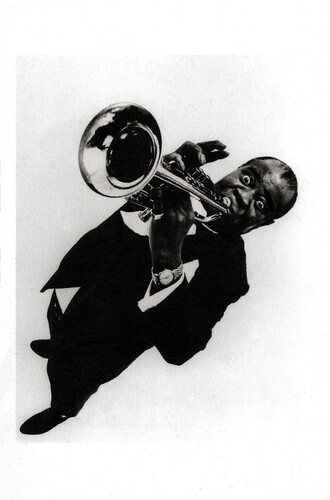
French postcard. Photo: Philippe Halsman / Magnum. Caption: The American jazzman Louis Armstrong, photographed in 1966.
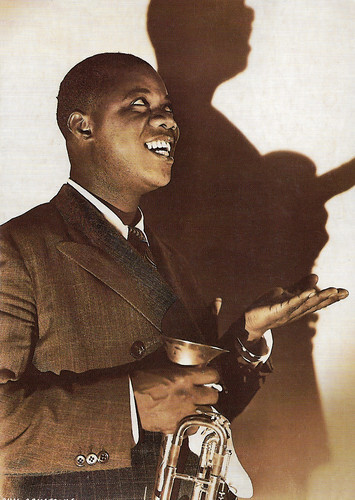
German postcard by Edition Tushita, Duisburg / Innenhafen, no. B 507. Photo: Tushita / Owa.
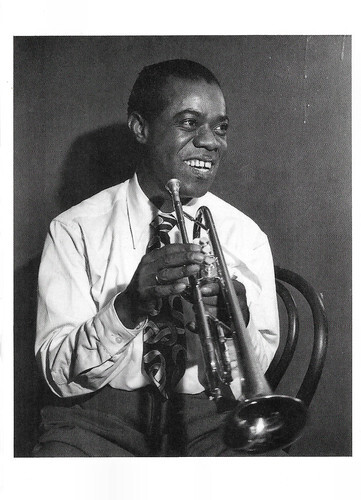
British postcard by Monochrome, London, 1988. Photo: William Gottlieb / DRP. Caption: Louis 'Satchmo' Armstrong.

American postcard by Fotofolio, NY, NY, no. M90. Photo: Photographer unidentified / Collection Ole Brask. Louis Armstrong and Billie Holiday on a publicity still for New Orleans (Arthur Lubin, 1947), the only time Billie Holiday performed in a feature film.
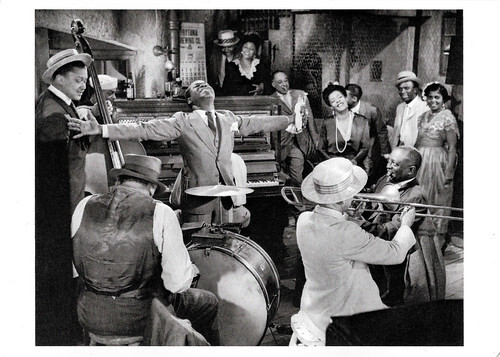
American postcard by Fotofolio, NY, NY, no. M100. Photo: Phil Stern. Louis Armstrong and Billie Holiday in New Orleans (Arthur Lubin, 1947). Caption: Louis Armstrong and Billie Holiday, Hollywood, 1949. (Sic, it must be 1947).
Born in the Battlefield
Louis Daniel Armstrong was born in New Orleans, Louisiana, in the Storyville District known as 'the Battlefield' in 1901. His parents were Mary Albert and William Armstrong. William abandoned the family shortly after, and Louis grew up poor in a single-parent household. He left school in the 5th grade to help support his family. He sang on street corners, sold newspapers and delivered coal. Louis was 13 when he celebrated New Year's Eve in 1912 by running out on the street and firing a blank from a pistol that belonged to the current man in his mother's life. He was arrested and placed in the Colored Waif's Home for boys. There, he learned to play the bugle, cornet and the clarinet and joined the home's brass band. Armstrong's first teacher, Peter Davis, taught him there to read music. After 18 months, Louis left the Home determined to become a musician.
The young Armstrong played in brass bands and riverboats in New Orleans, first on an excursion boat in September 1918. At 18, he got a job in the Kid Ory Band in New Orleans. Armstrong married Daisy Parker as his career as a musician developed. In 1922, he followed his mentor, Joe 'King' Oliver, to Chicago to play in the Creole Jazz Band. He made his first recordings with that band in 1923. While in Chicago, Armstrong networked with other jazz musicians, reconnecting with his friend, Bix Beiderbecke, and made new contacts, which included Hoagy Carmichael and Lil Hardin.
Lil was a graduate of Fisk University and an excellent pianist who could read, write and arrange music. She encouraged and enhanced Louis's career, and they married in 1924. Armstrong became very popular and one of the genre's most sought-after trumpeters. He travelled a great deal and spent considerable time in Chicago and New York. He first moved to the Big Apple in 1924 to join Fletcher Henderson's Orchestra. He stayed in New York for a while but moved back to Chicago in October of 1925.
Armstrong later went back to New York in 1929. He appeared on Broadway in 'Hot Chocolates', in which he introduced Fats Waller's 'Ain't Misbehavin'', his first popular song hit. During that time, some of his most important and successful work was accomplished with his Hot Fives and Hot Sevens Bands. Armstrong's interpretation of Hoagy Carmichael's 'Stardust' became one of the most successful versions of this song ever recorded, showcasing Armstrong's unique vocal sound and style and his innovative approach to singing songs that had already become standards. In 1931, Armstrong appeared in his first film, Ex-Flame. That year, Armstrong and Lil Hardin separated and later divorced in 1938.
Dale O'Connor at IMDb : "He made a tour of Europe in 1932. During a command performance for King George V, he forgot he had been told that performers were not to refer to members of the royal family while playing for them. Just before picking up his trumpet for a really hot number, he announced: 'This one's for you, Rex.'" After this Grand Tour of Europe, 'Satchmo' became Armstrong's nickname. A London music magazine editor had written erroneously 'Satchmo' in an article (Armstrong's nickname was 'Satchelmouth'), and the name stuck. In 1937, Armstrong substituted for Rudy Vallee on the CBS radio network and became the first African American to host a sponsored, national broadcast. After his divorce, Louis married Alpha Smith in 1938. While maintaining a vigorous work schedule, as well as living and travelling back and forth to Chicago and California, Armstrong moved back to New York in the late 1930s and later married Lucille Wilson in 1942.
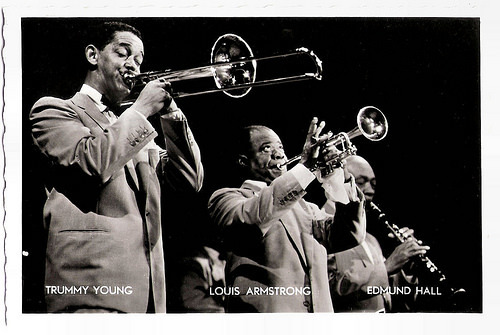
Dutch postcard by N.V. Int. Filmpers (I.F.P.), Amsterdam, no. 1035. Photo: Joel Elkins. Louis Armstrong in the 1955 version of the All Stars, with Trummy Young on trombone and vocals, and Edmond Hall on clarinet and vocals.
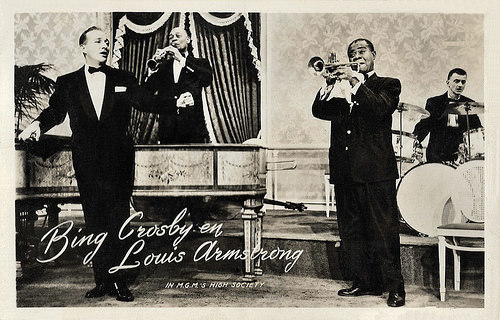
Dutch postcard by Uitg. Takken, Utrecht, no. 3024. Photo: MGM. Publicity still for High Society (Charles Walters, 1956) with Bing Crosby .
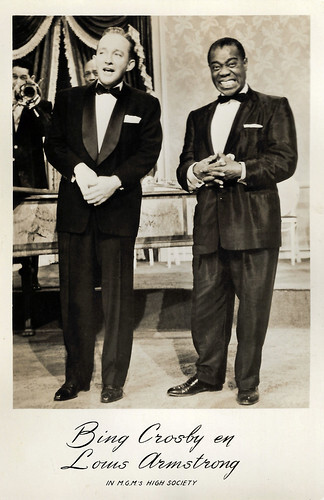
Dutch postcard by Uitg. Takken, Utrecht, no. 3014. Photo: MGM. Bing Crosby and Louis Armstrong in High Society (Charles Walters, 1956).
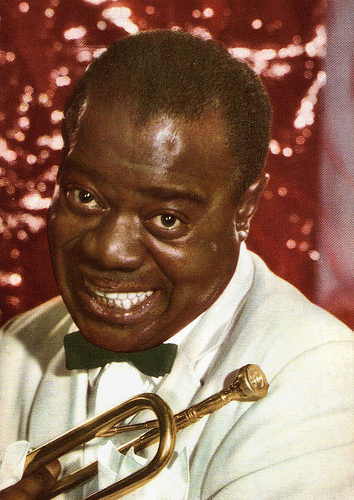
French postcard by Editions P.I., Paris, no. CK-289. Photo: Arthur Grimm / Ufa.
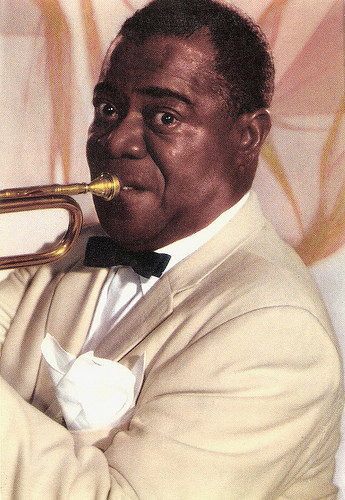
German postcard by ISV, no. H 37.
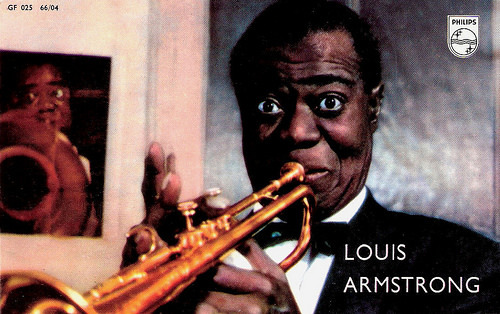
Dutch promotion card by Philips, no. GF 025 66/04.
One of the first truly popular African-American entertainers to 'cross over'
Louis Armstrong was also an influential singer, with his instantly recognisable gravelly voice. He demonstrated great mastery as an improviser, bending the lyrics and melody of a song for expressive purposes. He was also very skilled at scat singing. Although his career as a recording artist dates back to the 1920s, when he made now-classic recordings with Joe 'King' Oliver, Bessie Smith and Jimmie Rodgers, as well as his own Hot Five and Hot Seven groups, his biggest hits as a recording artist came comparatively late in his life. Armstrong had nineteen Top Ten hits, including 'When The Saints Go Marching In' (1938), 'Mack the Knife' (1955), 'Stompin' at the Savoy' (1956) with Ella Fitzgerald, and 'What a Wonderful World' (1967).
Armstrong's influence extended well beyond jazz, and by the end of his career in the 1960s, he was widely regarded as a profound influence on popular music in general. In 1964, Armstrong knocked The Beatles off the top of the Billboard Hot 100 chart with 'Hello, Dolly!', which gave the 63-year-old performer a U.S. record as the oldest artist to have a number one song. Armstrong appeared in more than a dozen Hollywood films, usually playing a bandleader or musician. He appeared with Bing Crosby in the musical Pennies from Heaven (Norman Z. MacLeod, 1936) and with Mae West in Every Day's a Holiday (A. Edward Sutherland, 1937).
In the innovative musical Cabin in the Sky (Vincente Minnelli, Busby Berkeley, 1943) featuring an all-star, all-black cast, Louis played 'The Trumpeter' opposite Ethel Waters and Lena Horne. In 1947, he played himself opposite Billie Holiday in New Orleans (Arthur Lubin, 1947), which chronicled the demise of the Storyville district and the ensuing exodus of musicians from New Orleans to Chicago. Armstrong also joined Danny Kaye and Virginia Mayo in the comedy A Song Is Born (Howard Hawks, 1948). The best parts of the film are the music scenes with Armstrong, Tommy Dorsey, Charlie Barnett, Lionel Hampton, and Benny Goodman, playing kick-arse Jazz. In The Glenn Miller Story (Anthony Mann, 1954), Armstrong jammed with Miller (James Stewart) and a few other noted musicians of the time.
His most familiar role was as the bandleader in the musical High Society (Charles Walters, 1956). He functions as a very partisan Greek Chorus, who tells you right up front who he's pulling for to win Grace Kelly, and he helps musically along the way, performing a duet with Bing Crosby . In The Five Pennies (Melville Shavelson, 1959), the story of the cornetist Red Nichols, Armstrong played himself as well as singing and playing several classic numbers. With leading actor Danny Kaye , Armstrong performed a duet of 'When the Saints Go Marching In', during which Kaye impersonated Armstrong. He also appeared in several European films, including the Italian-French musical Saluti e baci / The Road to Happiness (Maurice Labro, Giorgio Simonelli, 1953) with Georges Guétary , the German musical Die Nacht vor der Premiere / The Night before the Premiere (Georg Jacoby, 1959) with Marika Rökk , and the Danish musical Kærlighedens melodi / The melody of love (Bent Christensen, 1959) with Nina and Frederik .
Louis Armstrong was one of the first truly popular African-American entertainers to 'cross over', whose skin colour was secondary to his music in an America that was extremely racially divided at the time. He rarely publicly politicised his race, often to the dismay of fellow African Americans, but Armstrong was the only Black Jazz musician to publicly speak out against school segregation in 1957 during the Little Rock crisis. His artistry and personality allowed him access to the upper echelons of American society, then highly restricted for black men. Despite his fame, he remained a humble man and lived a simple life in a working-class neighbourhood Armstrong remained married to Lucille Wilson until he died in 1971, a month away from what would have been his 70th birthday on 4 August. Embittered by the treatment of blacks in his hometown of New Orleans, he chose to be buried in New York City at the Flushing Cemetery, not too far from his home in Corona, Queens. He left his entire estate to his beloved wife, who died in 1983. Armstrong wrote two autobiographies. His house in Corona, where Armstrong lived for almost 28 years, was declared a National Historic Landmark in 1977. Today, it is a museum where fans can check out his residence and its belongings as a citizen of New York City.
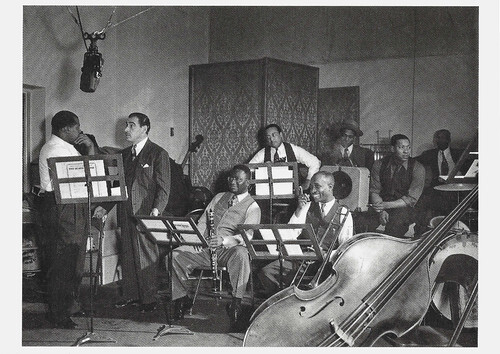
French postcard by Humour a la Carte, Paris, no. ST 258. Photo: Culver Pictures.
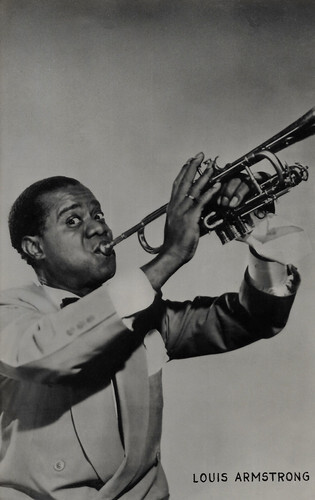
Belgian postcard in the Hot Club series by Edition John Prevot, Anvers (Antwerp), no. 19.
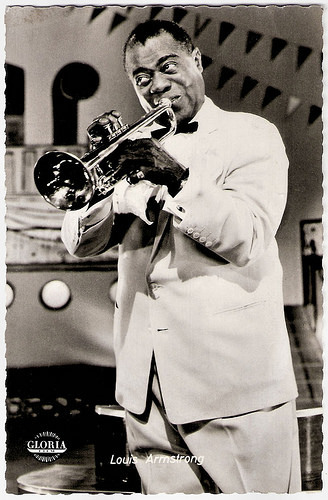
German postcard by Kolibri-Verlag, Minden/Westf., no. 765. no. CK-289. Photo: Alfa / Gloria / Kiebig. Publicity still for La Paloma (Paul Martin, 1959).
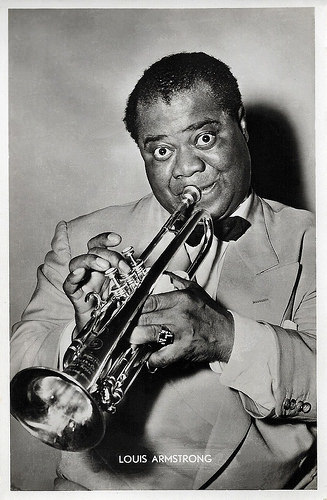
Vintage postcard, no. 111.
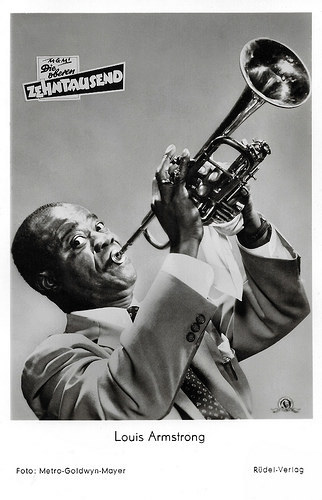
German postcard by Rüdel-Verlag, Hamburg-Bergedorf, no. 1988. Photo: MGM. Publicity still for High Society (Charles Walters, 1956). The German title of the film is Die oberen Zehntausend (The top ten thousand).
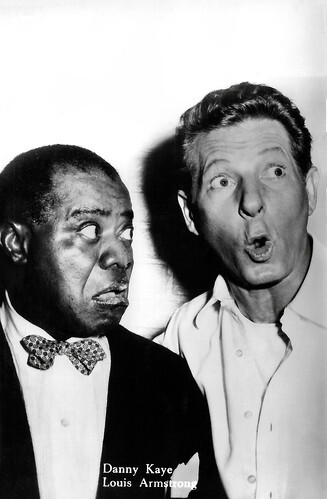
Dutch postcard by Gebr. Spanjersberg N.V., Rotterdam. Danny Kaye and Louis Armstrong in The Five Pennies (Melville Shavelson, 1959).
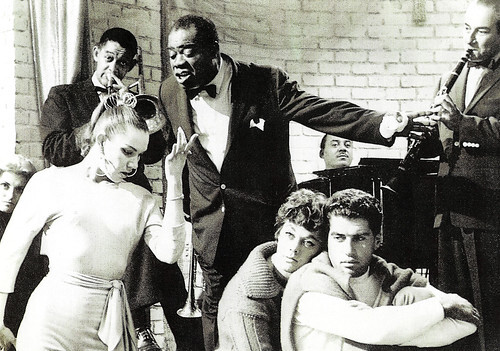
German postcard by Edition Tushita, no. B 515. Photo: AKG, Berlin / Tushita. Louis Armstrong in The Beat Generation (Charles F. Haas, 1959).
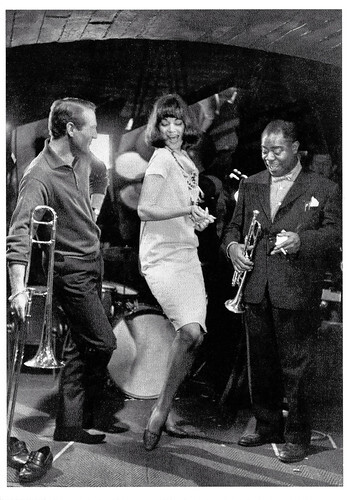
French postcard by Editions du Désastre, Paris, no. N105. Photo: Jack Nisberg. Paul Newman and Louis Armstrong in Paris Blues (Martin Ritt, 1961).
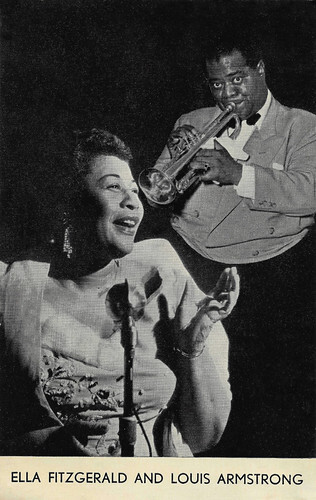
Dutch promotion card by Artone / Verve Records, Haarlem. Ella Fitzgerald and Louis Armstrong.
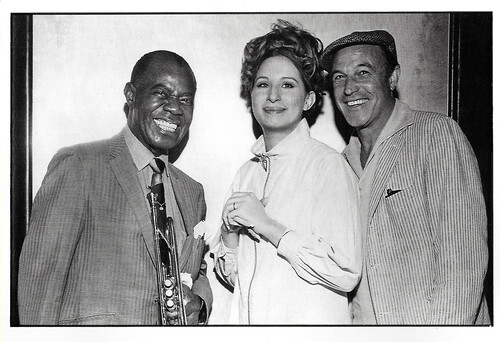
French postcard in the Entr'acte series by Éditions Asphodèle, Mâcon, no. 005/13. Collection: B. Courtel / D.R. Louis Armstrong, Barbra Streisand , and Gene Kelly on the set of Hello Dolly! (Gene Kelly, 1969). Caption: A moment of pause for Gene Kelly and his stars, Barbra Streisand and Louis Armstrong.
Sources: (IMDb), Louis Armstrong Educational Foundation, Wikipedia and .

French postcard. Photo: Philippe Halsman / Magnum. Caption: The American jazzman Louis Armstrong, photographed in 1966.

German postcard by Edition Tushita, Duisburg / Innenhafen, no. B 507. Photo: Tushita / Owa.

British postcard by Monochrome, London, 1988. Photo: William Gottlieb / DRP. Caption: Louis 'Satchmo' Armstrong.

American postcard by Fotofolio, NY, NY, no. M90. Photo: Photographer unidentified / Collection Ole Brask. Louis Armstrong and Billie Holiday on a publicity still for New Orleans (Arthur Lubin, 1947), the only time Billie Holiday performed in a feature film.

American postcard by Fotofolio, NY, NY, no. M100. Photo: Phil Stern. Louis Armstrong and Billie Holiday in New Orleans (Arthur Lubin, 1947). Caption: Louis Armstrong and Billie Holiday, Hollywood, 1949. (Sic, it must be 1947).
Born in the Battlefield
Louis Daniel Armstrong was born in New Orleans, Louisiana, in the Storyville District known as 'the Battlefield' in 1901. His parents were Mary Albert and William Armstrong. William abandoned the family shortly after, and Louis grew up poor in a single-parent household. He left school in the 5th grade to help support his family. He sang on street corners, sold newspapers and delivered coal. Louis was 13 when he celebrated New Year's Eve in 1912 by running out on the street and firing a blank from a pistol that belonged to the current man in his mother's life. He was arrested and placed in the Colored Waif's Home for boys. There, he learned to play the bugle, cornet and the clarinet and joined the home's brass band. Armstrong's first teacher, Peter Davis, taught him there to read music. After 18 months, Louis left the Home determined to become a musician.
The young Armstrong played in brass bands and riverboats in New Orleans, first on an excursion boat in September 1918. At 18, he got a job in the Kid Ory Band in New Orleans. Armstrong married Daisy Parker as his career as a musician developed. In 1922, he followed his mentor, Joe 'King' Oliver, to Chicago to play in the Creole Jazz Band. He made his first recordings with that band in 1923. While in Chicago, Armstrong networked with other jazz musicians, reconnecting with his friend, Bix Beiderbecke, and made new contacts, which included Hoagy Carmichael and Lil Hardin.
Lil was a graduate of Fisk University and an excellent pianist who could read, write and arrange music. She encouraged and enhanced Louis's career, and they married in 1924. Armstrong became very popular and one of the genre's most sought-after trumpeters. He travelled a great deal and spent considerable time in Chicago and New York. He first moved to the Big Apple in 1924 to join Fletcher Henderson's Orchestra. He stayed in New York for a while but moved back to Chicago in October of 1925.
Armstrong later went back to New York in 1929. He appeared on Broadway in 'Hot Chocolates', in which he introduced Fats Waller's 'Ain't Misbehavin'', his first popular song hit. During that time, some of his most important and successful work was accomplished with his Hot Fives and Hot Sevens Bands. Armstrong's interpretation of Hoagy Carmichael's 'Stardust' became one of the most successful versions of this song ever recorded, showcasing Armstrong's unique vocal sound and style and his innovative approach to singing songs that had already become standards. In 1931, Armstrong appeared in his first film, Ex-Flame. That year, Armstrong and Lil Hardin separated and later divorced in 1938.
Dale O'Connor at IMDb : "He made a tour of Europe in 1932. During a command performance for King George V, he forgot he had been told that performers were not to refer to members of the royal family while playing for them. Just before picking up his trumpet for a really hot number, he announced: 'This one's for you, Rex.'" After this Grand Tour of Europe, 'Satchmo' became Armstrong's nickname. A London music magazine editor had written erroneously 'Satchmo' in an article (Armstrong's nickname was 'Satchelmouth'), and the name stuck. In 1937, Armstrong substituted for Rudy Vallee on the CBS radio network and became the first African American to host a sponsored, national broadcast. After his divorce, Louis married Alpha Smith in 1938. While maintaining a vigorous work schedule, as well as living and travelling back and forth to Chicago and California, Armstrong moved back to New York in the late 1930s and later married Lucille Wilson in 1942.

Dutch postcard by N.V. Int. Filmpers (I.F.P.), Amsterdam, no. 1035. Photo: Joel Elkins. Louis Armstrong in the 1955 version of the All Stars, with Trummy Young on trombone and vocals, and Edmond Hall on clarinet and vocals.

Dutch postcard by Uitg. Takken, Utrecht, no. 3024. Photo: MGM. Publicity still for High Society (Charles Walters, 1956) with Bing Crosby .

Dutch postcard by Uitg. Takken, Utrecht, no. 3014. Photo: MGM. Bing Crosby and Louis Armstrong in High Society (Charles Walters, 1956).

French postcard by Editions P.I., Paris, no. CK-289. Photo: Arthur Grimm / Ufa.

German postcard by ISV, no. H 37.

Dutch promotion card by Philips, no. GF 025 66/04.
One of the first truly popular African-American entertainers to 'cross over'
Louis Armstrong was also an influential singer, with his instantly recognisable gravelly voice. He demonstrated great mastery as an improviser, bending the lyrics and melody of a song for expressive purposes. He was also very skilled at scat singing. Although his career as a recording artist dates back to the 1920s, when he made now-classic recordings with Joe 'King' Oliver, Bessie Smith and Jimmie Rodgers, as well as his own Hot Five and Hot Seven groups, his biggest hits as a recording artist came comparatively late in his life. Armstrong had nineteen Top Ten hits, including 'When The Saints Go Marching In' (1938), 'Mack the Knife' (1955), 'Stompin' at the Savoy' (1956) with Ella Fitzgerald, and 'What a Wonderful World' (1967).
Armstrong's influence extended well beyond jazz, and by the end of his career in the 1960s, he was widely regarded as a profound influence on popular music in general. In 1964, Armstrong knocked The Beatles off the top of the Billboard Hot 100 chart with 'Hello, Dolly!', which gave the 63-year-old performer a U.S. record as the oldest artist to have a number one song. Armstrong appeared in more than a dozen Hollywood films, usually playing a bandleader or musician. He appeared with Bing Crosby in the musical Pennies from Heaven (Norman Z. MacLeod, 1936) and with Mae West in Every Day's a Holiday (A. Edward Sutherland, 1937).
In the innovative musical Cabin in the Sky (Vincente Minnelli, Busby Berkeley, 1943) featuring an all-star, all-black cast, Louis played 'The Trumpeter' opposite Ethel Waters and Lena Horne. In 1947, he played himself opposite Billie Holiday in New Orleans (Arthur Lubin, 1947), which chronicled the demise of the Storyville district and the ensuing exodus of musicians from New Orleans to Chicago. Armstrong also joined Danny Kaye and Virginia Mayo in the comedy A Song Is Born (Howard Hawks, 1948). The best parts of the film are the music scenes with Armstrong, Tommy Dorsey, Charlie Barnett, Lionel Hampton, and Benny Goodman, playing kick-arse Jazz. In The Glenn Miller Story (Anthony Mann, 1954), Armstrong jammed with Miller (James Stewart) and a few other noted musicians of the time.
His most familiar role was as the bandleader in the musical High Society (Charles Walters, 1956). He functions as a very partisan Greek Chorus, who tells you right up front who he's pulling for to win Grace Kelly, and he helps musically along the way, performing a duet with Bing Crosby . In The Five Pennies (Melville Shavelson, 1959), the story of the cornetist Red Nichols, Armstrong played himself as well as singing and playing several classic numbers. With leading actor Danny Kaye , Armstrong performed a duet of 'When the Saints Go Marching In', during which Kaye impersonated Armstrong. He also appeared in several European films, including the Italian-French musical Saluti e baci / The Road to Happiness (Maurice Labro, Giorgio Simonelli, 1953) with Georges Guétary , the German musical Die Nacht vor der Premiere / The Night before the Premiere (Georg Jacoby, 1959) with Marika Rökk , and the Danish musical Kærlighedens melodi / The melody of love (Bent Christensen, 1959) with Nina and Frederik .
Louis Armstrong was one of the first truly popular African-American entertainers to 'cross over', whose skin colour was secondary to his music in an America that was extremely racially divided at the time. He rarely publicly politicised his race, often to the dismay of fellow African Americans, but Armstrong was the only Black Jazz musician to publicly speak out against school segregation in 1957 during the Little Rock crisis. His artistry and personality allowed him access to the upper echelons of American society, then highly restricted for black men. Despite his fame, he remained a humble man and lived a simple life in a working-class neighbourhood Armstrong remained married to Lucille Wilson until he died in 1971, a month away from what would have been his 70th birthday on 4 August. Embittered by the treatment of blacks in his hometown of New Orleans, he chose to be buried in New York City at the Flushing Cemetery, not too far from his home in Corona, Queens. He left his entire estate to his beloved wife, who died in 1983. Armstrong wrote two autobiographies. His house in Corona, where Armstrong lived for almost 28 years, was declared a National Historic Landmark in 1977. Today, it is a museum where fans can check out his residence and its belongings as a citizen of New York City.

French postcard by Humour a la Carte, Paris, no. ST 258. Photo: Culver Pictures.

Belgian postcard in the Hot Club series by Edition John Prevot, Anvers (Antwerp), no. 19.

German postcard by Kolibri-Verlag, Minden/Westf., no. 765. no. CK-289. Photo: Alfa / Gloria / Kiebig. Publicity still for La Paloma (Paul Martin, 1959).

Vintage postcard, no. 111.

German postcard by Rüdel-Verlag, Hamburg-Bergedorf, no. 1988. Photo: MGM. Publicity still for High Society (Charles Walters, 1956). The German title of the film is Die oberen Zehntausend (The top ten thousand).

Dutch postcard by Gebr. Spanjersberg N.V., Rotterdam. Danny Kaye and Louis Armstrong in The Five Pennies (Melville Shavelson, 1959).

German postcard by Edition Tushita, no. B 515. Photo: AKG, Berlin / Tushita. Louis Armstrong in The Beat Generation (Charles F. Haas, 1959).

French postcard by Editions du Désastre, Paris, no. N105. Photo: Jack Nisberg. Paul Newman and Louis Armstrong in Paris Blues (Martin Ritt, 1961).

Dutch promotion card by Artone / Verve Records, Haarlem. Ella Fitzgerald and Louis Armstrong.

French postcard in the Entr'acte series by Éditions Asphodèle, Mâcon, no. 005/13. Collection: B. Courtel / D.R. Louis Armstrong, Barbra Streisand , and Gene Kelly on the set of Hello Dolly! (Gene Kelly, 1969). Caption: A moment of pause for Gene Kelly and his stars, Barbra Streisand and Louis Armstrong.
Sources: (IMDb), Louis Armstrong Educational Foundation, Wikipedia and .
Published on September 07, 2025 22:00
September 6, 2025
Mary Odette
Mary Odette (1901-1987) or Odette Goimbault was a French actress who starred in British, German and French silent films. She also appeared in several Dutch films produced by the Hollandia Filmfabriek, which made her a star in the Netherlands. In Germany, she also worked with Dutch director Jaap Speyer.
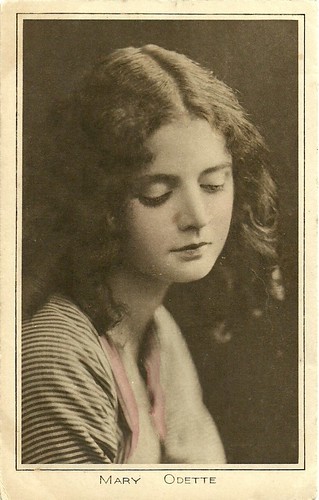
British postcard by Pictures Ltd., London, in the Pictures Portrait Gallery series, no. 49. Photo: Claude Harris.
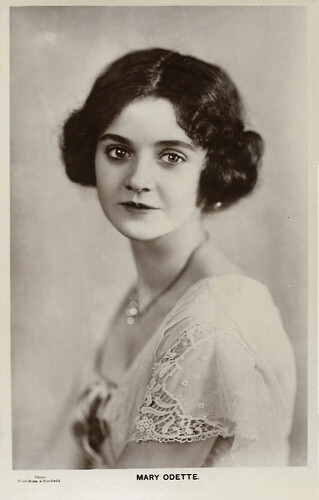
British postcard in the Picturegoer Series, no. 190. Photo: Foulsham & Banfield. Collection: Marlene Pilaete.
Hollandia star
Mary Odette was born Odette Goimbault on 10 August 1901 in Dieppe, France. When she was still a child, her parents moved with her to Britain. As a teenager, she debuted on the London stage and started in British cinema under her real name, in the film Cynthia in the Wilderness (Harold Weston, 1916), starring Eve Balfour.
From 1918, she had an intense career in British silent cinema, until 1919, still under her own name, and often in the female lead. Her British films included The Greatest Wish in the World (Maurice Elvey, 1918), Spinner O’Dreams (Wilfred Noy, 1918), The Wages of Sin (Arrigo Bocchi, 1918), and Peace, Perfect Peace (Arrigo Bocchi, 1918), released just after the armistice ending the First World War.
In the latter film, Goimbault’s character had the name of Marie Odette, a name she started to use as her own from 1919 on, first with Castle of Dreams (Wilfred Noy, 1919). In 1920, she played opposite the reputed French actor Henry Krauss in Enchantment (Einar Bruun, 1920), also with Eric Barclay.
The same year, she got an offer to act in the Netherlands at the company Hollandia, which was making co-productions with Britain. Odette starred here in Zoo als ik ben / As God Made Her (Maurits Binger, B.E. Doxat-Pratt, 1920), and De vrouw van de minister / John Heriott’s Wife (Maurits Binger, B.E. Doxat-Pratt, 1920). In both films, she co-starred with Adelqui Migliar , Lola Cornero and Henry Victor. One of the other actresses in the cast was the former Dutch diva Annie Bos , named Anna Bosilova here.
Mary Odette rose to star status in the Netherlands, and she also managed to convince British actress Elsie Cohen to come over and work for Hollandia. Yet, she herself soon returned to Britain where she continued to act in films mainly directed by Kenelm Foss, but also in e.g. The Hypocrites (Charles Giblyn, 1923).
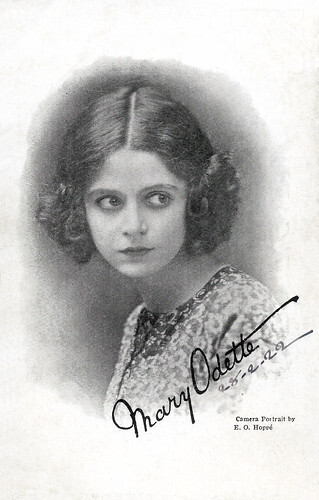
British postcard. Photo: E.O. Hoppé. Sent by mail in 1922.
Jaap Speyer
In 1923, Mary Odette went to Berlin, where she acted with Stewart Rome in Im Schatten der Moschee / In the Shadow of the Mosque (Walter Richard Hall, 1923). Then she returned to Holland to act in De leeuw en de muis / The Lion’s Mouse (Oscar Apfel, 1923). The film co-starred Marguerite Marsh, a sister of the famous American actress Mae Marsh , who died at a very young age because of pneumonia.
Around the same time, Odette acted in France in the period piece Kean / Kean ou désordre et génie (1924) by Alexandre Volkoff. Ivan Mozzhukhin starred as the legendary British actor Edmund Kean.
In 1925, Odette played in Berlin in Max Mack ’s Vater Voss / Father Voss, with Stewart Rome . She also acted in the British-German co-production She (Leander De Cordova, 1925), starring Betty Blythe and Carlyle Blackwell. This H. Rider Haggard adaptation was shot in a German zeppelin hall.
Odette went to act in Germany in Elegantes Pack / Elegant suit (1925) by Dutch director Jaap Speyer, opposite Eugen Klöpfer , Ralph Arthur Roberts and Hanni Weisse , and in Die Moral der Gasse (Jaap Speyer 1925), with Werner Krauss , Ernst Hofmann and Evi Eva .
Her last silent films were Emerald of the East (Jean de Kucharski, 1928), and Celle qui domine (Carmine Gallone, Léon Mathot, 1929), starring Léon Mathot himself and Soava Gallone . At the end of the silent era, Odette didn’t manage to switch to sound cinema and retired from screen acting. She married a journalist, first moved with him to India, then returned to Britain. Mary Odette died in Stockport, UK, in 1987. She was 85.
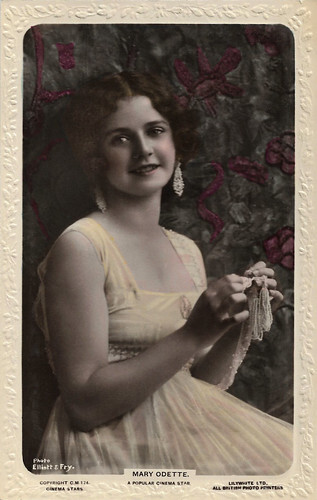
British postcard in the Cinema Stars Series by Lilywhite, no. C.M. 174. Photo: Elliott & Fry. Caption: Mary Odette, a popular cinema star.
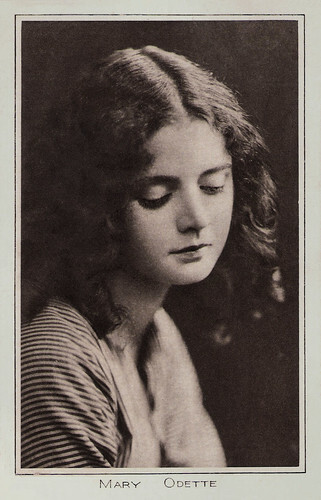
British postcard in the Pictures Portrait Gallery, no. 49, by Pictures Ltd., London. Photo: Claude Harris.
Sources: Cineressources (French), Filmportal.de, Wikipedia (Dutch, German, English and French), and .
Thanks to Marlene Pilate for the additional information.

British postcard by Pictures Ltd., London, in the Pictures Portrait Gallery series, no. 49. Photo: Claude Harris.

British postcard in the Picturegoer Series, no. 190. Photo: Foulsham & Banfield. Collection: Marlene Pilaete.
Hollandia star
Mary Odette was born Odette Goimbault on 10 August 1901 in Dieppe, France. When she was still a child, her parents moved with her to Britain. As a teenager, she debuted on the London stage and started in British cinema under her real name, in the film Cynthia in the Wilderness (Harold Weston, 1916), starring Eve Balfour.
From 1918, she had an intense career in British silent cinema, until 1919, still under her own name, and often in the female lead. Her British films included The Greatest Wish in the World (Maurice Elvey, 1918), Spinner O’Dreams (Wilfred Noy, 1918), The Wages of Sin (Arrigo Bocchi, 1918), and Peace, Perfect Peace (Arrigo Bocchi, 1918), released just after the armistice ending the First World War.
In the latter film, Goimbault’s character had the name of Marie Odette, a name she started to use as her own from 1919 on, first with Castle of Dreams (Wilfred Noy, 1919). In 1920, she played opposite the reputed French actor Henry Krauss in Enchantment (Einar Bruun, 1920), also with Eric Barclay.
The same year, she got an offer to act in the Netherlands at the company Hollandia, which was making co-productions with Britain. Odette starred here in Zoo als ik ben / As God Made Her (Maurits Binger, B.E. Doxat-Pratt, 1920), and De vrouw van de minister / John Heriott’s Wife (Maurits Binger, B.E. Doxat-Pratt, 1920). In both films, she co-starred with Adelqui Migliar , Lola Cornero and Henry Victor. One of the other actresses in the cast was the former Dutch diva Annie Bos , named Anna Bosilova here.
Mary Odette rose to star status in the Netherlands, and she also managed to convince British actress Elsie Cohen to come over and work for Hollandia. Yet, she herself soon returned to Britain where she continued to act in films mainly directed by Kenelm Foss, but also in e.g. The Hypocrites (Charles Giblyn, 1923).

British postcard. Photo: E.O. Hoppé. Sent by mail in 1922.
Jaap Speyer
In 1923, Mary Odette went to Berlin, where she acted with Stewart Rome in Im Schatten der Moschee / In the Shadow of the Mosque (Walter Richard Hall, 1923). Then she returned to Holland to act in De leeuw en de muis / The Lion’s Mouse (Oscar Apfel, 1923). The film co-starred Marguerite Marsh, a sister of the famous American actress Mae Marsh , who died at a very young age because of pneumonia.
Around the same time, Odette acted in France in the period piece Kean / Kean ou désordre et génie (1924) by Alexandre Volkoff. Ivan Mozzhukhin starred as the legendary British actor Edmund Kean.
In 1925, Odette played in Berlin in Max Mack ’s Vater Voss / Father Voss, with Stewart Rome . She also acted in the British-German co-production She (Leander De Cordova, 1925), starring Betty Blythe and Carlyle Blackwell. This H. Rider Haggard adaptation was shot in a German zeppelin hall.
Odette went to act in Germany in Elegantes Pack / Elegant suit (1925) by Dutch director Jaap Speyer, opposite Eugen Klöpfer , Ralph Arthur Roberts and Hanni Weisse , and in Die Moral der Gasse (Jaap Speyer 1925), with Werner Krauss , Ernst Hofmann and Evi Eva .
Her last silent films were Emerald of the East (Jean de Kucharski, 1928), and Celle qui domine (Carmine Gallone, Léon Mathot, 1929), starring Léon Mathot himself and Soava Gallone . At the end of the silent era, Odette didn’t manage to switch to sound cinema and retired from screen acting. She married a journalist, first moved with him to India, then returned to Britain. Mary Odette died in Stockport, UK, in 1987. She was 85.

British postcard in the Cinema Stars Series by Lilywhite, no. C.M. 174. Photo: Elliott & Fry. Caption: Mary Odette, a popular cinema star.

British postcard in the Pictures Portrait Gallery, no. 49, by Pictures Ltd., London. Photo: Claude Harris.
Sources: Cineressources (French), Filmportal.de, Wikipedia (Dutch, German, English and French), and .
Thanks to Marlene Pilate for the additional information.
Published on September 06, 2025 22:00
September 5, 2025
Bully Buhlan
Bully Buhlan (1924-1982) was a German Jazz and Schlager singer, pianist, composer and actor. He was successful in Germany after World War II and in the early 1950s. He twice reached second place in the West German charts. During his career, Buhlan performed in more than 30 film and TV productions.
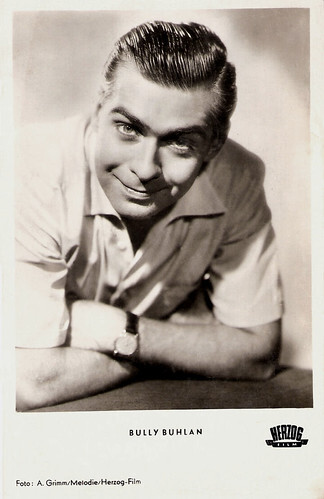
West German postcard by Kunst und Bild, Berlinb, no. A 645. Photo: Melodie / Herzog-Film / Arthur Grimm. Bully Buhlan in Heimweh nach dir / Homesick for you (Robert A. Stemmle, 1952).
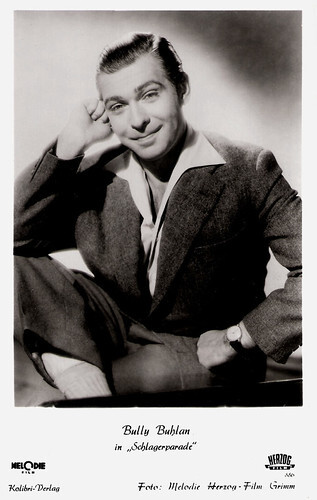
West German postcard by Kolibri-Verlag, no. 886. Photo: Melodie / Herzog-Film / Arthur Grimm. Bully Buhlan in Schlagerparade / Hit Parade (Erik Ode, 1953).
Chattanooga Choo Choo
Bully Buhlan was born Hans-Joachim Buhlan in Berlin-Lichterfelde, in 1924. He studied law for some time and was also active as a pianist. He gave swing performances in well-known venues such as the Groschenkeller and Café Leon.
In 1945, the leader of the Radio Berlin Tanzorchester, Michael Jary, brought him to his orchestra, and because Buhlan could sing so well, he became the singer there. He was one of the first artists to start making records for the record label Amiga, founded in 1947.
For the label, he recorded eight singles. His biggest success was a German-language version of 'Chattanooga Choo Choo', sung with Peter Rebhuhn under the title ‘Kötzschenbroda-Express’.
In 1948, Buhlan switched from Amiga, which was controlled by the Soviet occupying forces, to the Western Berlin-based label Odeon, for which he recorded three singles, including 'Gib mir einen Kuß durchs Telefon'. Three singles for Telefunken followed in 1949, after which he signed a multi-year contract with Germany's biggest record company, Polydor.
In the early years, Buhlan's signature singles like 'Ham‘ se nich’ ‘ne Braut für mich' (1951) emerged. When the first hit parade started in Germany in late 1953, Buhlan was listed on it. In 1954, his song 'Angelika' reached 21st place.
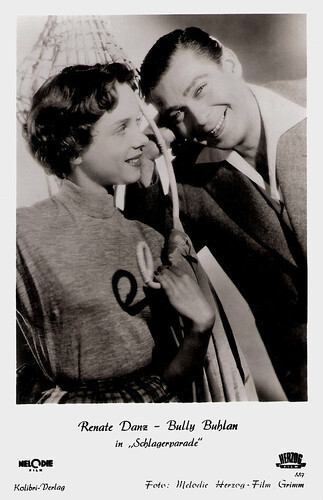
West German postcard by Kolibri-Verlag, no. 887. Photo: Melodie / Herzog-Film / Arthur Grimm. Renate Danz and Bully Buhlan in Schlagerparade / Hit Parade (Erik Ode, 1953).
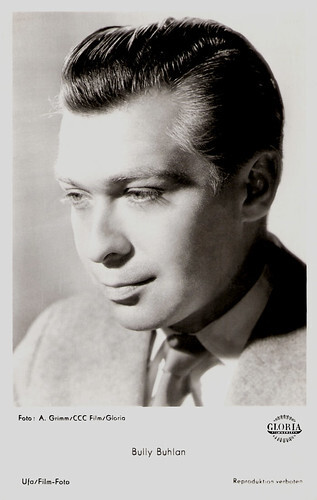
West German postcard by Ufa/Film-Foto, Berlin-Tempelhof, no. FK 1127. Photo: Arthur Grimm / CCC-Film / Gloria. Bully Buhlan in Die große Starparade / The Big Star Parade (Paul Martin, 1954).
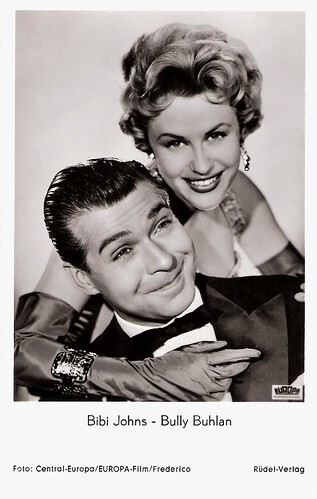
German postcard by F.J. Rüdel, Hamburg-Bergedorf, no. 1313. Photo: Central-Europa/Europa/Film/Frederico. Bibi Johns and Bully Buhlan in Ball im Savoy/Ball at the Savoy (Paul Martin, 1955).
The typical friendly 'Berliner Junge'
Bully Buhlan was also successful as an actor. He appeared in such light entertainment films as Sag' die Wahrheit / Tell the Truth (Helmut Weiss, 1946) starring Gustav Fröhlich, Königin der Arena / Queen of the Arena (Rolf Meyer, 1952) with Maria Litto, and Die große Starparade / The Big Star Parade (Paul Martin, 1954).
In 1953, he had a leading role in the romantic comedy Das singende hotel / The Singing Hotel (Géza von Cziffra, 1953) opposite Rudolf Platte . For Polydor, Buhlan recorded several duets with singer Rita Paul and also with Mona Baptiste. Their song 'Es liegt was in der Luft' was Buhlan's biggest hit and reached second place in 1954.
In total, Buhlan reached the German charts with five singles, two of which reached second place: 'Ich möcht auf deiner Hochzeit tanzen' also reached second place. As the typical friendly 'Berliner Junge', Buhlan was particularly popular with Berlin audiences with his Berlin-related songs, such as 'Ich hab' noch einen Koffer in Berlin' (1951), 'Ja der Kurfürstendamm' (1961) and 'Das Lied von der Krummen Lanke' (1961). In the 1960s, he worked several times with radio station RIAS, but recordings of that collaboration did not appear on the album.
At the time, Buhlan's popularity outside Berlin was waning, his records were no longer hits, and Polydor lost interest in the singer. A move to Philips yielded one record, 'Polly-Wolly-Holiday' (1963), but after that, Buhlan's recording career was over. He still appeared on TV until the early 1970s. His last TV film was the comedy Glückspilze / Lucky Ones (Thomas Engel, 1971), starring Christian Wolff and Loni von Friedl .
A comeback at the end of that decade yielded nothing. After an appearance in the TV production Ein kleines Glück auf allen Wegen / A Little Happiness Along the Way (Ekkehard Böhmer, 1980), he planned a tour of Germany with Bibi Johns and his former singing partner Mona Baptiste, but it never materialised: in 1982, the singer died of a heart attack in West Berlin. He found his final resting place at Berlin's Dahlem Forest Cemetery. Bully Buhlan was married to Elisa Charlotte Bergs from 1950 till she died in 1971. They had two children, Sabine Buhlan and Joachim Buhlan.

West German postcard by Kolibri-Verlag G.m.b. H., Minden-Westf., no. 1980. Photo: Real Film / Europa / Von Mindszenty. Bully Buhlan in Ich und meine Schwiegersöhne / Me and My Sons-in-law (Georg Jacoby, 1956).
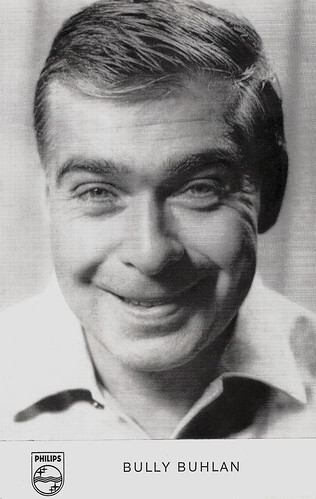
West German promotion card by Philips. The card promoted a record with 'Polly-Wolly-Holiday' (1963).
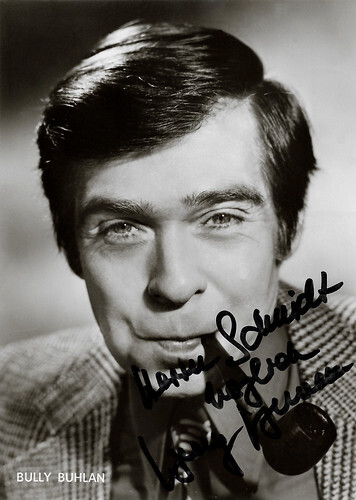
West German autograph card. Photo: W. Hegge, Berlin.
Sources: Wikipedia (Dutch, German and English) and .

West German postcard by Kunst und Bild, Berlinb, no. A 645. Photo: Melodie / Herzog-Film / Arthur Grimm. Bully Buhlan in Heimweh nach dir / Homesick for you (Robert A. Stemmle, 1952).

West German postcard by Kolibri-Verlag, no. 886. Photo: Melodie / Herzog-Film / Arthur Grimm. Bully Buhlan in Schlagerparade / Hit Parade (Erik Ode, 1953).
Chattanooga Choo Choo
Bully Buhlan was born Hans-Joachim Buhlan in Berlin-Lichterfelde, in 1924. He studied law for some time and was also active as a pianist. He gave swing performances in well-known venues such as the Groschenkeller and Café Leon.
In 1945, the leader of the Radio Berlin Tanzorchester, Michael Jary, brought him to his orchestra, and because Buhlan could sing so well, he became the singer there. He was one of the first artists to start making records for the record label Amiga, founded in 1947.
For the label, he recorded eight singles. His biggest success was a German-language version of 'Chattanooga Choo Choo', sung with Peter Rebhuhn under the title ‘Kötzschenbroda-Express’.
In 1948, Buhlan switched from Amiga, which was controlled by the Soviet occupying forces, to the Western Berlin-based label Odeon, for which he recorded three singles, including 'Gib mir einen Kuß durchs Telefon'. Three singles for Telefunken followed in 1949, after which he signed a multi-year contract with Germany's biggest record company, Polydor.
In the early years, Buhlan's signature singles like 'Ham‘ se nich’ ‘ne Braut für mich' (1951) emerged. When the first hit parade started in Germany in late 1953, Buhlan was listed on it. In 1954, his song 'Angelika' reached 21st place.

West German postcard by Kolibri-Verlag, no. 887. Photo: Melodie / Herzog-Film / Arthur Grimm. Renate Danz and Bully Buhlan in Schlagerparade / Hit Parade (Erik Ode, 1953).

West German postcard by Ufa/Film-Foto, Berlin-Tempelhof, no. FK 1127. Photo: Arthur Grimm / CCC-Film / Gloria. Bully Buhlan in Die große Starparade / The Big Star Parade (Paul Martin, 1954).

German postcard by F.J. Rüdel, Hamburg-Bergedorf, no. 1313. Photo: Central-Europa/Europa/Film/Frederico. Bibi Johns and Bully Buhlan in Ball im Savoy/Ball at the Savoy (Paul Martin, 1955).
The typical friendly 'Berliner Junge'
Bully Buhlan was also successful as an actor. He appeared in such light entertainment films as Sag' die Wahrheit / Tell the Truth (Helmut Weiss, 1946) starring Gustav Fröhlich, Königin der Arena / Queen of the Arena (Rolf Meyer, 1952) with Maria Litto, and Die große Starparade / The Big Star Parade (Paul Martin, 1954).
In 1953, he had a leading role in the romantic comedy Das singende hotel / The Singing Hotel (Géza von Cziffra, 1953) opposite Rudolf Platte . For Polydor, Buhlan recorded several duets with singer Rita Paul and also with Mona Baptiste. Their song 'Es liegt was in der Luft' was Buhlan's biggest hit and reached second place in 1954.
In total, Buhlan reached the German charts with five singles, two of which reached second place: 'Ich möcht auf deiner Hochzeit tanzen' also reached second place. As the typical friendly 'Berliner Junge', Buhlan was particularly popular with Berlin audiences with his Berlin-related songs, such as 'Ich hab' noch einen Koffer in Berlin' (1951), 'Ja der Kurfürstendamm' (1961) and 'Das Lied von der Krummen Lanke' (1961). In the 1960s, he worked several times with radio station RIAS, but recordings of that collaboration did not appear on the album.
At the time, Buhlan's popularity outside Berlin was waning, his records were no longer hits, and Polydor lost interest in the singer. A move to Philips yielded one record, 'Polly-Wolly-Holiday' (1963), but after that, Buhlan's recording career was over. He still appeared on TV until the early 1970s. His last TV film was the comedy Glückspilze / Lucky Ones (Thomas Engel, 1971), starring Christian Wolff and Loni von Friedl .
A comeback at the end of that decade yielded nothing. After an appearance in the TV production Ein kleines Glück auf allen Wegen / A Little Happiness Along the Way (Ekkehard Böhmer, 1980), he planned a tour of Germany with Bibi Johns and his former singing partner Mona Baptiste, but it never materialised: in 1982, the singer died of a heart attack in West Berlin. He found his final resting place at Berlin's Dahlem Forest Cemetery. Bully Buhlan was married to Elisa Charlotte Bergs from 1950 till she died in 1971. They had two children, Sabine Buhlan and Joachim Buhlan.

West German postcard by Kolibri-Verlag G.m.b. H., Minden-Westf., no. 1980. Photo: Real Film / Europa / Von Mindszenty. Bully Buhlan in Ich und meine Schwiegersöhne / Me and My Sons-in-law (Georg Jacoby, 1956).

West German promotion card by Philips. The card promoted a record with 'Polly-Wolly-Holiday' (1963).

West German autograph card. Photo: W. Hegge, Berlin.
Sources: Wikipedia (Dutch, German and English) and .
Published on September 05, 2025 22:00
September 4, 2025
All That Jazz
Jazz music and cinema have had an intriguing relationship over the years. Many great films prominently feature jazz soundtracks or jazz performers. Some jazz musicians even became film stars, like Harry James, Louis Armstrong and Sarah Vaughan. Jazz greats like Peggy Lee and Miles Davis made music for films and thus shaped film classics. This month, EFSP will post regularly on Jazz stars and their films. The idea to explore Jazz and cinema a bit came about when I found this series of 10 little Dutch collector cards, with portraits of international (jazz) musicians of the late 1950s, some of whom have also performed in films.

Dutch collector card, no. 15.
American actress and singer Pearl Bailey (1918-1990) began her singing career in nightclubs during the 1930s. She made her film debut with Variety Girl (George Marshall, 1947), and as a singer, she scored a big hit in 1952 with her version of 'Takes Two to Tango'. She played Frankie in Carmen Jones (Otto Preminger, 1954) with Dorothy Dandridge and Harry Belafonte. Her version of 'Beat Out That Rhythm on the Drum' was seen as the highlight of the film. She also starred in St. Louis Blues (Allen Resiner, 1958) opposite Nat King Cole, and featured as Maria in Porgy and Bess (Otto Preminger, 1959), along with Sidney Poitier and Dorothy Dandridge. Bailey received a Tony Award for her role in a special performance of 'Hello, Dolly!', with exclusively African-American actors.
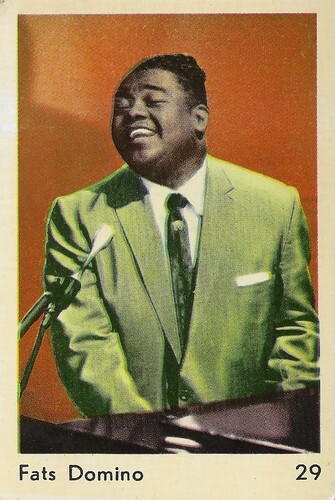
Dutch collector card, no. 29.
American rock and roll pianist and singer-songwriter Antoine 'Fats' Domino Jr. (1928-2017) was best known for his songs, 'Ain't That A Shame' and 'Blueberry Hill'. He was inspired by boogie-woogie pianists like Meade Lux Lewis and singers like Louis Jordan. In 1946, Domino started playing piano with bandleader Billy Diamond, who nicknamed Domino ‘Fats’ because of his big appetite. His million-selling debut single, 'The Fat Man', is credited by some as the first ever rock and roll record. His style was based on traditional rhythm and blues ensembles of bass, piano, electric guitar, drums, and saxophone. Domino released five gold (million-copy-selling) records before 1955, and had 35 Top 40 American hits. He was one of the most influential rock and roll performers of the 1950s and 1960s. During the 1950s, Fats Domino performed in such films as Shake, Rattle & Rock! (Edward L. Cahn, 1956) with Mike Connors, The Girl Can't Help It (Frank Tashlin, 1956) with Jayne Mansfield, and The Big Beat (Will Cowan, 1958).
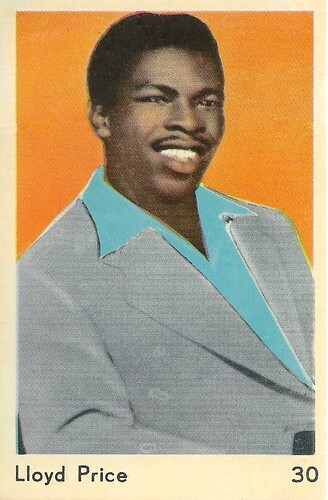
Dutch collector card, no. 30.
Lloyd Price (1933-2021) was an American R&B and rock 'n' roll singer. He was known as 'Mr. Personality' after his million-selling hit, 'Personality' (1959). Although most of Price's hits occurred in the late 1950s and early 1960s, he had his first hit in 1952 with 'Lawdy Miss Clawdy', which became a major R&B hit. However, his budding career came to a quick halt in 1954 when he was drafted into the army and was sent to Korea. Because of his musical background, though, he was placed into the Special Services (entertainment) branch, where he was put in charge of a large dance band that played 'Swing' music to entertain the troops. It was here that Price got the idea for what was to become his trademark style: combining a lush, full orchestra with the grittier, rawer tempos and vocals of R&B. Lloyd Price was inducted into the Rock and Roll Hall of Fame in 1998.
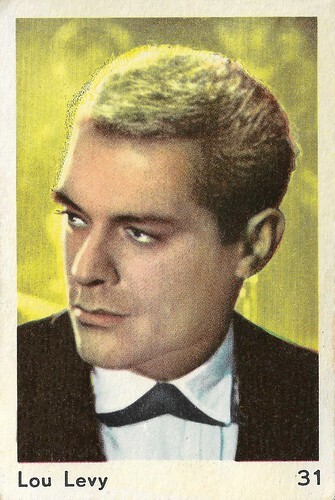
Dutch collector card, no. 31.
Lou Levy (1928-2001) counts as one of the leading jazz pianists of the 20th century. He started on piano when he was 12. His chief influences were Art Tatum and Bud Powell. At the end of the 1940s, he first attracted attention as a pianist for Georgie Auld, Boyd Raeburn and Chubby Jackson's bebop band, with whom he also toured Europe. In 1948, he joined Woody Herman's orchestra for a while. He also played with Sarah Vaughan, Tommy Dorsey, and Flip Phillips. Levy gained a strong reputation as a fine accompanist to singers, working with Peggy Lee (on and off during 1955-1973), Ella Fitzgerald (1957-1962), June Christy, Anita O'Day, Tony Bennett and Nancy Wilson. He also played with Benny Goodman, and especially for many years with Stan Getz, with whose quartet he also toured in the 1980s. He also accompanied Frank Sinatra, with whom he also went on tour in spring 1987, on his original recording of 'My Way' (1968) and the accompanying album.
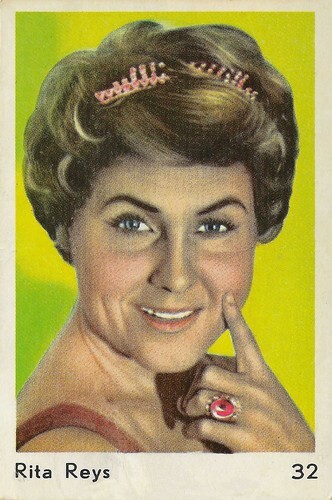
Dutch collector card, no. 32.
Rita Reys (1924-2013) was one of the greatest jazz singers the Netherlands has produced. Drummer Wessel Ilcken introduced her to the jazz scene. In 1950, Reys and Ilcken founded their own combo, with which they achieved success in Europe: the Rita Reys Sextet. In England, they performed in US army bases and dance clubs. They met saxophonist Ronnie Scott, founder of the jazz club Ronnie Scott's. In 1953, Rita and Wessel spent several months in Stockholm, then the centre of the European jazz scene. She recorded her first music records there for the label Artist, with alto saxophonist Lars Gullin's band. Reys' national breakthrough followed in January 1955, with the album 'Jazz Behind the Dikes'. Accompanied by the Wessel Ilcken Combo, she recorded 'My Funny Valentine', her signature song. Aram Avakian of the record company Columbia invited her to New York, where she recorded her first foreign album, 'The Cool Voice of Rita Reys' (1956) with Art Blakey's Jazz Messengers. At the French Juan-les-Pins jazz festival in 1960, Reys was named Europe's First Lady of Jazz. Her record 'Marriage In Modern Jazz' won Reys her first Edison Award. When she died at 89, she had been the greatest jazz singer in the Netherlands for more than half a century.
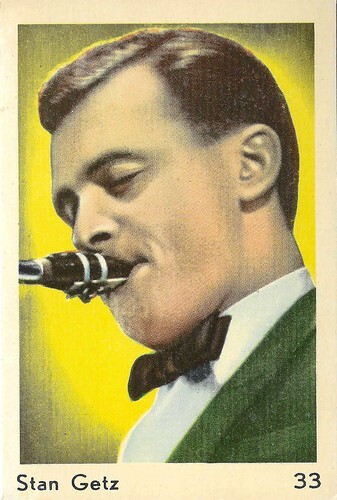
Dutch collector card, no. 33.
Jazz saxophonist Stan Getz (1927-1991) was known as 'The Sound' because of his warm, lyrical tone. In the late 1940s, he had his breakthrough with Woody Herman's big band. Getz performed in Bebop and Cool Jazz groups and recorded the album 'Focus' (1961), now considered one of the masterpieces of mid-twentieth-century jazz. He helped popularise Bossa Nova in the United States with the hit 'The Girl from Ipanema' (1964), sung by Astrud Gilberto, and the album 'Jazz Samba' featuring their cover of Antonio Carlos Jobim's 'Desafinado', which sold more than one million copies. It won Getz the Grammy for Best Jazz Performance of 1963. His next Bossa Nova albums were 'Big Band Bossa Nova' (1962) and 'Jazz Samba Encore!' (1963). In 1972, Stan Getz recorded the jazz fusion album 'Captain Marvel' with Chick Corea. He ALSO had a cameo in the film The Exterminator (James Glickenhaus, 1980).
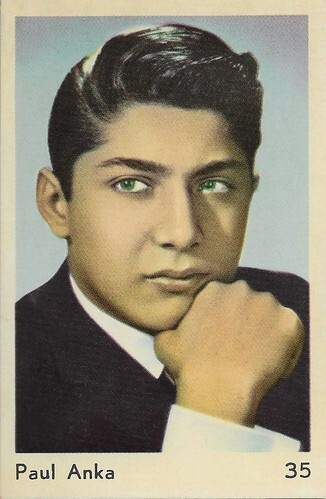
Dutch collector card, no. 35.
Paul Anka (1941) is a Canadian singer, songwriter, and actor. Anka recorded his first single, 'I Confess', when he was 14. He became famous in the late 1950s, 1960s, and 1970s with hit songs like 'Diana' (1957), 'Put Your Head on My Shoulder' (1959), and '(You're) Having My Baby' (1974). He wrote the theme for The Tonight Show Starring Johnny Carson and the English lyrics for Frank Sinatra's signature song, 'My Way' (1969). In the 1960s, Anka began acting in motion pictures as well as writing songs for them, most notably the theme for the hit film The Longest Day (Ken Annakin a.o., 1962). For his film work, he also wrote and recorded one of his greatest hits, 'Lonely Boy' (1959).
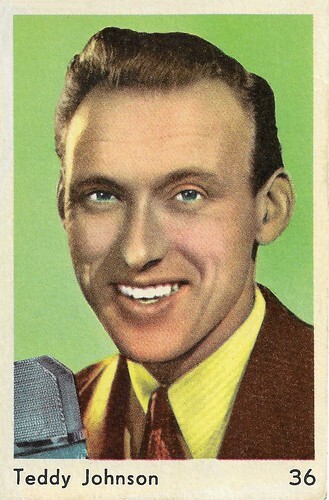
Dutch collector card, no. 36.
British singer Teddy Johnson (1919-2018) and his wife Pearl Carr (1921-2020) were best known during the 1950s and early 1960s. They were the UK's entrants at the 1959 Eurovision Song Contest with 'Sing, Little Birdie', which came second. The record peaked at no. 12 on the UK Singles Chart. Carr and Johnson were married in 1955 and remained so for 63 years, until their deaths. As a singer, Teddy performed in a few films, including Girls at Sea (1958). The couple became known professionally as 'Mr. and Mrs. Music' and were frequently on British television light entertainment programmes. In 1988, they appeared in the West End revival of the Stephen Sondheim musical 'Follies'. As the vaudeville couple Wally and Emily Whitman, they sang 'Rain on the Roof'. In 1990, after its 18-month run, they decided to retire.
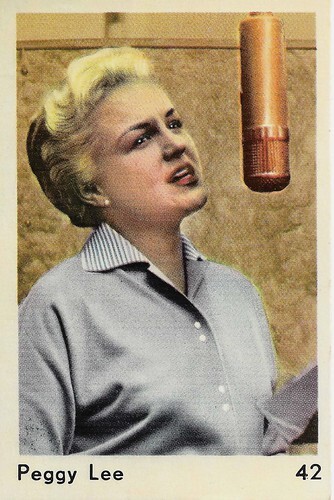
Dutch collector card, no. 42.
Sultry American jazz and pop singer Peggy Lee (1920-2002) recorded such classics as 'Fever', 'Manana', 'Big Spender' and 'Is That All There Is?'. Peggy's big break came in 1941 when Benny Goodman hired her to sing with his band after hearing her perform in a Chicago nightclub. In 1942, Lee had her first No. 1 hit, 'Somebody Else Is Taking My Place', followed in 1943 by 'Why Don't You Do Right?', which sold more than one million copies and made her famous. She sang with Goodman's orchestra in two films, Stage Door Canteen (Frank Borzage, 1943) and The Powers Girl (Norman Z. McLeod, 1943). In Hollywood, she made herself a name with parts in The Jazz Singer (Michael Curtiz, 1952) and Pete Kelly's Blues (Jack Webb, 1955). And she composed songs for Walt Disney's Lady and the Tramp (Clyde Geronimi, Wilfred Jackson, Hamilton Luske, 1955), for which she also voiced the unforgettable Peg, a broken-down old showgirl of a dog, whose provocative walk was based on the stage-prowl of Peggy Lee.
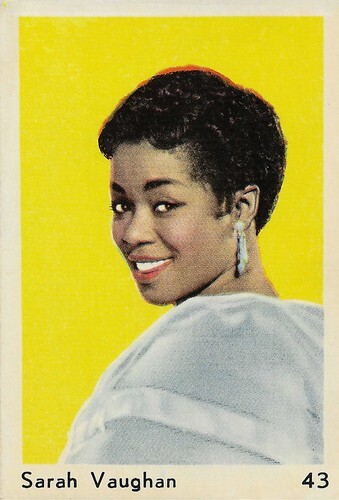
Dutch collector card, no. 43.
American artist Sarah Vaughan (1924-1990) ranked with Ella Fitzgerald and Billie Holiday in the top echelon of female Jazz singers. Nicknamed 'Sassy' and 'The Divine One', Vaughan was a four-time Grammy Award winner and won an Emmy in 1981 for a tribute to George Gershwin. Scott Yanow at AllMusic: "She often gave the impression that with her wide range, perfectly controlled vibrato, and wide expressive abilities, she could do anything she wanted with her voice." Vaughan performed her songs in several films, including the German production Schlager-Raketen (Erik Ode, 1960).

Dutch collector card, no. 15.
American actress and singer Pearl Bailey (1918-1990) began her singing career in nightclubs during the 1930s. She made her film debut with Variety Girl (George Marshall, 1947), and as a singer, she scored a big hit in 1952 with her version of 'Takes Two to Tango'. She played Frankie in Carmen Jones (Otto Preminger, 1954) with Dorothy Dandridge and Harry Belafonte. Her version of 'Beat Out That Rhythm on the Drum' was seen as the highlight of the film. She also starred in St. Louis Blues (Allen Resiner, 1958) opposite Nat King Cole, and featured as Maria in Porgy and Bess (Otto Preminger, 1959), along with Sidney Poitier and Dorothy Dandridge. Bailey received a Tony Award for her role in a special performance of 'Hello, Dolly!', with exclusively African-American actors.

Dutch collector card, no. 29.
American rock and roll pianist and singer-songwriter Antoine 'Fats' Domino Jr. (1928-2017) was best known for his songs, 'Ain't That A Shame' and 'Blueberry Hill'. He was inspired by boogie-woogie pianists like Meade Lux Lewis and singers like Louis Jordan. In 1946, Domino started playing piano with bandleader Billy Diamond, who nicknamed Domino ‘Fats’ because of his big appetite. His million-selling debut single, 'The Fat Man', is credited by some as the first ever rock and roll record. His style was based on traditional rhythm and blues ensembles of bass, piano, electric guitar, drums, and saxophone. Domino released five gold (million-copy-selling) records before 1955, and had 35 Top 40 American hits. He was one of the most influential rock and roll performers of the 1950s and 1960s. During the 1950s, Fats Domino performed in such films as Shake, Rattle & Rock! (Edward L. Cahn, 1956) with Mike Connors, The Girl Can't Help It (Frank Tashlin, 1956) with Jayne Mansfield, and The Big Beat (Will Cowan, 1958).

Dutch collector card, no. 30.
Lloyd Price (1933-2021) was an American R&B and rock 'n' roll singer. He was known as 'Mr. Personality' after his million-selling hit, 'Personality' (1959). Although most of Price's hits occurred in the late 1950s and early 1960s, he had his first hit in 1952 with 'Lawdy Miss Clawdy', which became a major R&B hit. However, his budding career came to a quick halt in 1954 when he was drafted into the army and was sent to Korea. Because of his musical background, though, he was placed into the Special Services (entertainment) branch, where he was put in charge of a large dance band that played 'Swing' music to entertain the troops. It was here that Price got the idea for what was to become his trademark style: combining a lush, full orchestra with the grittier, rawer tempos and vocals of R&B. Lloyd Price was inducted into the Rock and Roll Hall of Fame in 1998.

Dutch collector card, no. 31.
Lou Levy (1928-2001) counts as one of the leading jazz pianists of the 20th century. He started on piano when he was 12. His chief influences were Art Tatum and Bud Powell. At the end of the 1940s, he first attracted attention as a pianist for Georgie Auld, Boyd Raeburn and Chubby Jackson's bebop band, with whom he also toured Europe. In 1948, he joined Woody Herman's orchestra for a while. He also played with Sarah Vaughan, Tommy Dorsey, and Flip Phillips. Levy gained a strong reputation as a fine accompanist to singers, working with Peggy Lee (on and off during 1955-1973), Ella Fitzgerald (1957-1962), June Christy, Anita O'Day, Tony Bennett and Nancy Wilson. He also played with Benny Goodman, and especially for many years with Stan Getz, with whose quartet he also toured in the 1980s. He also accompanied Frank Sinatra, with whom he also went on tour in spring 1987, on his original recording of 'My Way' (1968) and the accompanying album.

Dutch collector card, no. 32.
Rita Reys (1924-2013) was one of the greatest jazz singers the Netherlands has produced. Drummer Wessel Ilcken introduced her to the jazz scene. In 1950, Reys and Ilcken founded their own combo, with which they achieved success in Europe: the Rita Reys Sextet. In England, they performed in US army bases and dance clubs. They met saxophonist Ronnie Scott, founder of the jazz club Ronnie Scott's. In 1953, Rita and Wessel spent several months in Stockholm, then the centre of the European jazz scene. She recorded her first music records there for the label Artist, with alto saxophonist Lars Gullin's band. Reys' national breakthrough followed in January 1955, with the album 'Jazz Behind the Dikes'. Accompanied by the Wessel Ilcken Combo, she recorded 'My Funny Valentine', her signature song. Aram Avakian of the record company Columbia invited her to New York, where she recorded her first foreign album, 'The Cool Voice of Rita Reys' (1956) with Art Blakey's Jazz Messengers. At the French Juan-les-Pins jazz festival in 1960, Reys was named Europe's First Lady of Jazz. Her record 'Marriage In Modern Jazz' won Reys her first Edison Award. When she died at 89, she had been the greatest jazz singer in the Netherlands for more than half a century.

Dutch collector card, no. 33.
Jazz saxophonist Stan Getz (1927-1991) was known as 'The Sound' because of his warm, lyrical tone. In the late 1940s, he had his breakthrough with Woody Herman's big band. Getz performed in Bebop and Cool Jazz groups and recorded the album 'Focus' (1961), now considered one of the masterpieces of mid-twentieth-century jazz. He helped popularise Bossa Nova in the United States with the hit 'The Girl from Ipanema' (1964), sung by Astrud Gilberto, and the album 'Jazz Samba' featuring their cover of Antonio Carlos Jobim's 'Desafinado', which sold more than one million copies. It won Getz the Grammy for Best Jazz Performance of 1963. His next Bossa Nova albums were 'Big Band Bossa Nova' (1962) and 'Jazz Samba Encore!' (1963). In 1972, Stan Getz recorded the jazz fusion album 'Captain Marvel' with Chick Corea. He ALSO had a cameo in the film The Exterminator (James Glickenhaus, 1980).

Dutch collector card, no. 35.
Paul Anka (1941) is a Canadian singer, songwriter, and actor. Anka recorded his first single, 'I Confess', when he was 14. He became famous in the late 1950s, 1960s, and 1970s with hit songs like 'Diana' (1957), 'Put Your Head on My Shoulder' (1959), and '(You're) Having My Baby' (1974). He wrote the theme for The Tonight Show Starring Johnny Carson and the English lyrics for Frank Sinatra's signature song, 'My Way' (1969). In the 1960s, Anka began acting in motion pictures as well as writing songs for them, most notably the theme for the hit film The Longest Day (Ken Annakin a.o., 1962). For his film work, he also wrote and recorded one of his greatest hits, 'Lonely Boy' (1959).

Dutch collector card, no. 36.
British singer Teddy Johnson (1919-2018) and his wife Pearl Carr (1921-2020) were best known during the 1950s and early 1960s. They were the UK's entrants at the 1959 Eurovision Song Contest with 'Sing, Little Birdie', which came second. The record peaked at no. 12 on the UK Singles Chart. Carr and Johnson were married in 1955 and remained so for 63 years, until their deaths. As a singer, Teddy performed in a few films, including Girls at Sea (1958). The couple became known professionally as 'Mr. and Mrs. Music' and were frequently on British television light entertainment programmes. In 1988, they appeared in the West End revival of the Stephen Sondheim musical 'Follies'. As the vaudeville couple Wally and Emily Whitman, they sang 'Rain on the Roof'. In 1990, after its 18-month run, they decided to retire.

Dutch collector card, no. 42.
Sultry American jazz and pop singer Peggy Lee (1920-2002) recorded such classics as 'Fever', 'Manana', 'Big Spender' and 'Is That All There Is?'. Peggy's big break came in 1941 when Benny Goodman hired her to sing with his band after hearing her perform in a Chicago nightclub. In 1942, Lee had her first No. 1 hit, 'Somebody Else Is Taking My Place', followed in 1943 by 'Why Don't You Do Right?', which sold more than one million copies and made her famous. She sang with Goodman's orchestra in two films, Stage Door Canteen (Frank Borzage, 1943) and The Powers Girl (Norman Z. McLeod, 1943). In Hollywood, she made herself a name with parts in The Jazz Singer (Michael Curtiz, 1952) and Pete Kelly's Blues (Jack Webb, 1955). And she composed songs for Walt Disney's Lady and the Tramp (Clyde Geronimi, Wilfred Jackson, Hamilton Luske, 1955), for which she also voiced the unforgettable Peg, a broken-down old showgirl of a dog, whose provocative walk was based on the stage-prowl of Peggy Lee.

Dutch collector card, no. 43.
American artist Sarah Vaughan (1924-1990) ranked with Ella Fitzgerald and Billie Holiday in the top echelon of female Jazz singers. Nicknamed 'Sassy' and 'The Divine One', Vaughan was a four-time Grammy Award winner and won an Emmy in 1981 for a tribute to George Gershwin. Scott Yanow at AllMusic: "She often gave the impression that with her wide range, perfectly controlled vibrato, and wide expressive abilities, she could do anything she wanted with her voice." Vaughan performed her songs in several films, including the German production Schlager-Raketen (Erik Ode, 1960).
Published on September 04, 2025 22:00
September 3, 2025
Directed by Raymond Bernard
The career of French film director and screenwriter Raymond Bernard (1891-1977) spanned more than 40 years. He is remembered for several large-scale historical productions, including the silent films Le Miracle des loups / The Miracle of the Wolves (1924) and Le Joueur d'échecs / The Chess Player (1927) and in the 1930s, a highly regarded adaptation of Les Misérables (1934).
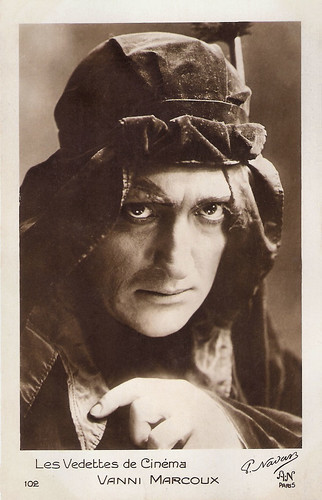
French postcard in the Les Vedettes de Cinéma series by A.N., Paris, no. 102. Photo: P. Nadar. Vanni Marcoux in Le Miracle des Loups / Miracle of the Wolves (Raymond Bernard, 1924).
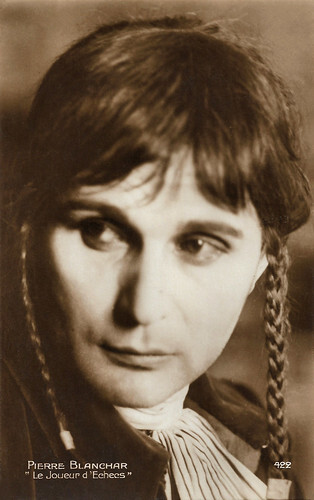
French postcard by Cinémagazine-Edition, Paris, no. 422. Photo: Pierre Blanchar in Le joueur d’échecs / The Chess Player (Raymond Bernard, 1927).
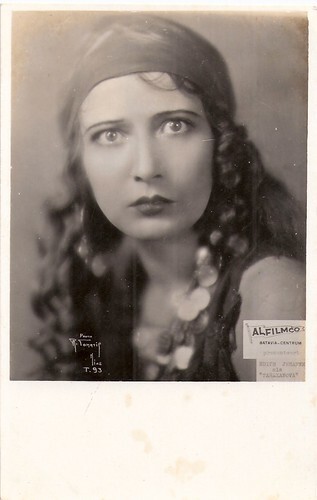
Vintage postcard for the Al Film Co., Batavia-Centrum (former Dutch East Indies, now Indonesia), no. T. 93. Photo: R. Tomarig, Nice. Édith Jéhanne in Tarakanova (Raymond Bernard, 1930). This picture was also used for posters and magazine covers.
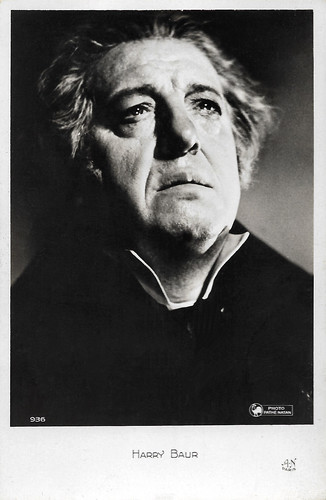
French postcard by A.N., Paris, no. 936. Photo: Pathé Natan. Harry Baur as Jean Valjean in Les Misérables (Raymond Bernard, 1934).
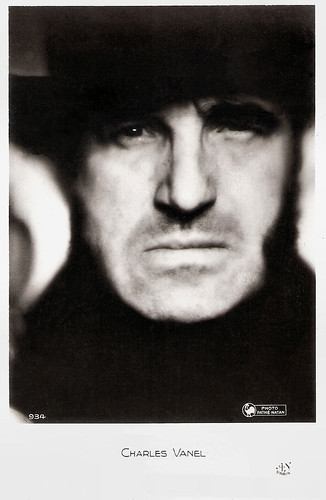
French postcard by A.N., Paris, no. 934. Photo: Pathé Natan. Charles Vanel as Javert in Les Misérables (Raymond Bernard, 1934).
Adapting plays written by his father
Raymond Bernard was born in Paris in 1891. He was the second son of the famous French writer and playwright Tristan Bernard and his wife, Suzanne Rébecca Bomsel. His older brother was the playwright Jean-Jacques Bernard, and his younger brother was the Resistance doctor Étienne Bernard.
He studied drama at the age of fifteen and began his career as an actor, appearing on stage in plays written by his father. In his father's play 'Jeanne Doré' (1913), he acted alongside Sarah Bernhardt . His part was written especially for him by his father. In August 1914, when the First World War broke out, he was mobilised, but was wounded twice and demobilised in June 1915. His film career began in 1915, when he acted alongside Sarah Bernhardt in the film adaptation of his father's play, Jeanne Doré (Louis Mercanton, René Hervil, 1916).
In 1916 or 1917, Bernard started working behind the camera at Gaumont as an assistant to director Jacques Feyder . Raymond Bernard completed the filming of Le ravin sans fond (1917) when Feyder was called to serve at the front during World War I. In Le ravin sans fond (Jacques Feyder, Raymond Bernard, 1917), Georges Tréville starred as a wealthy Count, a passionate mountaineer, who has made a will in favour of his goddaughter. His niece and her husband decide to kill him and force him to fall into a ravine. But six months later, the Count reappears, repaying everyone.
Le ravin sans fond was an adaptation of a novel by Tristan Bernard. When Raymond continued as a director, he primarily focused on adapting plays written by his father. His next films included Le traitement du hoquet (1918) with Armand Bernard , and Le petit café (1919) starring Max Linder and Armand Bernard .
In such popular entertainment films as Le secret de Rosette Lambert (1920) starring Lois Meredith and Triplepatte (1922), Raymond Bernard gained experience working with leading performers such as Charles Dullin and the young Albert Préjean .
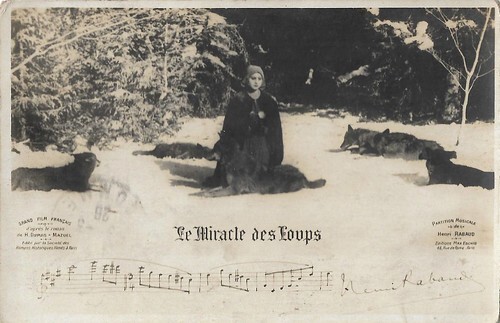
French postcard. Yvonne Sergyl in the French silent film Le Miracle des Loups / The Miracle of the Wolves (Raymond Bernard, 1924).
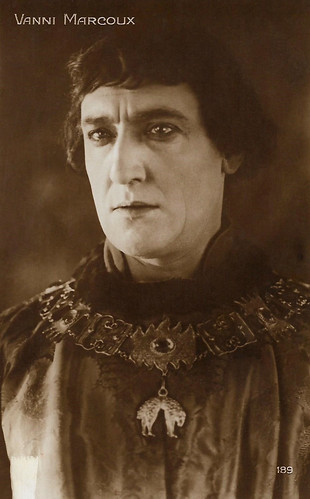
French postcard by Cinémagazine-Edition, no. 189. Vanni Marcoux as Charles le Téméraire (Charles the Bold) in the French silent film Le Miracle des Loups / The Miracle of the Wolves (Raymond Bernard, 1924).
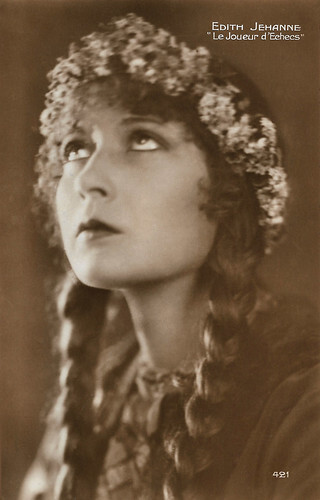
French postcard by Cinémagazine-Edition, no. 421. Photo: Édith Jéhanne in Le joueur d'échecs / The Chess Player (Raymond Bernard, 1927). The story takes place in 18th-century Poland and Russia.

French postcard by Cinémagazine-Edition, Paris, no. 349. Photo: Charles Dullin in Le joueur d'échecs / The Chess Player (Raymond Bernard, 1927).

German postcard by Ross Verlag, no. 4299/1, 1929-1930. Photo: D.L.S-Rosenfeld-Film. Olaf Fjord as Count Orlof in Tarakanova (Raymond Bernard, 1930).
A new style of film
In 1924, Raymond Bernard embarked upon a new style of film, the historical spectacle. He founded the Société des Grands Films Historiques with the writers Henry Dupuis-Mazuel and Jean-José Frappa. Their first production was Le Miracle des loups / The Miracle of the Wolves, set in 15th-century France during the reign of Louis XI. The leading role of King Louis XI in the film based on Henry Dupuy-Mazuel was played by Charles Dullin . The film contained spectacular battle scenes shot at Carcassonne. Le Miracle des loups proved to be the most expensive film of its day and one of the more profitable.
Bernard's ability to combine dramatic narrative with spacious settings and large numbers of performers was utilised in the two other silent, lavish, large-scale productions, Le Joueur d'échecs / The Chess Player (1927) with Pierre Blanchar and Charles Dullin , and Tarakanova (1930) starring Edith Jéhanne and Rudolf Klein-Rogge . It depicts the life of Princess Tarakanoff, the pretender to the throne of Catherine II in Eighteenth Century Russia.
Raymond Bernard joined Pathé-Nathan in 1931 and made his sound film debut. His film career in the sound era continued for nearly three decades. Further large-scale productions included his film about the First World War, Les Croix de bois / The Wooden Crosses (1932), and a three-part adaptation of Victor Hugo 's Les Misérables (1934), which was nearly five hours in length. It is the greatest adaptation of the novel, due to its in-depth development of the themes and characters, in comparison with most shorter adaptations. Pathé-Natan went bankrupt in 1934.
In his later films, he returned to modest projects and budgets, including a number of sophisticated comedies. After Antoine de Saint-Exupéry, Bernard directed Anne-Marie (1936) with Annabella in the title role as a young, aspiring pilot. At the end of the 1930s, he made the successful Spy film Marthe Richard au Service de la France / Marthe Richard (1937) with Edwige Feuillère and Erich von Stroheim , Les Otages / The Mayor's Dilemma (1939) with Annie Vernay and Cavalcade d'amour / Love Cavalcade (1940) with Claude Dauphin and Michel Simon . The films were set against the backdrop of the aggressive war mood in Europe. During the Second World War, he went into hiding in the Vercors. As a Jew, his father was interned in the Drancy camp and his nephew, François-René, son of his brother Jean-Jacques Bernard, was deported to Mauthausen, where he died. It was in memory of this period, and as a tribute to the people who helped him, that he made the film Un ami viendra ce soir / A Friend Will Come Tonight (1946) with Michel Simon and Madeleine Sologne .
Bernard retired from filmmaking in 1958. In the 1970s, when he was in his 80s, he could supervise the reconstruction of Les Misérables, which had been severely truncated in the 1940s for easier distribution. In 1977, shortly after the broadcast of a nearly complete version on French television, Bernard died in Paris at age 86. He was married to Jeanne Salley from 1940 till his death in 1977. He is buried in the Montmartre cemetery. Raymond Bernard was an Officer of the Legion of Honour.
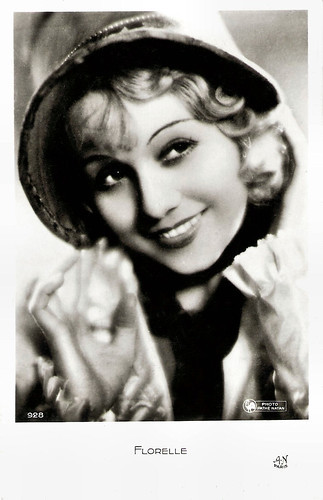
French postcard by A.N., Paris, no. 928. Photo: Pathé-Natan. Florelle as Fantine in Les Misérables (Raymond Bernard, 1934).

French postcard by A.N., Paris, no. 930. Photo: Pathé Natan. Orane Demazis as Eponine in Les Misérables (Raymond Bernard, 1934).
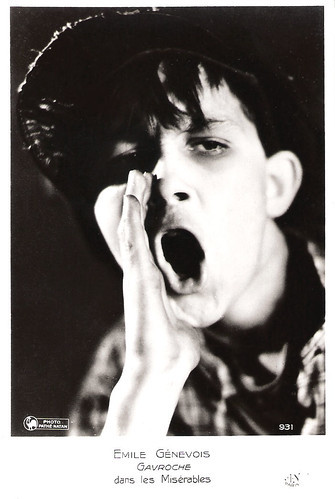
French postcard by A.N., Paris, no. 931. Photo Pathé Natan. Emile Génevois as Gavroche in Les Misérables (Raymond Bernard, 1934).
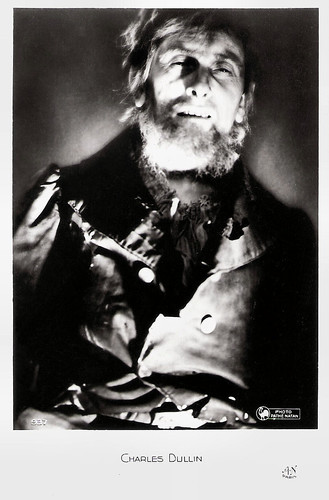
French postcard by A.N., Paris, no. 937. Photo: Pathé Natan. Charles Dullin as the evil Thénardier in Les Misérables (Raymond Bernard, 1934).
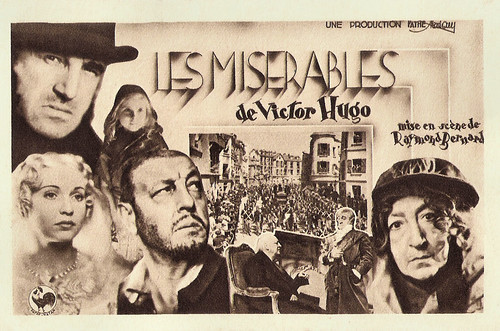
French postcard by A. Breger, Frères, Paris. Photo: Pathé Natan. In the centre: Harry Baur as Jean Valjean in Les Misérables (Raymond Bernard, 1934).
Sources: Wikipedia (English, German and French) and .

French postcard in the Les Vedettes de Cinéma series by A.N., Paris, no. 102. Photo: P. Nadar. Vanni Marcoux in Le Miracle des Loups / Miracle of the Wolves (Raymond Bernard, 1924).

French postcard by Cinémagazine-Edition, Paris, no. 422. Photo: Pierre Blanchar in Le joueur d’échecs / The Chess Player (Raymond Bernard, 1927).

Vintage postcard for the Al Film Co., Batavia-Centrum (former Dutch East Indies, now Indonesia), no. T. 93. Photo: R. Tomarig, Nice. Édith Jéhanne in Tarakanova (Raymond Bernard, 1930). This picture was also used for posters and magazine covers.

French postcard by A.N., Paris, no. 936. Photo: Pathé Natan. Harry Baur as Jean Valjean in Les Misérables (Raymond Bernard, 1934).

French postcard by A.N., Paris, no. 934. Photo: Pathé Natan. Charles Vanel as Javert in Les Misérables (Raymond Bernard, 1934).
Adapting plays written by his father
Raymond Bernard was born in Paris in 1891. He was the second son of the famous French writer and playwright Tristan Bernard and his wife, Suzanne Rébecca Bomsel. His older brother was the playwright Jean-Jacques Bernard, and his younger brother was the Resistance doctor Étienne Bernard.
He studied drama at the age of fifteen and began his career as an actor, appearing on stage in plays written by his father. In his father's play 'Jeanne Doré' (1913), he acted alongside Sarah Bernhardt . His part was written especially for him by his father. In August 1914, when the First World War broke out, he was mobilised, but was wounded twice and demobilised in June 1915. His film career began in 1915, when he acted alongside Sarah Bernhardt in the film adaptation of his father's play, Jeanne Doré (Louis Mercanton, René Hervil, 1916).
In 1916 or 1917, Bernard started working behind the camera at Gaumont as an assistant to director Jacques Feyder . Raymond Bernard completed the filming of Le ravin sans fond (1917) when Feyder was called to serve at the front during World War I. In Le ravin sans fond (Jacques Feyder, Raymond Bernard, 1917), Georges Tréville starred as a wealthy Count, a passionate mountaineer, who has made a will in favour of his goddaughter. His niece and her husband decide to kill him and force him to fall into a ravine. But six months later, the Count reappears, repaying everyone.
Le ravin sans fond was an adaptation of a novel by Tristan Bernard. When Raymond continued as a director, he primarily focused on adapting plays written by his father. His next films included Le traitement du hoquet (1918) with Armand Bernard , and Le petit café (1919) starring Max Linder and Armand Bernard .
In such popular entertainment films as Le secret de Rosette Lambert (1920) starring Lois Meredith and Triplepatte (1922), Raymond Bernard gained experience working with leading performers such as Charles Dullin and the young Albert Préjean .

French postcard. Yvonne Sergyl in the French silent film Le Miracle des Loups / The Miracle of the Wolves (Raymond Bernard, 1924).

French postcard by Cinémagazine-Edition, no. 189. Vanni Marcoux as Charles le Téméraire (Charles the Bold) in the French silent film Le Miracle des Loups / The Miracle of the Wolves (Raymond Bernard, 1924).

French postcard by Cinémagazine-Edition, no. 421. Photo: Édith Jéhanne in Le joueur d'échecs / The Chess Player (Raymond Bernard, 1927). The story takes place in 18th-century Poland and Russia.

French postcard by Cinémagazine-Edition, Paris, no. 349. Photo: Charles Dullin in Le joueur d'échecs / The Chess Player (Raymond Bernard, 1927).

German postcard by Ross Verlag, no. 4299/1, 1929-1930. Photo: D.L.S-Rosenfeld-Film. Olaf Fjord as Count Orlof in Tarakanova (Raymond Bernard, 1930).
A new style of film
In 1924, Raymond Bernard embarked upon a new style of film, the historical spectacle. He founded the Société des Grands Films Historiques with the writers Henry Dupuis-Mazuel and Jean-José Frappa. Their first production was Le Miracle des loups / The Miracle of the Wolves, set in 15th-century France during the reign of Louis XI. The leading role of King Louis XI in the film based on Henry Dupuy-Mazuel was played by Charles Dullin . The film contained spectacular battle scenes shot at Carcassonne. Le Miracle des loups proved to be the most expensive film of its day and one of the more profitable.
Bernard's ability to combine dramatic narrative with spacious settings and large numbers of performers was utilised in the two other silent, lavish, large-scale productions, Le Joueur d'échecs / The Chess Player (1927) with Pierre Blanchar and Charles Dullin , and Tarakanova (1930) starring Edith Jéhanne and Rudolf Klein-Rogge . It depicts the life of Princess Tarakanoff, the pretender to the throne of Catherine II in Eighteenth Century Russia.
Raymond Bernard joined Pathé-Nathan in 1931 and made his sound film debut. His film career in the sound era continued for nearly three decades. Further large-scale productions included his film about the First World War, Les Croix de bois / The Wooden Crosses (1932), and a three-part adaptation of Victor Hugo 's Les Misérables (1934), which was nearly five hours in length. It is the greatest adaptation of the novel, due to its in-depth development of the themes and characters, in comparison with most shorter adaptations. Pathé-Natan went bankrupt in 1934.
In his later films, he returned to modest projects and budgets, including a number of sophisticated comedies. After Antoine de Saint-Exupéry, Bernard directed Anne-Marie (1936) with Annabella in the title role as a young, aspiring pilot. At the end of the 1930s, he made the successful Spy film Marthe Richard au Service de la France / Marthe Richard (1937) with Edwige Feuillère and Erich von Stroheim , Les Otages / The Mayor's Dilemma (1939) with Annie Vernay and Cavalcade d'amour / Love Cavalcade (1940) with Claude Dauphin and Michel Simon . The films were set against the backdrop of the aggressive war mood in Europe. During the Second World War, he went into hiding in the Vercors. As a Jew, his father was interned in the Drancy camp and his nephew, François-René, son of his brother Jean-Jacques Bernard, was deported to Mauthausen, where he died. It was in memory of this period, and as a tribute to the people who helped him, that he made the film Un ami viendra ce soir / A Friend Will Come Tonight (1946) with Michel Simon and Madeleine Sologne .
Bernard retired from filmmaking in 1958. In the 1970s, when he was in his 80s, he could supervise the reconstruction of Les Misérables, which had been severely truncated in the 1940s for easier distribution. In 1977, shortly after the broadcast of a nearly complete version on French television, Bernard died in Paris at age 86. He was married to Jeanne Salley from 1940 till his death in 1977. He is buried in the Montmartre cemetery. Raymond Bernard was an Officer of the Legion of Honour.

French postcard by A.N., Paris, no. 928. Photo: Pathé-Natan. Florelle as Fantine in Les Misérables (Raymond Bernard, 1934).

French postcard by A.N., Paris, no. 930. Photo: Pathé Natan. Orane Demazis as Eponine in Les Misérables (Raymond Bernard, 1934).

French postcard by A.N., Paris, no. 931. Photo Pathé Natan. Emile Génevois as Gavroche in Les Misérables (Raymond Bernard, 1934).

French postcard by A.N., Paris, no. 937. Photo: Pathé Natan. Charles Dullin as the evil Thénardier in Les Misérables (Raymond Bernard, 1934).

French postcard by A. Breger, Frères, Paris. Photo: Pathé Natan. In the centre: Harry Baur as Jean Valjean in Les Misérables (Raymond Bernard, 1934).
Sources: Wikipedia (English, German and French) and .
Published on September 03, 2025 22:00
September 2, 2025
Giovanna’s precious gift
A big collection of 1920s Italian postcards was donated to Ivo Blom, EFSP collaborator and expert in Italian silent film, by his good friend Giovanna. The cards were, at the time, collected by two Sicilian women, Enrichetta, the sister of Giovanna's grandfather, and Margherita, the daughter of a sister of her grandfather. Many of the written postcards were sent to the two ladies in 1923, from various locations. In Canicatti, where Enrichetta lived, there was also a big card shop, from which many of the unused cards stem. Her grandmother gave the postcards to Giovanna in the early 1970s. While the collection contains several Italian stage and screen stars like Lyda Borelli, Francesca Bertini, Pina Menichelli, Leda Gys and Vera Vergani, there are more so-called fantasy cards in the collection. On these postcards, unknown women express all kinds of emotions, either chastity and devotion, or seduction. In two cases, the same model, in one case a lesser-known Italian actress called Lydia Johnson, expresses both emotional antipoles on different cards. As several sets or series around a certain motif contain six cards, we expect this to concur with the original size of the sets. The many blue cards within the collection were made according to a simple photomechanical tinting process, derived from cyanotypes.
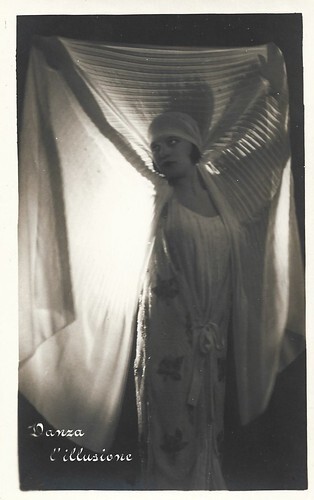
Italian postcard by Bromografica, Milano, in the series Danza: L'illusione. Photo: Luxor. The collection contains four cards in this series. The other cards are titled 'L'amore', 'Le stelle', and 'Il fuoco'.
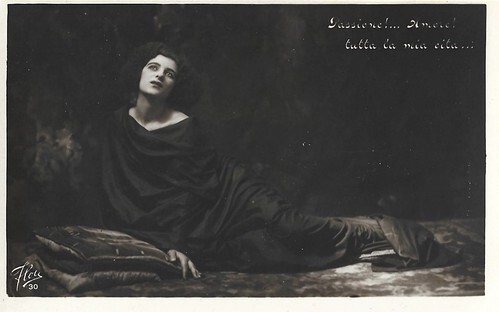
Italian postcard by Bromografica, Milano. Photo: Flou. Caption: Passione! Amore! tutta la mia vita... (Passion! Love! all my life...). This card is part of a series on women lying on the ground.
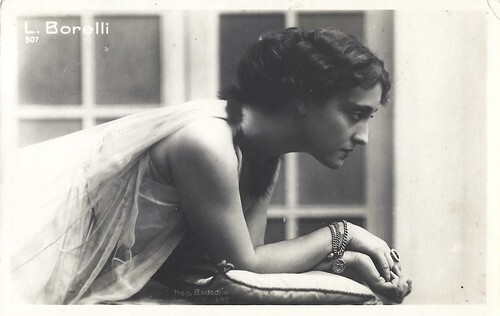
Italian postcard by Vettori, Bologna, no. 507. Photo: Badodi, Milano. Lyda Borelli .
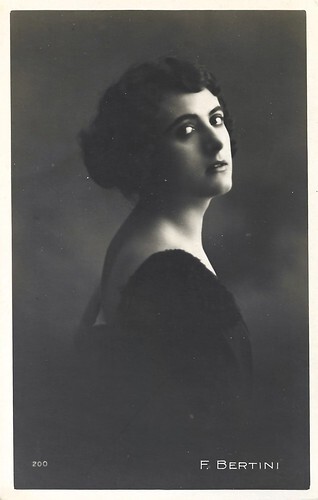
Italian postcard by Vettori, Bologna, no. 200. Francesca Bertini .
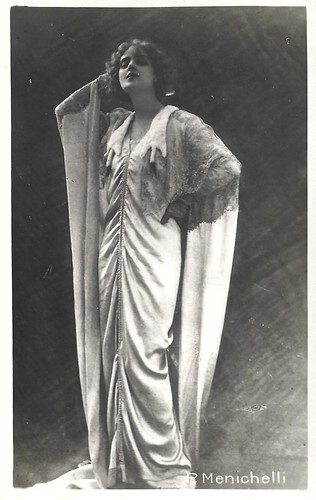
Italian postcard by Vettori, Bologna. Pina Menichelli in Tigre reale / The Royal Tigress (Giovanni Pastrone, 1916).
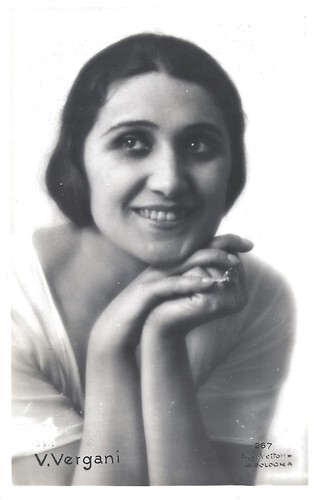
Italian postcard by Vettori, Bologna, no. 267. Vera Vergani .
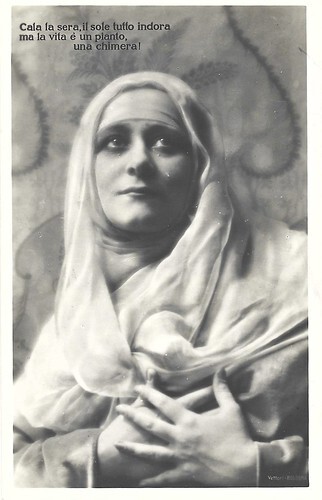
Italian postcard by Vettori, Bologna. Caption: Cala la sera, il sole tutto indora ma la vita è un pianto, una chimera! (Evening falls, the sun gilds everything, but life is a plaint, a mirage!). Lydia Johnson as a nun. In the collection are five cards of this series in which Johnson appears both as a nun and a femme fatale.
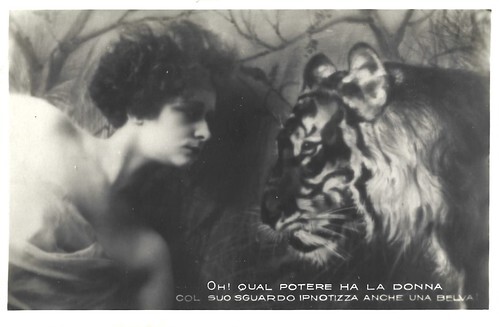
Italian postcard by Vettori, Bologna. Caption: Oh! Qual potere ha la donna col suo sguardo ipnotizza anche une belva (Oh, what power a woman has. With her gaze she can even hypnotize a beast). Lydia Johnson did a series of postcards with a ferocious-looking tiger, in which women are compared to wild animals, with the same power, magnetic eyes, and huge roars when hurt. We own six cards from this series.
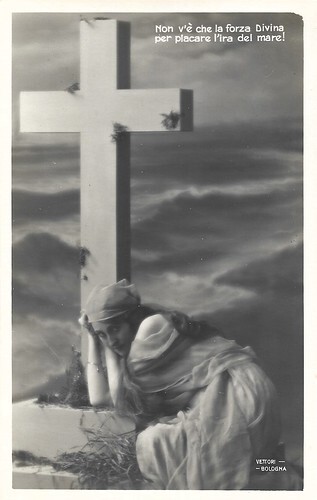
Italian postcard by Vettori, Bologna. Caption: Non v'è che la forza Divina per placare l'ira del mare! (Only Divine intervention may calm the anger of the sea!). Postcard in a series on Storm at Sea, always with an elegantly dressed woman embracing a huge cross near the sea, photographed in a studio setting. We possess six cards of the series.
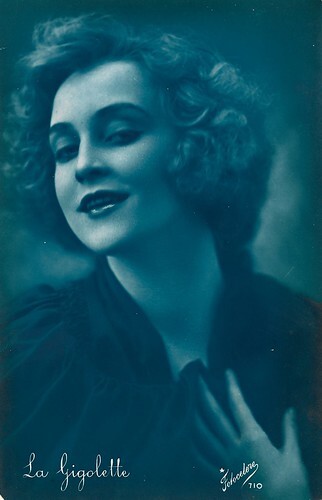
Italian postcard by Fotocelere, no. 710. Blueprint. In the early 20th century, a 'gigolette' was a promiscuous young woman of the Parisian slums, often the girlfriend of the 'apache', the Parisian underworld bandit. This series of blue-toned cards by Fotocelere was actually very large - we have 19 cards of them. Within these series, we owe 5 cards entitled 'La Gigolette', while, curiously enough, with the same model, another one is called 'Mater Dolorosa', uniting the opposites.
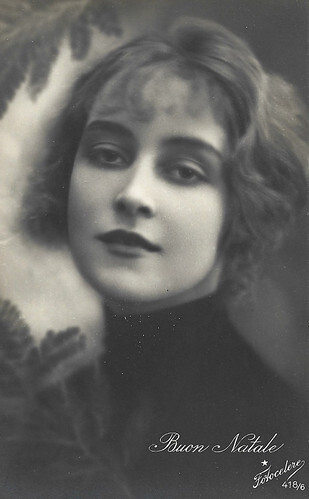
Italian postcard by Fotocelere, Berlin, no. 418/8. While most cards of Fotocelere were issued in Turin, Italy, another part was printed in Germany.
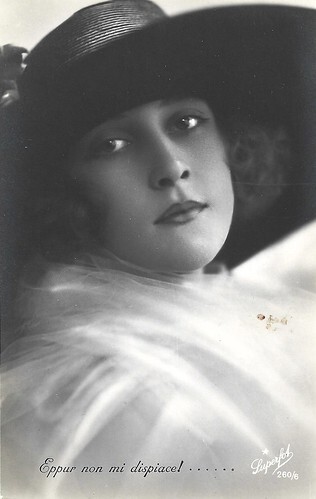
Italian postcard by Fotocelere, Berlin, no. 260/6. Photo: Superfoto. Caption: Eppur non mi dispiace!... (And still she doesn't dislike me! / And still you don't dislike her - both options are possible). We have six cards in this series.
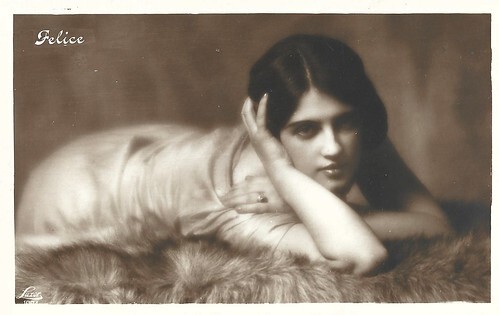
Italian postcard by Bromografica, Milano, no. 1094. Photo: Luxor. Postcard in a series of women lying on a fur. This one is entitled 'Felice' (Happy). Other cards were entitled 'Sdegnosa' (Disdainful), 'Timorosa' (Timid), 'Sognante' (Dreamy), and 'Ansiosa' (Anxious).
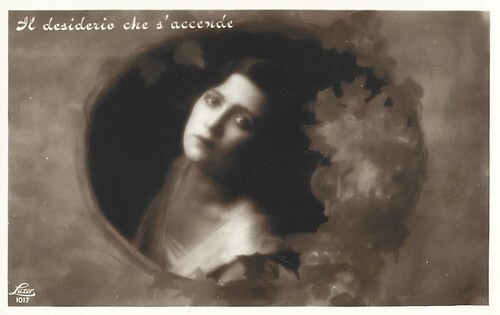
Italian postcard by Bromografica, Milano, no. 1017. Photo: Luxor. Caption: 'Il desiderio che si accende' (The desire that ignites). Other cards had the captions: 'L'anima che scruta' (The soul that scrutinises), 'Il pensiero che invita' (The thought that invites), and 'Il cuore che chiama' (The heart that calls).
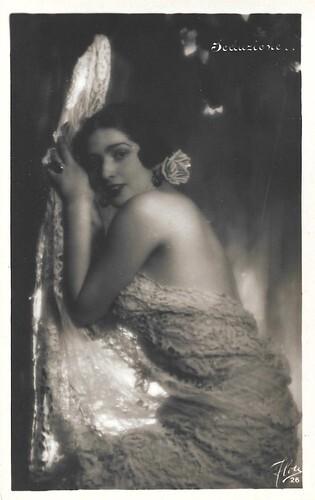
Italian postcard by Bromografica, Milano, no. 26. Photo: Flou. This card is called 'Seduzione' (Seduction). The photographer often used special lighting effects, increasing the aesthetic attraction.
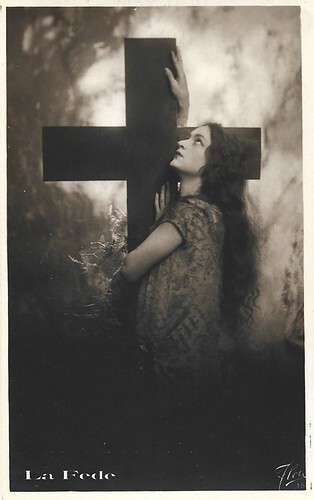
Italian postcard by Bromografica, Milano. Photo: Flou. Opposite to his series 'Seduzione' (Seduction), Flou also made a series of photos called 'La Fede (Faith), with a Pre-Raphaelite-like, devout young woman embracing a cross. There are six cards from this series in the collection
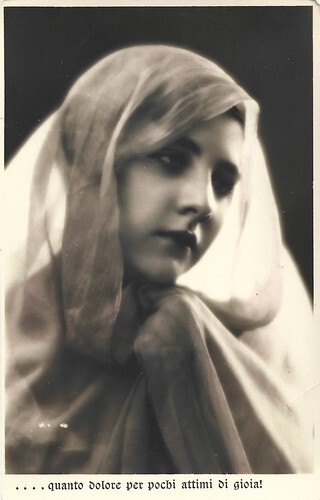
Italian postcard by Casa Editrice Ballerini & Fratini, Firenze (Florence). Caption: Quanto dolore per pochi attimi di gioia! (How much sorrow for just a few moments of happiness!). B.F.F. made a series of postcards of an aetherial young girl, draped in a large semi-transparent veil, as if a young Madonna. In the collection are six different cards from this series.
Giovanna, many thanks for your donation! We will take good care of this precious collection of your family. Text: Ivo Blom.

Italian postcard by Bromografica, Milano, in the series Danza: L'illusione. Photo: Luxor. The collection contains four cards in this series. The other cards are titled 'L'amore', 'Le stelle', and 'Il fuoco'.

Italian postcard by Bromografica, Milano. Photo: Flou. Caption: Passione! Amore! tutta la mia vita... (Passion! Love! all my life...). This card is part of a series on women lying on the ground.

Italian postcard by Vettori, Bologna, no. 507. Photo: Badodi, Milano. Lyda Borelli .

Italian postcard by Vettori, Bologna, no. 200. Francesca Bertini .

Italian postcard by Vettori, Bologna. Pina Menichelli in Tigre reale / The Royal Tigress (Giovanni Pastrone, 1916).

Italian postcard by Vettori, Bologna, no. 267. Vera Vergani .

Italian postcard by Vettori, Bologna. Caption: Cala la sera, il sole tutto indora ma la vita è un pianto, una chimera! (Evening falls, the sun gilds everything, but life is a plaint, a mirage!). Lydia Johnson as a nun. In the collection are five cards of this series in which Johnson appears both as a nun and a femme fatale.

Italian postcard by Vettori, Bologna. Caption: Oh! Qual potere ha la donna col suo sguardo ipnotizza anche une belva (Oh, what power a woman has. With her gaze she can even hypnotize a beast). Lydia Johnson did a series of postcards with a ferocious-looking tiger, in which women are compared to wild animals, with the same power, magnetic eyes, and huge roars when hurt. We own six cards from this series.

Italian postcard by Vettori, Bologna. Caption: Non v'è che la forza Divina per placare l'ira del mare! (Only Divine intervention may calm the anger of the sea!). Postcard in a series on Storm at Sea, always with an elegantly dressed woman embracing a huge cross near the sea, photographed in a studio setting. We possess six cards of the series.

Italian postcard by Fotocelere, no. 710. Blueprint. In the early 20th century, a 'gigolette' was a promiscuous young woman of the Parisian slums, often the girlfriend of the 'apache', the Parisian underworld bandit. This series of blue-toned cards by Fotocelere was actually very large - we have 19 cards of them. Within these series, we owe 5 cards entitled 'La Gigolette', while, curiously enough, with the same model, another one is called 'Mater Dolorosa', uniting the opposites.

Italian postcard by Fotocelere, Berlin, no. 418/8. While most cards of Fotocelere were issued in Turin, Italy, another part was printed in Germany.

Italian postcard by Fotocelere, Berlin, no. 260/6. Photo: Superfoto. Caption: Eppur non mi dispiace!... (And still she doesn't dislike me! / And still you don't dislike her - both options are possible). We have six cards in this series.

Italian postcard by Bromografica, Milano, no. 1094. Photo: Luxor. Postcard in a series of women lying on a fur. This one is entitled 'Felice' (Happy). Other cards were entitled 'Sdegnosa' (Disdainful), 'Timorosa' (Timid), 'Sognante' (Dreamy), and 'Ansiosa' (Anxious).

Italian postcard by Bromografica, Milano, no. 1017. Photo: Luxor. Caption: 'Il desiderio che si accende' (The desire that ignites). Other cards had the captions: 'L'anima che scruta' (The soul that scrutinises), 'Il pensiero che invita' (The thought that invites), and 'Il cuore che chiama' (The heart that calls).

Italian postcard by Bromografica, Milano, no. 26. Photo: Flou. This card is called 'Seduzione' (Seduction). The photographer often used special lighting effects, increasing the aesthetic attraction.

Italian postcard by Bromografica, Milano. Photo: Flou. Opposite to his series 'Seduzione' (Seduction), Flou also made a series of photos called 'La Fede (Faith), with a Pre-Raphaelite-like, devout young woman embracing a cross. There are six cards from this series in the collection

Italian postcard by Casa Editrice Ballerini & Fratini, Firenze (Florence). Caption: Quanto dolore per pochi attimi di gioia! (How much sorrow for just a few moments of happiness!). B.F.F. made a series of postcards of an aetherial young girl, draped in a large semi-transparent veil, as if a young Madonna. In the collection are six different cards from this series.
Giovanna, many thanks for your donation! We will take good care of this precious collection of your family. Text: Ivo Blom.
Published on September 02, 2025 22:00
September 1, 2025
Claire Windsor
American actress Claire Windsor (1892-1972) was the muse of director Lois Weber. She appeared in a total of 60 silent and sound film productions. In the 1920s, Windsor mostly played leading roles and thereafter, supporting roles.

Italian postcard by Foto Ebany, no. 151.
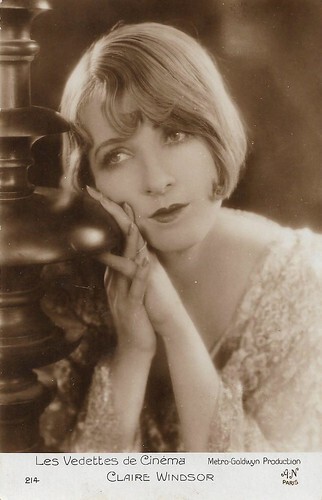
French postcard in the Les vedettes de cinéma series by A.N., Paris, no. 214. Photo: Metro Goldwyn Production. Claire Windsor in Dance Madness (Robert Z. Leonard, 1926).
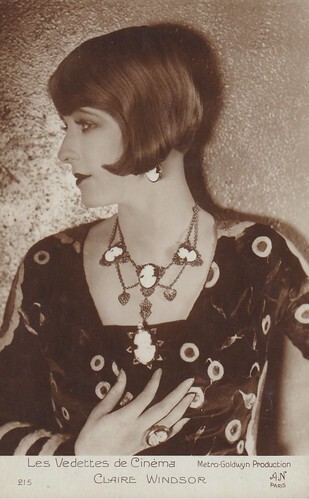
French postcard in the Les vedettes de cinéma series by A.N., Paris, no. 215. Photo: Metro Goldwyn Production. Collection: Marlene Pilaete. Please note the exquisite jewelry: a cameo necklace with matching earrings and ring.
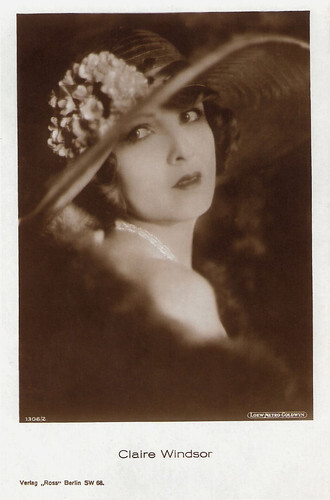
German postcard by Ross Verlag, Berlin, no. 1306/2, 1927-1928. Photo: Loew Goldwyn Mayer.
The muse of Lois Weber
Claire Windsor was born Clara Viola Cronk in Marvin (present day Glade), in Phillips County, Kansas, in 1892. Claire was the younger of two children of merchant George Edwin and Rosella Fearing Cronk. Their first child, a son, died shortly after birth. From 1895, Clara grew up in the community of Cawker City, where the family ran a shop called Cronk and Fearing. She graduated from high school in Topeka in 1907, then attended Broadway High School in Seattle, before she returned as a student in the Fine Arts Department at Washburn College.
In 1910, the wealthy family moved to Seattle. There, Cronk played her first stage role in the lavish musical 'Jappyland' in 1913. During this time, she met her future husband, Willis Bowes from Denver, whom she married in 1914. Their son, David Willis Bowes junior, was born in 1916. They divorced in 1920, and from then on, Clara and her child lived with her parents again. On advice from a friend, she moved to Hollywood.
Initially, she got only extra roles, but Lois Weber, a major director and producer at Paramount Pictures, noticed her. She adopted the more matinee-friendly name Claire Windsor when she signed with Weber. Her first leading role was in To Please One Woman (Lois Weber, 1920), which was only a modest success but became her breakthrough. Weber offered her leading roles in the dramas What's Worth While? (Lois Weber, 1920), Too Wise Wives (Lois Weber, 1921) and The Blot (Lois Weber, 1921), all with Louis Calhern.
Paramount declined to distribute What Do Men Want? (Lois Weber, 1921), possibly due to its subject matter involving an unwed mother and suicide. As part of the deal to distribute Weber's film The Blot (1921), F.B. Warren also released What Do Men Want? Paramount Pictures saw a star in Windsor and often had her pose for publicity photos with the newly divorced actor Charlie Chaplin , leading the tabloid press to give mention to the young actress in print. On Tuesday 12 July 1921, Windsor took a horseride near Cahuenga Pass in Hollywood and mysteriously disappeared. Her vanishing made headline news. It was reported that the horse had been found with the bridle dragging. In the evening of 13 July, Claire reappeared and explained that all she remembered was a fall from her horse. Decades later, she admitted that it was a publicity stunt masterminded by Lois Weber, who wanted to give extra exposure to her new star.
She gained even more publicity when she was named one of the 1922 WAMPAS Baby Stars, the year's most promising starlets, alongside Bessie Love , Lila Lee , Mary Philbin and Colleen Moore . That same year, Windsor got a contract with Goldwyn Pictures Corporation. Claire was peripherally involved in the famous William Desmond Taylor murder case in 1922. She and director Taylor had a dinner date the night before he was found murdered in his house. Although the case has never been officially solved, one theory is that Desmond was killed by a jealous lover who saw Claire at his house that night and, when she left, sneaked into the house and killed him. She was questioned by the police the next day and eventually cleared of any involvement in the murder.
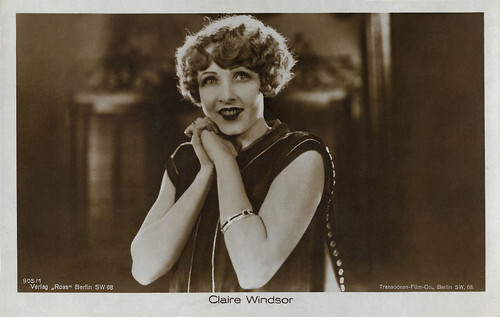
German postcard by Ross Verlag, Berlin, no. 905/1, 1925-1926. Photo: Transocean-Film-Co. Berlin.
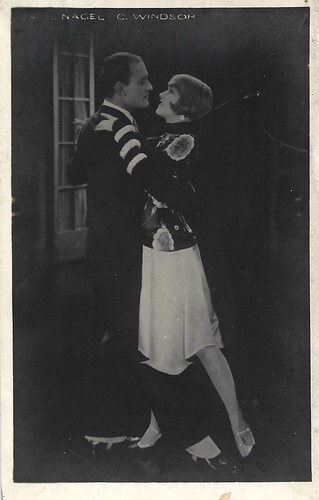
Italian postcard by Ebany. Photo: MGM. Conrad Nagel and Claire Windsor in Dance Madness (Robert Z. Leonard, MGM 1926).
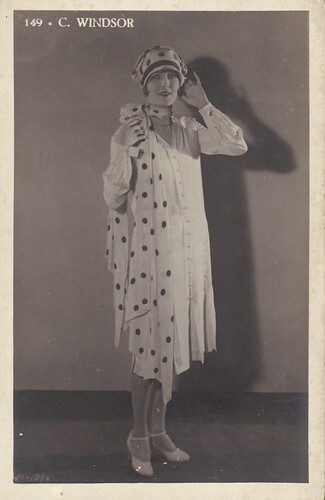
Italian postcard, no. 149. Collection: Marlene Pilaete.
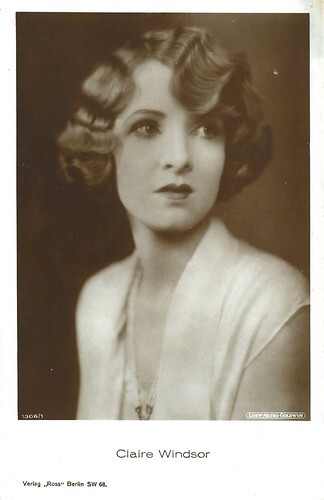
German postcard by Ross Verlag, Berlin, no. 1306/1, 1927-1928. Photo: Loew-Metro-Goldwyn.
A highly regarded leading lady in film
Throughout the 1920s, Claire Windsor established herself as a highly regarded leading lady in film. As her career progressed, she was often typecast as the 'upscale society girl', often playing a princess or socialite. In 1924, Windsor was one of the top stars at the newly formed Metro-Goldwyn-Mayer studio.
Later, at Tiffany Pictures, Souls for Sables (James C. McKay, 1925), co-starring Eugene O'Brien, was a box-office hit for Windsor. She was also known for her relationships with her colleagues. She had a well-publicised affair with Charles ‘Buddy’ Rogers , who was twelve years her junior. She married matinée idol Bert Lytell in 1925. However, the marriage came to an end by 1927.
Windsor never married again, but still appeared several times in the newspapers for her affairs or scandals. For example, she was unsuccessfully sued by the wife of a lawyer from Boston because she had ‘stolen’ her husband. In the late 1920s, Windsor was troubled by the transition to sound film. She did make several sound films, but never became as popular as she was in the silent film era.
Her role in the famous screwball comedy Topper (Norman Z. McLeod, 1937), for instance, was very small. Windsor made one of her last major appearances at Monogram Pictures as Alice in Self Defense (Phil Rosen, 1932) with Pauline Frederick . She therefore increasingly worked as a stage actress, including a joint tour with Al Jolson in the play 'The Wonder Bar'. Windsor ended her career in 1945 and from then on worked as a painter and as a ceramist.
Two years earlier, she had registered her stage name as her official name, and her son also called himself ‘Windsor’ from then on. Windsor lived in a mansion built for her in 1923 in the Hollywood Hills. She died in 1972 at the age of 80 (74 according to some contemporary obituaries) in Good Samaritan Hospital following a heart attack. The actress was buried in Forest Lawn Memorial Park. Her son died just one year later at the age of 57. For her services to the film world, Claire Windsor received a star on the Hollywood Walk of Fame at 7021 Hollywood Boulevard.
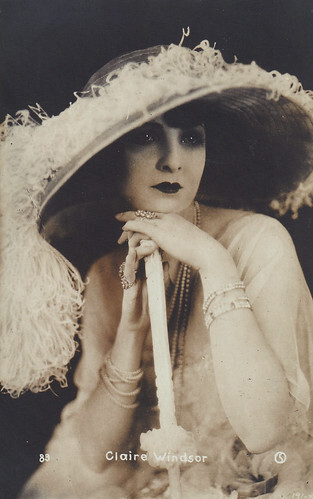
Finnish postcard by Kortcentralen Korttikeskus, no. 83. Collection: Marlene Pilaete.
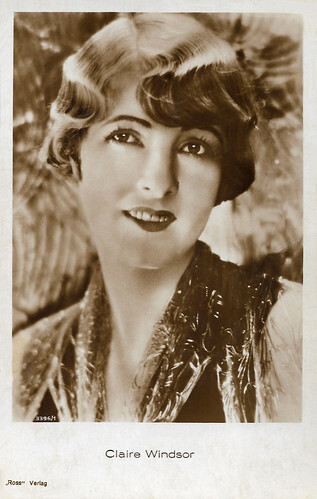
German postcard by Ross Verlag, no. 3396/1, 1928-1929.
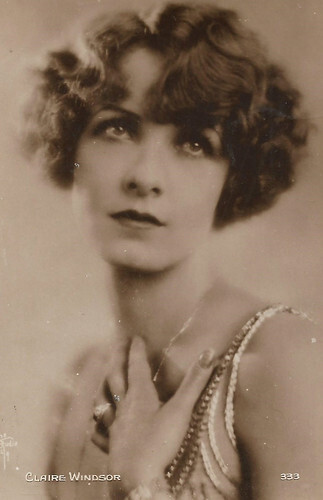
French postcard by Editions Cinémagazine, no. 333. Photo: Evans, L.A.
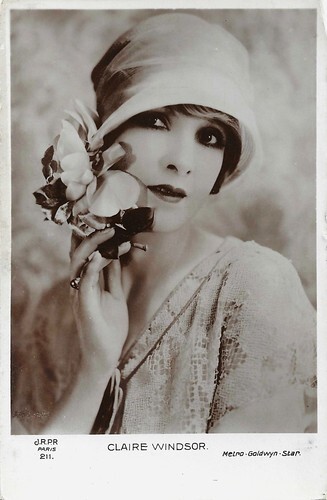
French postcard by J.R.P.R., Paris, no. 211. Photo: Metro Goldwyn.
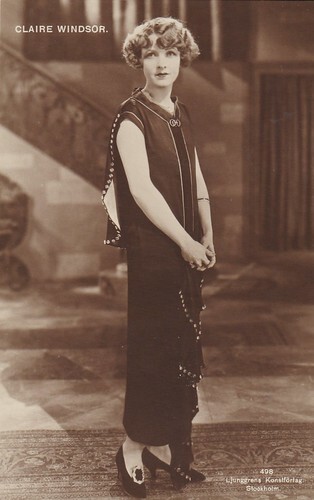
Swedish postcard by Ljunggrens Konstförlag, no. 498. Collection: Marlene Pilaete.
Sources: (IMDb), Wikipedia (Dutch, German and English) and . With additional information from Marlene Pilaete.

Italian postcard by Foto Ebany, no. 151.

French postcard in the Les vedettes de cinéma series by A.N., Paris, no. 214. Photo: Metro Goldwyn Production. Claire Windsor in Dance Madness (Robert Z. Leonard, 1926).

French postcard in the Les vedettes de cinéma series by A.N., Paris, no. 215. Photo: Metro Goldwyn Production. Collection: Marlene Pilaete. Please note the exquisite jewelry: a cameo necklace with matching earrings and ring.

German postcard by Ross Verlag, Berlin, no. 1306/2, 1927-1928. Photo: Loew Goldwyn Mayer.
The muse of Lois Weber
Claire Windsor was born Clara Viola Cronk in Marvin (present day Glade), in Phillips County, Kansas, in 1892. Claire was the younger of two children of merchant George Edwin and Rosella Fearing Cronk. Their first child, a son, died shortly after birth. From 1895, Clara grew up in the community of Cawker City, where the family ran a shop called Cronk and Fearing. She graduated from high school in Topeka in 1907, then attended Broadway High School in Seattle, before she returned as a student in the Fine Arts Department at Washburn College.
In 1910, the wealthy family moved to Seattle. There, Cronk played her first stage role in the lavish musical 'Jappyland' in 1913. During this time, she met her future husband, Willis Bowes from Denver, whom she married in 1914. Their son, David Willis Bowes junior, was born in 1916. They divorced in 1920, and from then on, Clara and her child lived with her parents again. On advice from a friend, she moved to Hollywood.
Initially, she got only extra roles, but Lois Weber, a major director and producer at Paramount Pictures, noticed her. She adopted the more matinee-friendly name Claire Windsor when she signed with Weber. Her first leading role was in To Please One Woman (Lois Weber, 1920), which was only a modest success but became her breakthrough. Weber offered her leading roles in the dramas What's Worth While? (Lois Weber, 1920), Too Wise Wives (Lois Weber, 1921) and The Blot (Lois Weber, 1921), all with Louis Calhern.
Paramount declined to distribute What Do Men Want? (Lois Weber, 1921), possibly due to its subject matter involving an unwed mother and suicide. As part of the deal to distribute Weber's film The Blot (1921), F.B. Warren also released What Do Men Want? Paramount Pictures saw a star in Windsor and often had her pose for publicity photos with the newly divorced actor Charlie Chaplin , leading the tabloid press to give mention to the young actress in print. On Tuesday 12 July 1921, Windsor took a horseride near Cahuenga Pass in Hollywood and mysteriously disappeared. Her vanishing made headline news. It was reported that the horse had been found with the bridle dragging. In the evening of 13 July, Claire reappeared and explained that all she remembered was a fall from her horse. Decades later, she admitted that it was a publicity stunt masterminded by Lois Weber, who wanted to give extra exposure to her new star.
She gained even more publicity when she was named one of the 1922 WAMPAS Baby Stars, the year's most promising starlets, alongside Bessie Love , Lila Lee , Mary Philbin and Colleen Moore . That same year, Windsor got a contract with Goldwyn Pictures Corporation. Claire was peripherally involved in the famous William Desmond Taylor murder case in 1922. She and director Taylor had a dinner date the night before he was found murdered in his house. Although the case has never been officially solved, one theory is that Desmond was killed by a jealous lover who saw Claire at his house that night and, when she left, sneaked into the house and killed him. She was questioned by the police the next day and eventually cleared of any involvement in the murder.

German postcard by Ross Verlag, Berlin, no. 905/1, 1925-1926. Photo: Transocean-Film-Co. Berlin.

Italian postcard by Ebany. Photo: MGM. Conrad Nagel and Claire Windsor in Dance Madness (Robert Z. Leonard, MGM 1926).

Italian postcard, no. 149. Collection: Marlene Pilaete.

German postcard by Ross Verlag, Berlin, no. 1306/1, 1927-1928. Photo: Loew-Metro-Goldwyn.
A highly regarded leading lady in film
Throughout the 1920s, Claire Windsor established herself as a highly regarded leading lady in film. As her career progressed, she was often typecast as the 'upscale society girl', often playing a princess or socialite. In 1924, Windsor was one of the top stars at the newly formed Metro-Goldwyn-Mayer studio.
Later, at Tiffany Pictures, Souls for Sables (James C. McKay, 1925), co-starring Eugene O'Brien, was a box-office hit for Windsor. She was also known for her relationships with her colleagues. She had a well-publicised affair with Charles ‘Buddy’ Rogers , who was twelve years her junior. She married matinée idol Bert Lytell in 1925. However, the marriage came to an end by 1927.
Windsor never married again, but still appeared several times in the newspapers for her affairs or scandals. For example, she was unsuccessfully sued by the wife of a lawyer from Boston because she had ‘stolen’ her husband. In the late 1920s, Windsor was troubled by the transition to sound film. She did make several sound films, but never became as popular as she was in the silent film era.
Her role in the famous screwball comedy Topper (Norman Z. McLeod, 1937), for instance, was very small. Windsor made one of her last major appearances at Monogram Pictures as Alice in Self Defense (Phil Rosen, 1932) with Pauline Frederick . She therefore increasingly worked as a stage actress, including a joint tour with Al Jolson in the play 'The Wonder Bar'. Windsor ended her career in 1945 and from then on worked as a painter and as a ceramist.
Two years earlier, she had registered her stage name as her official name, and her son also called himself ‘Windsor’ from then on. Windsor lived in a mansion built for her in 1923 in the Hollywood Hills. She died in 1972 at the age of 80 (74 according to some contemporary obituaries) in Good Samaritan Hospital following a heart attack. The actress was buried in Forest Lawn Memorial Park. Her son died just one year later at the age of 57. For her services to the film world, Claire Windsor received a star on the Hollywood Walk of Fame at 7021 Hollywood Boulevard.

Finnish postcard by Kortcentralen Korttikeskus, no. 83. Collection: Marlene Pilaete.

German postcard by Ross Verlag, no. 3396/1, 1928-1929.

French postcard by Editions Cinémagazine, no. 333. Photo: Evans, L.A.

French postcard by J.R.P.R., Paris, no. 211. Photo: Metro Goldwyn.

Swedish postcard by Ljunggrens Konstförlag, no. 498. Collection: Marlene Pilaete.
Sources: (IMDb), Wikipedia (Dutch, German and English) and . With additional information from Marlene Pilaete.
Published on September 01, 2025 22:00
August 31, 2025
Daniel Olbrychski
Daniel Olbrychski (1945) is a Polish actor best known for his leading roles in several Andrzej Wajda films. The handsome and athletic star also worked with Volker Schlöndorff, Krzysztof Kieślowski and Claude Lelouch. More recently, he played Russian defector and spymaster Vassily Orlov opposite Angelina Jolie in the Hollywood blockbuster Salt (2011). He has appeared in more than 180 films and TV productions.
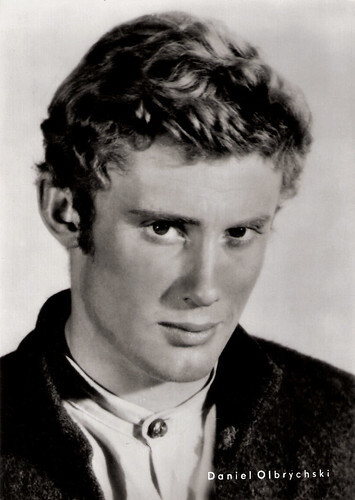
East-German postcard by VEB Progress Filmvertrieb, Berlin, no. 117/73, 1973. Retail price: 0,20 M.
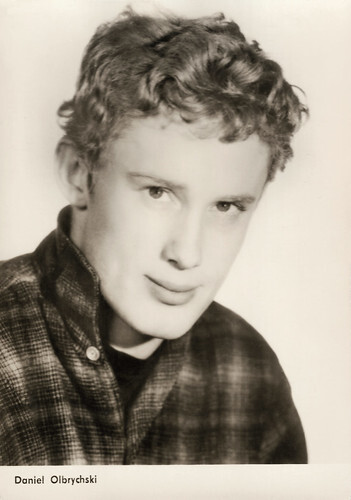
East German starfoto by VEB Progress Film-Verleih, Berlin, no. 2937, 1967.
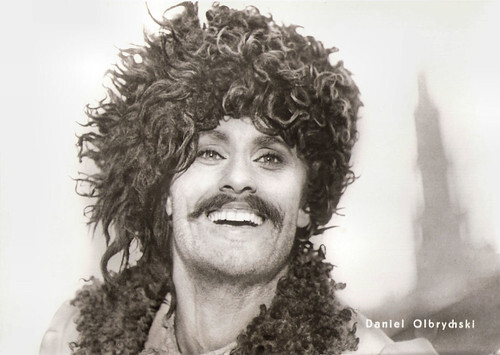
East German Starfoto by VEB Progress Film-Verleih, Berlin, no. 102/75. Daniel Olbrychski in Potop / The Deluge (Jerzy Hoffman, 1974).

East German Starfoto by VEB Progress Film-Verleih, Berlin, no. 133/75. Photo: Linke.
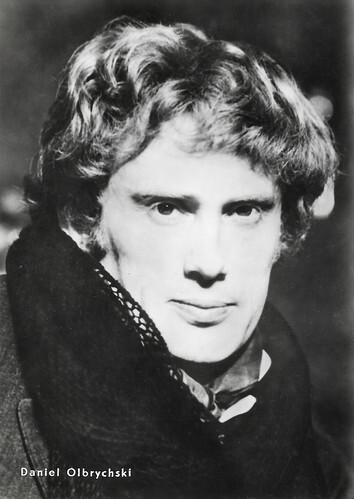
East German Starfoto by VEB Progress Film-Verleih, Berlin, no. 118/76. Photo: Linke.
Andrzej Wajda
Daniel Marcel Olbrychski was born in Łowicz, Poland, in 1945 as the son of Franciszek Olbrychski and Klementyna Sołonowicz-Olbrychska. He had an older brother, Krzysztof (1939–2017), who was a physicist. Daniel attended the Gimnazjum i Liceum im. Stefana Batorego (the Stefan Batory Gymnasium and Lyceum) in Warsaw. He has been practising boxing since his youth, and he also trained in fencing, badminton and judo. In the years 1963 and 1964, he performed at the Teatrem Młodzieżowym TVP (the Youth Theatre of the Polish Television) under the direction of Andrzej Konic. He started to attend the Państwowa Wyższa Szkoła Teatralna (Academy of Dramatic Arts in Warsaw), but never finished his studies.
In 1964, his film career started at the age of 18 with the war film Ranny w lesie / Wounded in the Forest (Janusz Nasfeter, 1964). A year later, he worked for the first time with director Andrzej Wajda at the Western-style war epic Popioły / The Ashes (Andrzej Wajda, 1965), which was entered into the 1966 Cannes Film Festival. He also appeared in Wajda’s Wszystko na sprzedaż / Everything for Sale (Andrzej Wajda, 1969) with Beata Tyszkiewicz , and the comedy Polowanie na muchy / Hunting Flies (Andrzej Wajda, 1969). He then had the lead in the drama Życie rodzinne /F amily Life (Krzysztof Zanussi, 1971). He also performed at the Powszechny Theatre and later at the National Theatre in Warsaw.
He starred in the drama Krajobraz po bitwie / Landscape After the Battle (Andrzej Wajda, 1970), the story of a Nazi German concentration camp survivor soon after liberation, residing in a DP camp somewhere in Germany. The film is based on the writings of Holocaust survivor and Polish author Tadeusz Borowski. Olbrychski also starred in the drama Brzezina / The Birch Wood (Andrzej Wajda, 1970), based on a novel by Jarosław Iwaszkiewicz. It was entered into the 7th Moscow International Film Festival, where Andrzej Wajda won the Golden Prize for Direction and Daniel Olbrychski won the award for Best Actor.
They also worked together on the German drama Pilatus und andere - Ein Film für Karfreitag / Pilate and Others (Andrzej Wajda, 1972), based on the 1967 novel 'The Master and Margarita' by the Soviet writer Mikhail Bulgakov. Then followed Wesele / The Wedding (Andrzej Wajda, 1972), an adaptation of a play by Stanisław Wyspiański which Wajda also directed for the theatre. Wesele describes the perils of the national drive toward self-determination after the Polish uprisings of November 1830 and January 1863, the result of the Partitions of Poland. Ziemia Obiecana / The Promised Land (Andrzej Wajda, 1975) is a drama based on a novel by Władysław Reymont. Set in the industrial city of Łódź, The Promised Land tells the story of a Pole, a German, and a Jew struggling to build a factory in the raw world of 19th-century capitalism.
Very popular was the Polish-Soviet historical drama Potop / The Deluge (Jerzy Hoffman, 1974), based on the 1886 novel by Henryk Sienkiewicz. It was nominated for the Academy Award for Best Foreign Language Film at the 47th Academy Awards, but lost to Amarcord (Federico Fellini, 1973). The film is the third most popular in the history of Polish cinema, with some 28 million tickets sold in Poland and 30.5 million in the Soviet Union. Olbrychski also starred in Panny z Wilka / The Maids of Wilko (Andrzej Wajda, 1979), which was nominated for the Academy Award for Best Foreign Language Film. Daniel Olbrychski then played one of the leads in Volker Schlöndorff's masterpiece Die Blechtrommel / The Tin Drum (1979), based on Günter Grass' novel. The Tin Drum was one of the most financially successful German films of the 1970s. It won the 1979 Academy Award for Best Foreign Language Film and was jointly awarded the Palme d'Or at the 1979 Cannes Film Festival, along with Apocalypse Now (Francis Ford Coppola, 1979).
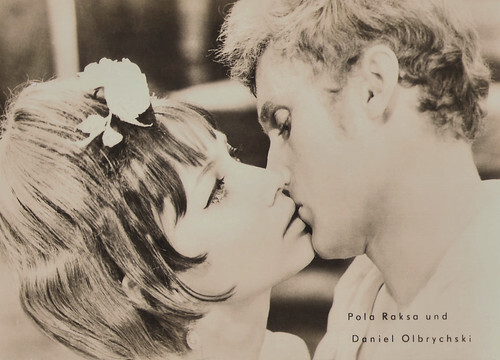
East German starfoto by VEB Progress Film-Verleih, Berlin, no. 182/70. Daniel Olbrychski and Pola Raksa in Popioly / The Ashes (Andrzej Wajda, 1965).
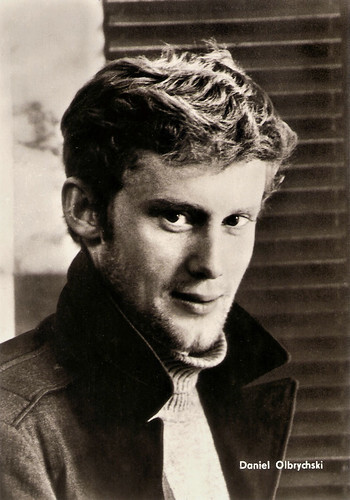
East-German postcard by VEB Progress Filmvertrieb, Berlin, no. 3191, 1968. Retail price: 0,20 M. Photo: Balinski.

East-German Starfoto by VEB Progress, no. EVP M 20. Daniel Olbrychski in Pan Wołodyjowski (Jerzy Hoffman 1969), based on the eponymous novel by Henrik Sienkiewicz. The story is set during the Ottoman Empire's invasion of Poland in 1668–1672. Olbrychski played Azja Tuhajbejowicz, the rival and antagonist of the leading character, Michał Wołodyjowski, played by Tadeusz Łomnicki. The film competed at the 6th Moscow International Film Festival, where Lomnicki won the Prize for Best Actor.
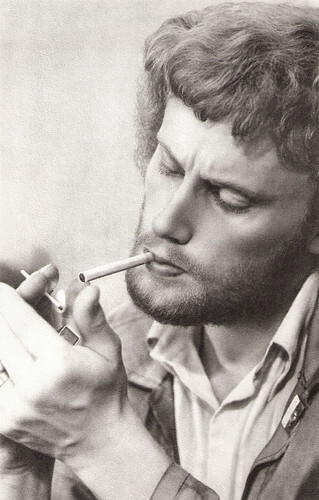
Russian postcard, no. 108/75.
Hot-tempered patriot
IMDb describes Daniel Olbrychski as a ‘hot-tempered patriot’, who would enjoy horseback riding on town centre squares. Another amusing anecdote is that once a picture of Olbrychski as an SS-man was displayed in a contemporary art exhibition. As soon as he knew this, he went armed with a sabre and with a TV news crew to the exhibition room, where he cut down his portrait, ending its existence. In the 1980s, he gradually switched from leads to supporting roles. He appeared in the popular French musical epic Les Uns et les Autres / Bolero: Dance of Life (Claude Lelouch, 1981).
His other West-European films include La Truite / The Trout (Joseph Losey, 1982), starring Isabelle Huppert , Eine Liebe in Deutschland / A Love in Germany (Andrzej Wajda, 1983) with Hanna Schygulla , La Diagonale du fou / Dangerous Moves (Richard Dembo, 1984) starring Michel Piccoli , and Die Geduld der Rosa Luxemburg / Rosa Luxemburg (Margarethe von Trotta, 1986) featuring Barbara Sukowa. Rosa Luxemburg received the German Film Award (Bundesfilmpreis) as best feature film. In 1986, Olbrychski received the French L'Ordre national de la Légion d'honneur (Legion of Honour). In Italy, he made the drama Mosca addio / Farewell Moscow (Mauro Bolognini, 1987) based on the life of Russian Jew Ida Nudel. For this film, Liv Ullmann was awarded a David di Donatello for Best Actress.
He then had his American debut in The Unbearable Lightness of Being (Philip Kaufman, 1988), the successful film adaptation of the novel by Milan Kundera starring Daniel Day-Lewis . He also appeared in the third of the ten episodes in Krzysztof Kieślowski's classic Polish TV series Dekalog / The Decalogue (1988). His films during the 1990s were less prominent. In 1998, he played a supporting role in Nikita Mikhalkov's film Sibirskiy tsiryulnik / The Barber of Siberia. He also had a part in the Polish historical drama Ogniem i Mieczem / With Fire and Sword (Jerzy Hoffman, 1999), based on a novel by Henryk Sienkiewicz and starring ‘Bond girl’ Izabella Scorupco. At the time of its filming, it was the most expensive Polish film ever made.
Olbrychski and Wajda reunited for Pan Tadeusz / Pan Tadeusz: The Last Foray in Lithuania (Andrzej Wajda, 1999), based on the epic poem by Polish poet, writer and philosopher Adam Mickiewicz, and for the comedy Zemsta / The Revenge (Andrzej Wajda, 2002), an adaptation of a popular stage farce of Aleksander Fredro with director Roman Polanski in the lead role. In 2007, Olbrychski received the Stanislavsky Award at the 29th Moscow International Film Festival for his outstanding achievement in the career of acting and devotion to the principles of Stanislavsky's school. Remarkable was his part as the sinister Russian defector who accuses Angelina Jolie of being a Russian spy in the American action thriller Salt (Philip Noyce, 2010). Later, he appeared in the German film Wintertochter (Johannes Schmid, 2011), the Polish historical film Bitwa warszawska 1920 / Battle of Warsaw 1920 (Jerzy Hoffman, 2011) the Russian biopic Legenda No. 17 / Legend No. 17 (Nikolay Lebedev, 2013), about Russian ice hockey legend Valeri Kharlamov, and DJ (Alek Kort, 2018), inspired by the life of the the Polish underground DJ Mini. His most recent film is Powstaniec 1863 / Insurgent 1863 (Tadeusz Syka, 2024) about the legendary Polish priest, chaplain and general, Father Stanislaw Brzoska.
Daniel Olbrychski married three times. His first wife was Monika Dzienisiewicz-Olbrychska (1967-1977), with whom he has a son, actor and musician Rafał Olbrychski (1971). His second wife was Zuzanna Lapicka (1978-1988), with whom he has a daughter, Weronika (1982). Since 2003, he has been married to Krystyna Demska. He is also the father of Viktor Sukowa, from a relationship with German actress Barbara Sukowa. In the mid-1970s, he had a 3-year relationship with singer Maryla Rodowicz. During the 2015 Polish presidential election, he endorsed the candidacy of Bronisław Komorowski. Olbrychski supports the LGBT community.
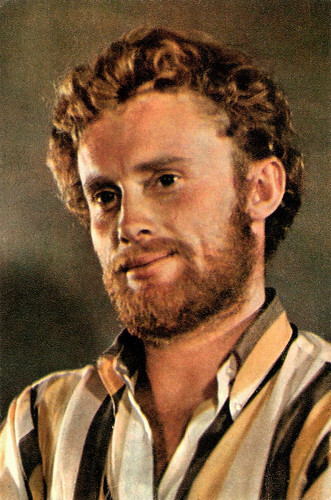
Russian postcard, no. 4215, 1975
.
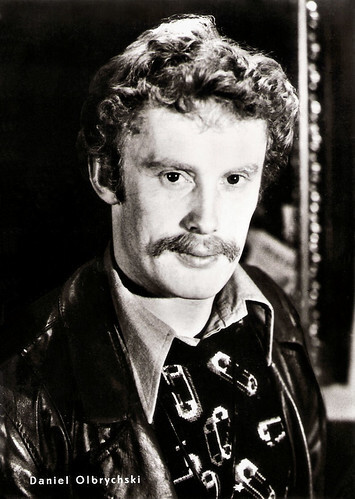
East German starfoto by VEB Progress Film-Verleih, Berlin, no. 26/78. Photo: Linke.
Trailer Krajobraz po bitwie / Landscape After the Battle (1970). Source: Szizalaki (YouTube).
Trailer Salt (2010). Source: Sony Pictures Entertainment (YouTube).
Sources: Sandra Brennan (AllMovie - Page now defunct), Film Polski (Polish), Wikipedia (English and Polish) and IMDb.

East-German postcard by VEB Progress Filmvertrieb, Berlin, no. 117/73, 1973. Retail price: 0,20 M.

East German starfoto by VEB Progress Film-Verleih, Berlin, no. 2937, 1967.

East German Starfoto by VEB Progress Film-Verleih, Berlin, no. 102/75. Daniel Olbrychski in Potop / The Deluge (Jerzy Hoffman, 1974).

East German Starfoto by VEB Progress Film-Verleih, Berlin, no. 133/75. Photo: Linke.

East German Starfoto by VEB Progress Film-Verleih, Berlin, no. 118/76. Photo: Linke.
Andrzej Wajda
Daniel Marcel Olbrychski was born in Łowicz, Poland, in 1945 as the son of Franciszek Olbrychski and Klementyna Sołonowicz-Olbrychska. He had an older brother, Krzysztof (1939–2017), who was a physicist. Daniel attended the Gimnazjum i Liceum im. Stefana Batorego (the Stefan Batory Gymnasium and Lyceum) in Warsaw. He has been practising boxing since his youth, and he also trained in fencing, badminton and judo. In the years 1963 and 1964, he performed at the Teatrem Młodzieżowym TVP (the Youth Theatre of the Polish Television) under the direction of Andrzej Konic. He started to attend the Państwowa Wyższa Szkoła Teatralna (Academy of Dramatic Arts in Warsaw), but never finished his studies.
In 1964, his film career started at the age of 18 with the war film Ranny w lesie / Wounded in the Forest (Janusz Nasfeter, 1964). A year later, he worked for the first time with director Andrzej Wajda at the Western-style war epic Popioły / The Ashes (Andrzej Wajda, 1965), which was entered into the 1966 Cannes Film Festival. He also appeared in Wajda’s Wszystko na sprzedaż / Everything for Sale (Andrzej Wajda, 1969) with Beata Tyszkiewicz , and the comedy Polowanie na muchy / Hunting Flies (Andrzej Wajda, 1969). He then had the lead in the drama Życie rodzinne /F amily Life (Krzysztof Zanussi, 1971). He also performed at the Powszechny Theatre and later at the National Theatre in Warsaw.
He starred in the drama Krajobraz po bitwie / Landscape After the Battle (Andrzej Wajda, 1970), the story of a Nazi German concentration camp survivor soon after liberation, residing in a DP camp somewhere in Germany. The film is based on the writings of Holocaust survivor and Polish author Tadeusz Borowski. Olbrychski also starred in the drama Brzezina / The Birch Wood (Andrzej Wajda, 1970), based on a novel by Jarosław Iwaszkiewicz. It was entered into the 7th Moscow International Film Festival, where Andrzej Wajda won the Golden Prize for Direction and Daniel Olbrychski won the award for Best Actor.
They also worked together on the German drama Pilatus und andere - Ein Film für Karfreitag / Pilate and Others (Andrzej Wajda, 1972), based on the 1967 novel 'The Master and Margarita' by the Soviet writer Mikhail Bulgakov. Then followed Wesele / The Wedding (Andrzej Wajda, 1972), an adaptation of a play by Stanisław Wyspiański which Wajda also directed for the theatre. Wesele describes the perils of the national drive toward self-determination after the Polish uprisings of November 1830 and January 1863, the result of the Partitions of Poland. Ziemia Obiecana / The Promised Land (Andrzej Wajda, 1975) is a drama based on a novel by Władysław Reymont. Set in the industrial city of Łódź, The Promised Land tells the story of a Pole, a German, and a Jew struggling to build a factory in the raw world of 19th-century capitalism.
Very popular was the Polish-Soviet historical drama Potop / The Deluge (Jerzy Hoffman, 1974), based on the 1886 novel by Henryk Sienkiewicz. It was nominated for the Academy Award for Best Foreign Language Film at the 47th Academy Awards, but lost to Amarcord (Federico Fellini, 1973). The film is the third most popular in the history of Polish cinema, with some 28 million tickets sold in Poland and 30.5 million in the Soviet Union. Olbrychski also starred in Panny z Wilka / The Maids of Wilko (Andrzej Wajda, 1979), which was nominated for the Academy Award for Best Foreign Language Film. Daniel Olbrychski then played one of the leads in Volker Schlöndorff's masterpiece Die Blechtrommel / The Tin Drum (1979), based on Günter Grass' novel. The Tin Drum was one of the most financially successful German films of the 1970s. It won the 1979 Academy Award for Best Foreign Language Film and was jointly awarded the Palme d'Or at the 1979 Cannes Film Festival, along with Apocalypse Now (Francis Ford Coppola, 1979).

East German starfoto by VEB Progress Film-Verleih, Berlin, no. 182/70. Daniel Olbrychski and Pola Raksa in Popioly / The Ashes (Andrzej Wajda, 1965).

East-German postcard by VEB Progress Filmvertrieb, Berlin, no. 3191, 1968. Retail price: 0,20 M. Photo: Balinski.

East-German Starfoto by VEB Progress, no. EVP M 20. Daniel Olbrychski in Pan Wołodyjowski (Jerzy Hoffman 1969), based on the eponymous novel by Henrik Sienkiewicz. The story is set during the Ottoman Empire's invasion of Poland in 1668–1672. Olbrychski played Azja Tuhajbejowicz, the rival and antagonist of the leading character, Michał Wołodyjowski, played by Tadeusz Łomnicki. The film competed at the 6th Moscow International Film Festival, where Lomnicki won the Prize for Best Actor.

Russian postcard, no. 108/75.
Hot-tempered patriot
IMDb describes Daniel Olbrychski as a ‘hot-tempered patriot’, who would enjoy horseback riding on town centre squares. Another amusing anecdote is that once a picture of Olbrychski as an SS-man was displayed in a contemporary art exhibition. As soon as he knew this, he went armed with a sabre and with a TV news crew to the exhibition room, where he cut down his portrait, ending its existence. In the 1980s, he gradually switched from leads to supporting roles. He appeared in the popular French musical epic Les Uns et les Autres / Bolero: Dance of Life (Claude Lelouch, 1981).
His other West-European films include La Truite / The Trout (Joseph Losey, 1982), starring Isabelle Huppert , Eine Liebe in Deutschland / A Love in Germany (Andrzej Wajda, 1983) with Hanna Schygulla , La Diagonale du fou / Dangerous Moves (Richard Dembo, 1984) starring Michel Piccoli , and Die Geduld der Rosa Luxemburg / Rosa Luxemburg (Margarethe von Trotta, 1986) featuring Barbara Sukowa. Rosa Luxemburg received the German Film Award (Bundesfilmpreis) as best feature film. In 1986, Olbrychski received the French L'Ordre national de la Légion d'honneur (Legion of Honour). In Italy, he made the drama Mosca addio / Farewell Moscow (Mauro Bolognini, 1987) based on the life of Russian Jew Ida Nudel. For this film, Liv Ullmann was awarded a David di Donatello for Best Actress.
He then had his American debut in The Unbearable Lightness of Being (Philip Kaufman, 1988), the successful film adaptation of the novel by Milan Kundera starring Daniel Day-Lewis . He also appeared in the third of the ten episodes in Krzysztof Kieślowski's classic Polish TV series Dekalog / The Decalogue (1988). His films during the 1990s were less prominent. In 1998, he played a supporting role in Nikita Mikhalkov's film Sibirskiy tsiryulnik / The Barber of Siberia. He also had a part in the Polish historical drama Ogniem i Mieczem / With Fire and Sword (Jerzy Hoffman, 1999), based on a novel by Henryk Sienkiewicz and starring ‘Bond girl’ Izabella Scorupco. At the time of its filming, it was the most expensive Polish film ever made.
Olbrychski and Wajda reunited for Pan Tadeusz / Pan Tadeusz: The Last Foray in Lithuania (Andrzej Wajda, 1999), based on the epic poem by Polish poet, writer and philosopher Adam Mickiewicz, and for the comedy Zemsta / The Revenge (Andrzej Wajda, 2002), an adaptation of a popular stage farce of Aleksander Fredro with director Roman Polanski in the lead role. In 2007, Olbrychski received the Stanislavsky Award at the 29th Moscow International Film Festival for his outstanding achievement in the career of acting and devotion to the principles of Stanislavsky's school. Remarkable was his part as the sinister Russian defector who accuses Angelina Jolie of being a Russian spy in the American action thriller Salt (Philip Noyce, 2010). Later, he appeared in the German film Wintertochter (Johannes Schmid, 2011), the Polish historical film Bitwa warszawska 1920 / Battle of Warsaw 1920 (Jerzy Hoffman, 2011) the Russian biopic Legenda No. 17 / Legend No. 17 (Nikolay Lebedev, 2013), about Russian ice hockey legend Valeri Kharlamov, and DJ (Alek Kort, 2018), inspired by the life of the the Polish underground DJ Mini. His most recent film is Powstaniec 1863 / Insurgent 1863 (Tadeusz Syka, 2024) about the legendary Polish priest, chaplain and general, Father Stanislaw Brzoska.
Daniel Olbrychski married three times. His first wife was Monika Dzienisiewicz-Olbrychska (1967-1977), with whom he has a son, actor and musician Rafał Olbrychski (1971). His second wife was Zuzanna Lapicka (1978-1988), with whom he has a daughter, Weronika (1982). Since 2003, he has been married to Krystyna Demska. He is also the father of Viktor Sukowa, from a relationship with German actress Barbara Sukowa. In the mid-1970s, he had a 3-year relationship with singer Maryla Rodowicz. During the 2015 Polish presidential election, he endorsed the candidacy of Bronisław Komorowski. Olbrychski supports the LGBT community.

Russian postcard, no. 4215, 1975
.

East German starfoto by VEB Progress Film-Verleih, Berlin, no. 26/78. Photo: Linke.
Trailer Krajobraz po bitwie / Landscape After the Battle (1970). Source: Szizalaki (YouTube).
Trailer Salt (2010). Source: Sony Pictures Entertainment (YouTube).
Sources: Sandra Brennan (AllMovie - Page now defunct), Film Polski (Polish), Wikipedia (English and Polish) and IMDb.
Published on August 31, 2025 22:00
August 30, 2025
La Collectionneuse: Claudia Victrix
In the 1920s, French newspapers and magazines rhapsodised about Claudia Victrix’s achievements. As an actress, she was "a dazzling star of the cinema firmament" noted for her "terribly modern, yet eternal, sensibility", her "invaluable talent", her "intensity and measured realism", her "absolute grace" and her "great style". About Claudia, the opera singer, a rave review of one of her charity concerts in 'Tosca' in 1925 read like this: "With a science and an authority which cause a bewitching astonishment, Madame Claudia Victrix achieves an admirable unity of performing. Her voice multiplies tones, from the warmth and mellowness of a contralto to the clear crystal of a soprano, as well as the moving timbre of a Falcon-soprano". No less! Did those laudatory critics reflect the truth? As we will see, Claudia Victrix benefited from influential support, which may explain that flurry of praise.

Belgian postcard by Uitgave Weekblad 'Cinéma', Antwerpen. Claudia Victrix as Princess Masha in La princesse Masha (René Leprince, 1927).
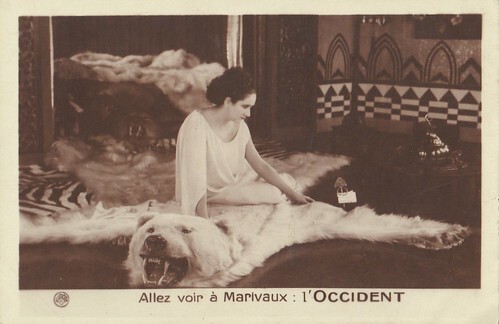
French promotional postcard by Europe for the release of L’Occident / The West (Henri Fescourt, 1928) at the Cinéma Marivaux in Paris.
The most powerful press magnate in Paris
French actor and director René Navarre once described Claudia Victrix, towards whom he admitted feeling great sympathy, as "a woman of tremendous will who, after having set her goal, reached it through thick and thin".
When she married the most powerful press magnate in Paris, she knew that her time had come and that she could become famous.
She first set her sights on opera and then chose to be a movie star.
It helped, of course, that her husband was president of the consortium of the major Paris daily newspapers, which assured her of a wide press coverage, and that he also owned a film company.
However, she never became a Callas or a Garbo, but an interesting and colourful character she certainly was!
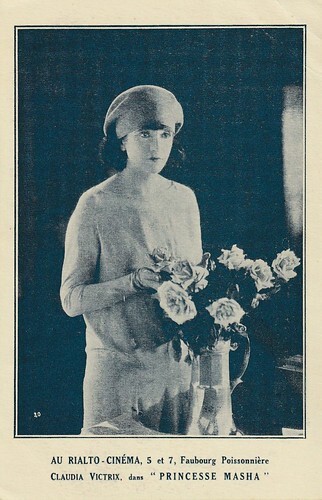
French promotional postcard for the release of Princesse Masha / Princess Masha (René Leprince, 1927) at the Rialto-Cinéma in Paris, no. 20.
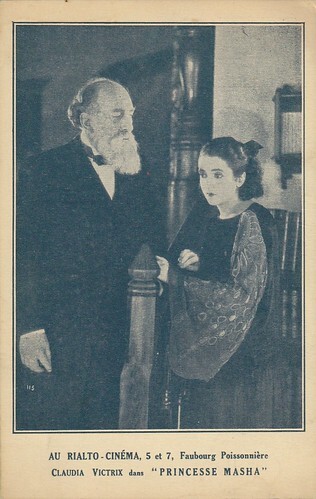
French promotional postcard for the release of Princesse Masha / Princess Masha (René Leprince, 1927) at the Rialto-Cinéma in Paris, no. 115.
Juana Borguèse
Claudia Victrix was born an illegitimate child as Jeanne Renée Marie Bourgeois on the 25th of May 1888 in Le Havre, France.
Her parents, Gustave Bourgeois and Léontine Pion, only got married in 1899.
In 1917, she made her film debut by playing the role of the evil baronne d’Apremont in Louis Feuillade ’s serial La nouvelle mission de Judex / The New Mission of Judex (1917-1918). At the time, she used the pseudonym of Juana Borguèse, which was simply an 'exotic' version of her birth name, Juana being the Hispanic version of Jeanne and Borghese meaning Bourgeois in Italian.
According to writer and playwright Armand Salacrou, she had substituted a 'u' for the 'h' after the Italian Borghese family had threatened to sue her if she used the usual spelling of their famous name.
Salacrou claimed to have met her for the first time in the second half of the 1910s at a dinner party organised by the lady-owner of Le Chabanais, who was at the time one of the most luxurious and costly brothels in Paris. He also implies in his memoirs that, at one time, Jeanne sold her charms to wealthy men (we leave him the full responsibility for this assertion) and also mentions that she performed occasionally on stage.
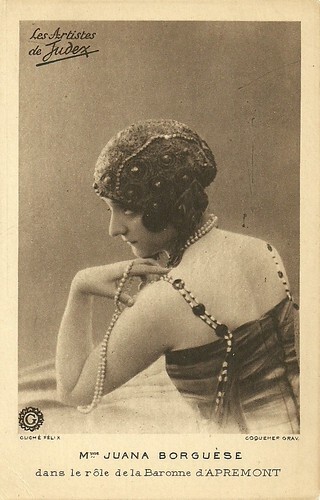
French postcard by Coquemer Gravures, Paris. Photo: Félix / Gaumont. Juana Borguèse as the evil Baronne d'Apremont in La nouvelle mission de Judex / The New Mission of Judex (Louis Feuillade, 1917-1918). Collection: Ivo Blom.
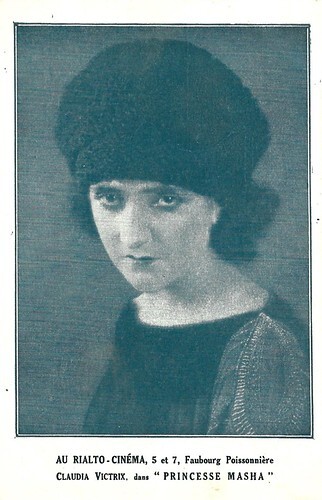
French postcard. Claudia Victrix in the French silent film Princesse Masha (René Leprince, 1927). Publicity for the film's screening at the Paris-based cinema Rialto.
Jean Sapène: the man who would change her life
Around 1920, Jeanne Bourgeois became the mistress of Jean Sapène, 21 years her senior, a powerful French press magnate who, since the end of the 1910s, had started to invest in the film world. This relationship would change her life.
At her request, Sapène allegedly asked actor and director René Navarre if he could consider hiring Jeanne for the role of Empress Joséphine de Beauharnais in L’Aiglonne, a film he was planning to shoot. Navarre tells in his memoirs how he screen-tested her, liked the results and signed her for the part.
However, he soon got the feeling that Sapène was somehow not especially keen on launching Jeanne’s movie career and that he mostly wanted her to devote most of her time to him, and not to film work.
After a meeting with Sapène and Jeanne, Navarre released her from her contract, and another actress played Joséphine in L’Aiglonne (1921).
In January 1923, Jeanne married Sapène, and they had a daughter, Anita, in 1930. Previously, she had been married the first time in 1911 and had divorced in 1914.

French postcard. Claudia Victrix in Princesse Masha (René Leprince, 1927). Publicity for the film's screening at the Paris-based cinema Rialto. Collection: Ivo Blom.

French postcard by Europe for L'Occident (Henri Fescourt, 1928), no. 41 with Claudia Victrix and Hugues de Bagratide. The card makes publicity for the film's premiere screening at the Paris cinema Marivaux. Collection: Ivo Blom.
Jeanne becomes opera singer Claudia Victrix
An ambitious and resolute woman, Jeanne Bourgeois soon opted for an operatic career.
After intensive singing lessons, she made her prima donna debut in 1924. For her new career, she chose another flamboyant pseudonym, Claudia Victrix, the Latin word 'victrix' meaning 'victorious'.
But Claudia never reached the fame of opera stars such as Geraldine Farrar , Mary Garden or Maria Jeritza. She was mostly considered a 'cantatrice mondaine' ( a 'society singer'), who mainly specialised in charity concerts.
She notably performed in Henri Février’s 'Monna Vanna', Massenet’s 'La Navarraise' and 'Sapho' and Puccini’s 'Tosca'. Interestingly enough, it seems that no music label ever asked her to make a record. So, we will never be able to judge for ourselves her singing talents.
However, famous and witty French screenwriter Henri Jeanson’s opinion was decisive: "If I had such a voice, I would hang myself with my vocal chords". Nevertheless, probably on Sapène’s suggestion, she was awarded the Légion d’Honneur by the French government in 1927 for her commitment to charities.
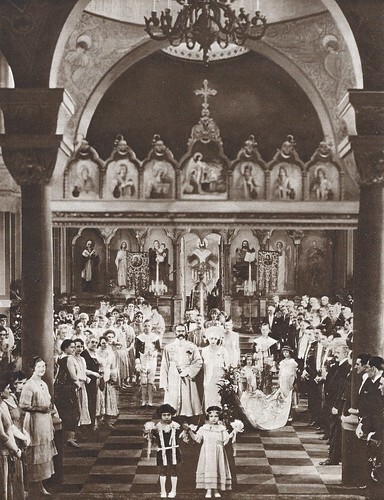
French film journal 'La Petite Illustration', no. 345, 13 August 1927, p. 8. Jean Toulout as General Prince Tcherkoff and Claudia Victrix as Princess Masha in La princesse Masha (René Leprince, 1927). Collection: Ivo Blom.
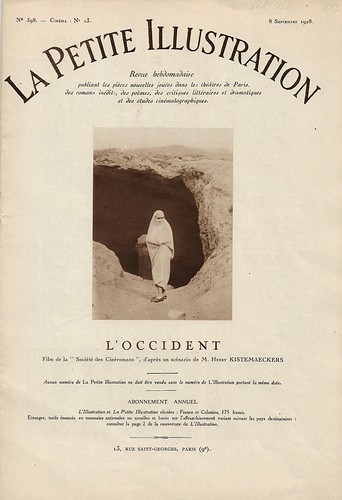
French film journal 'La Petite Illustration', no. 398, 8 September 1928. Special issue on L'Occident / The West (Henri Fescourt, 1928). Collection: Ivo Blom.
Movie star
Claudia Victrix, who was pushing 40, hadn’t said her last word as far as movies were concerned and decided that the right moment had come to turn into a film star. This time, in view of his wife’s strong determination, Sapène didn’t - or couldn’t - object. So, she starred in three films, Princesse Masha (1927), L’Occident / The West (1928) and La Tentation (1929). They were all produced by the Société des Cinéromans, a company directed by Sapène since 1922, and benefited from a wide press coverage, thanks to her husband.
L’Occident had already been filmed in the U.S.A. with Alla Nazimova in 1918 under the title Eye for Eye. Henri Fescourt, who directed L’Occident, later made this telling remark: "My approach to film acting didn’t match with that of Claudia Victrix, Sapène’s influential wife". According to Armand Salacrou, Parisian spiteful tongues of the time allegedly had renamed the movie L’Accident instead of L’Occident.
As a whole, film critics showed a great deal of benevolence towards the new star and were keen not to incur influential Sapène’s wrath. They certainly remembered that, in 1926, he had sued Léon Moussinac, who had lambasted, in the Communist newspaper L’Humanité, a film distributed by the Société des Cinéromans. But, despite all the publicity, Claudia never really caught on with audiences. The dithyrambic reviews hardly convinced the public that she was the epitome of talent and beauty touted by Sapène’s marketing department.
Regarding her extant movies, reviewers are nowadays not that enthusiastic, to say the least. In 2016, the catalogue of the Pordenone 'Giornate del cinema muto' festival describes her as "insipid and talentless". The website 'Ann Harding’s treasures' is even harsher: "totally incompetent", "as expressive as a log", "she can’t move, she is clumsy, awkward, and, furthermore, she is not at all photogenic, with a long nose, a heart-shaped mouth and an unattractive face".
Claudia Victrix never made another film. In March 1929, Jean Sapène sold his Société des Cinéromans to Bernard Natan, and she thus lost her main support. No other film producer seemed to be interested in employing her.
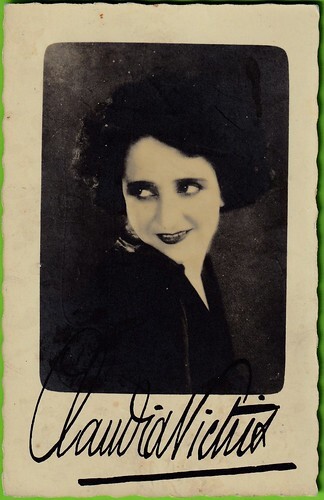
French autographed postcard.
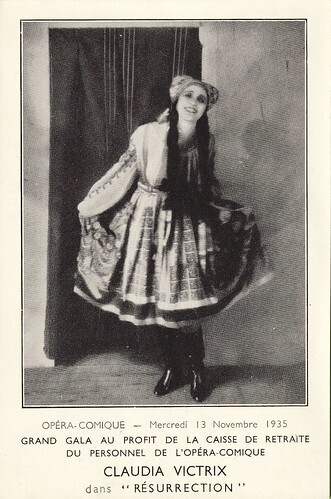
French 1935 promotional postcard for one of Claudia Victrix's charity concerts, at the Opéra-Comique in Franco Alfano’s 'Résurrection'.
An original until the end
Afterwards, Claudia Victrix still appeared now and then on stage, such as in 'La dame aux camélias' in 1933 at the Théâtre Sarah Bernhardt or in Franco Alfano’s 'Résurrection' in 1935 at the Opéra-Comique.
Famous writer Colette , who didn’t like 'La dame aux camélias', which she found much too old-fashioned, wrote, after viewing her in the play: "She curbs her gestures, her voice, her gait, she has even tamed her magnificent hair! She would do better to tackle a realistic and modern role. I know we can advise Madame Claudia Victrix on such an initiative. It’s not success that entices her, but rather endeavour and even the boldest challenge".
For the record, Jean Sapène had been Henry de Jouvenel’s witness when he married Colette in 1912, and she was, from 1919 to 1924, literary editor at 'Le Matin', one of Sapène’s newspapers.
Claudia soon divorced Sapène, who remarried in 1938, and, thereafter, she led a quiet life, well free from want. She passed away on the 20th of April 1976 and was interred at the Boulogne-Billancourt West Cemetery.
Even in death, she remained an original: her tomb is a replica of the monument erected in the Paris Dome Church at Les Invalides to keep the remains of French Emperor Napoléon I.
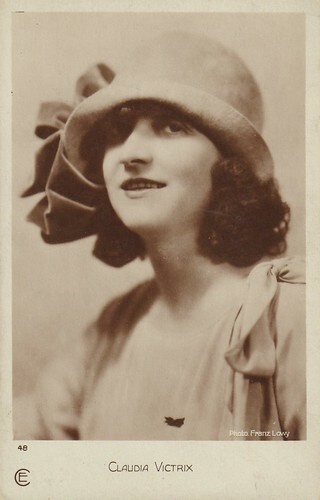
French postcard by Cinémagazine-Edition no. 48. Photo: Franz Lowy.
Text and postcards: Marlene Pilaete (unless captioned otherwise).

Belgian postcard by Uitgave Weekblad 'Cinéma', Antwerpen. Claudia Victrix as Princess Masha in La princesse Masha (René Leprince, 1927).

French promotional postcard by Europe for the release of L’Occident / The West (Henri Fescourt, 1928) at the Cinéma Marivaux in Paris.
The most powerful press magnate in Paris
French actor and director René Navarre once described Claudia Victrix, towards whom he admitted feeling great sympathy, as "a woman of tremendous will who, after having set her goal, reached it through thick and thin".
When she married the most powerful press magnate in Paris, she knew that her time had come and that she could become famous.
She first set her sights on opera and then chose to be a movie star.
It helped, of course, that her husband was president of the consortium of the major Paris daily newspapers, which assured her of a wide press coverage, and that he also owned a film company.
However, she never became a Callas or a Garbo, but an interesting and colourful character she certainly was!

French promotional postcard for the release of Princesse Masha / Princess Masha (René Leprince, 1927) at the Rialto-Cinéma in Paris, no. 20.

French promotional postcard for the release of Princesse Masha / Princess Masha (René Leprince, 1927) at the Rialto-Cinéma in Paris, no. 115.
Juana Borguèse
Claudia Victrix was born an illegitimate child as Jeanne Renée Marie Bourgeois on the 25th of May 1888 in Le Havre, France.
Her parents, Gustave Bourgeois and Léontine Pion, only got married in 1899.
In 1917, she made her film debut by playing the role of the evil baronne d’Apremont in Louis Feuillade ’s serial La nouvelle mission de Judex / The New Mission of Judex (1917-1918). At the time, she used the pseudonym of Juana Borguèse, which was simply an 'exotic' version of her birth name, Juana being the Hispanic version of Jeanne and Borghese meaning Bourgeois in Italian.
According to writer and playwright Armand Salacrou, she had substituted a 'u' for the 'h' after the Italian Borghese family had threatened to sue her if she used the usual spelling of their famous name.
Salacrou claimed to have met her for the first time in the second half of the 1910s at a dinner party organised by the lady-owner of Le Chabanais, who was at the time one of the most luxurious and costly brothels in Paris. He also implies in his memoirs that, at one time, Jeanne sold her charms to wealthy men (we leave him the full responsibility for this assertion) and also mentions that she performed occasionally on stage.

French postcard by Coquemer Gravures, Paris. Photo: Félix / Gaumont. Juana Borguèse as the evil Baronne d'Apremont in La nouvelle mission de Judex / The New Mission of Judex (Louis Feuillade, 1917-1918). Collection: Ivo Blom.

French postcard. Claudia Victrix in the French silent film Princesse Masha (René Leprince, 1927). Publicity for the film's screening at the Paris-based cinema Rialto.
Jean Sapène: the man who would change her life
Around 1920, Jeanne Bourgeois became the mistress of Jean Sapène, 21 years her senior, a powerful French press magnate who, since the end of the 1910s, had started to invest in the film world. This relationship would change her life.
At her request, Sapène allegedly asked actor and director René Navarre if he could consider hiring Jeanne for the role of Empress Joséphine de Beauharnais in L’Aiglonne, a film he was planning to shoot. Navarre tells in his memoirs how he screen-tested her, liked the results and signed her for the part.
However, he soon got the feeling that Sapène was somehow not especially keen on launching Jeanne’s movie career and that he mostly wanted her to devote most of her time to him, and not to film work.
After a meeting with Sapène and Jeanne, Navarre released her from her contract, and another actress played Joséphine in L’Aiglonne (1921).
In January 1923, Jeanne married Sapène, and they had a daughter, Anita, in 1930. Previously, she had been married the first time in 1911 and had divorced in 1914.

French postcard. Claudia Victrix in Princesse Masha (René Leprince, 1927). Publicity for the film's screening at the Paris-based cinema Rialto. Collection: Ivo Blom.

French postcard by Europe for L'Occident (Henri Fescourt, 1928), no. 41 with Claudia Victrix and Hugues de Bagratide. The card makes publicity for the film's premiere screening at the Paris cinema Marivaux. Collection: Ivo Blom.
Jeanne becomes opera singer Claudia Victrix
An ambitious and resolute woman, Jeanne Bourgeois soon opted for an operatic career.
After intensive singing lessons, she made her prima donna debut in 1924. For her new career, she chose another flamboyant pseudonym, Claudia Victrix, the Latin word 'victrix' meaning 'victorious'.
But Claudia never reached the fame of opera stars such as Geraldine Farrar , Mary Garden or Maria Jeritza. She was mostly considered a 'cantatrice mondaine' ( a 'society singer'), who mainly specialised in charity concerts.
She notably performed in Henri Février’s 'Monna Vanna', Massenet’s 'La Navarraise' and 'Sapho' and Puccini’s 'Tosca'. Interestingly enough, it seems that no music label ever asked her to make a record. So, we will never be able to judge for ourselves her singing talents.
However, famous and witty French screenwriter Henri Jeanson’s opinion was decisive: "If I had such a voice, I would hang myself with my vocal chords". Nevertheless, probably on Sapène’s suggestion, she was awarded the Légion d’Honneur by the French government in 1927 for her commitment to charities.

French film journal 'La Petite Illustration', no. 345, 13 August 1927, p. 8. Jean Toulout as General Prince Tcherkoff and Claudia Victrix as Princess Masha in La princesse Masha (René Leprince, 1927). Collection: Ivo Blom.

French film journal 'La Petite Illustration', no. 398, 8 September 1928. Special issue on L'Occident / The West (Henri Fescourt, 1928). Collection: Ivo Blom.
Movie star
Claudia Victrix, who was pushing 40, hadn’t said her last word as far as movies were concerned and decided that the right moment had come to turn into a film star. This time, in view of his wife’s strong determination, Sapène didn’t - or couldn’t - object. So, she starred in three films, Princesse Masha (1927), L’Occident / The West (1928) and La Tentation (1929). They were all produced by the Société des Cinéromans, a company directed by Sapène since 1922, and benefited from a wide press coverage, thanks to her husband.
L’Occident had already been filmed in the U.S.A. with Alla Nazimova in 1918 under the title Eye for Eye. Henri Fescourt, who directed L’Occident, later made this telling remark: "My approach to film acting didn’t match with that of Claudia Victrix, Sapène’s influential wife". According to Armand Salacrou, Parisian spiteful tongues of the time allegedly had renamed the movie L’Accident instead of L’Occident.
As a whole, film critics showed a great deal of benevolence towards the new star and were keen not to incur influential Sapène’s wrath. They certainly remembered that, in 1926, he had sued Léon Moussinac, who had lambasted, in the Communist newspaper L’Humanité, a film distributed by the Société des Cinéromans. But, despite all the publicity, Claudia never really caught on with audiences. The dithyrambic reviews hardly convinced the public that she was the epitome of talent and beauty touted by Sapène’s marketing department.
Regarding her extant movies, reviewers are nowadays not that enthusiastic, to say the least. In 2016, the catalogue of the Pordenone 'Giornate del cinema muto' festival describes her as "insipid and talentless". The website 'Ann Harding’s treasures' is even harsher: "totally incompetent", "as expressive as a log", "she can’t move, she is clumsy, awkward, and, furthermore, she is not at all photogenic, with a long nose, a heart-shaped mouth and an unattractive face".
Claudia Victrix never made another film. In March 1929, Jean Sapène sold his Société des Cinéromans to Bernard Natan, and she thus lost her main support. No other film producer seemed to be interested in employing her.

French autographed postcard.

French 1935 promotional postcard for one of Claudia Victrix's charity concerts, at the Opéra-Comique in Franco Alfano’s 'Résurrection'.
An original until the end
Afterwards, Claudia Victrix still appeared now and then on stage, such as in 'La dame aux camélias' in 1933 at the Théâtre Sarah Bernhardt or in Franco Alfano’s 'Résurrection' in 1935 at the Opéra-Comique.
Famous writer Colette , who didn’t like 'La dame aux camélias', which she found much too old-fashioned, wrote, after viewing her in the play: "She curbs her gestures, her voice, her gait, she has even tamed her magnificent hair! She would do better to tackle a realistic and modern role. I know we can advise Madame Claudia Victrix on such an initiative. It’s not success that entices her, but rather endeavour and even the boldest challenge".
For the record, Jean Sapène had been Henry de Jouvenel’s witness when he married Colette in 1912, and she was, from 1919 to 1924, literary editor at 'Le Matin', one of Sapène’s newspapers.
Claudia soon divorced Sapène, who remarried in 1938, and, thereafter, she led a quiet life, well free from want. She passed away on the 20th of April 1976 and was interred at the Boulogne-Billancourt West Cemetery.
Even in death, she remained an original: her tomb is a replica of the monument erected in the Paris Dome Church at Les Invalides to keep the remains of French Emperor Napoléon I.

French postcard by Cinémagazine-Edition no. 48. Photo: Franz Lowy.
Text and postcards: Marlene Pilaete (unless captioned otherwise).
Published on August 30, 2025 22:00
August 29, 2025
Capitan Blanco (1914)
For Ivo Blom's 65th birthday, EFSP presents a very special find. At the last Cinema Ritrovato film market, Ivo found a complete series of 18 vintage postcards for the famous but lost Italian film Capitan Blanco / Il Capitan Blanco / Captain Blanco (1914). The film was directed by Nino Martoglio, possibly in co-direction with Roberto Danesi, for their joint production company, Morgana Film. Capitan Blanco was the first production by Morgana, founded in January 1914, and it was based on Martoglio's stage play 'Capitan Blanco / U paliu' (1906). Martoglio also wrote the script for the film. Ivo: "Sometimes, remaining postcards of a lost film may help in getting an idea of why certain films were so cherished in their time, or afterwards."
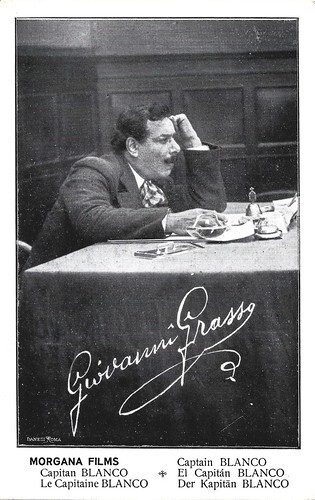
Italian postcard by Ed. Danesi, Roma. Giovanni Grasso in Capitan Blanco / Il Capitan Blanco (Nino Martoglio, Roberto Danesi, 1914).
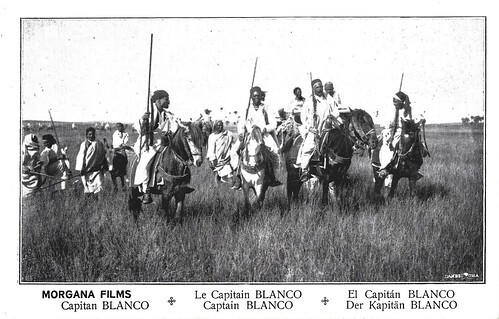
Italian postcard by Ed. Danesi, Roma. Scene from Capitan Blanco / Il Capitan Blanco (Nino Martoglio, Roberto Danesi, 1914).

Italian postcard by Ed. Danesi, Roma. Giovanni Grasso in Capitan Blanco / Il Capitan Blanco (Nino Martoglio, Roberto Danesi, 1914).
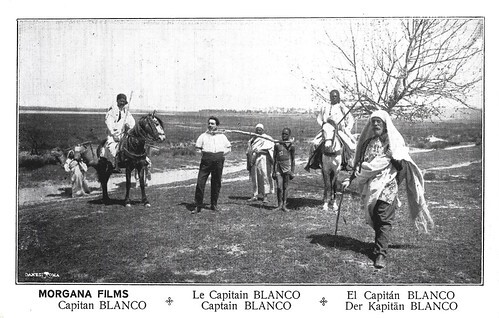
Italian postcard by Ed. Danesi, Roma. Scene from Capitan Blanco / Il Capitan Blanco (Nino Martoglio, Roberto Danesi, 1914).
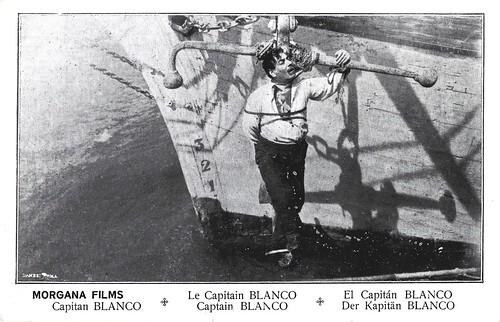
Italian postcard by Ed. Danesi, Roma. Giovanni Grasso in Capitan Blanco / Il Capitan Blanco (Nino Martoglio, Roberto Danesi, 1914).
A mighty sea wolf
For the shooting of Capitan Blanco / Il Capitan Blanco (Nino Martoglio, Roberto Danesi, 1914), production company Morgana Film used the Roman studios of the company Savoia for interiors. The exteriors were first shot in the newly conquered Tripolitania, a part of Libya and Italian since 1912, so the crew had to be guarded while working there. Later shots were taken in Sicily at Aci Castello, Aci Trezza, and Catania. The cinematography was done by Danesi.
The three leading actors were the Sicilians Giovanni Grasso as Capitan Blanco, Virginia Balistrieri in her film debut as Marta and Totò Majorana as Mauro. By then, Grasso was one of the most acclaimed Italian stage actors. The film was first released in Rome on 24 May 1914.
Giovanni Grasso is Matteo Blanco, a mighty sea wolf, known as 'Capitan Blanco'. Blanco is a man of great courage, who has left his village, Aci Castello, some thirty years ago in search of adventures. After many narrow escapes in Africa, he returns a rich man to his village.
There, old Zia Betta matches him with the local young beauty, the flirtatious Marta, who has had many lovers. One of her lovers, Mauro, is desperate and wants to throw himself off the local castle, but Blanco saves him. After their marriage, Marta doesn't give up flirting and tries to lure Mauro, but he is faithful to his saviour.
She then takes a customs officer as a lover, but Blanco is warned about this. The fierce husband takes revenge by blowing up the castle where the lovers secretly meet. The customs officer is killed, but Marta survives. One year later, Blanco and Marta make peace, but he takes her away, far from the village.
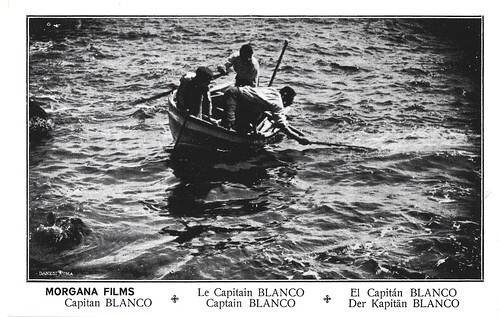
Italian postcard by Ed. Danesi, Roma. Scene from Capitan Blanco / Il Capitan Blanco (Nino Martoglio, Roberto Danesi, 1914).

Italian postcard by Ed. Danesi, Roma. Scene from Capitan Blanco / Il Capitan Blanco (Nino Martoglio, Roberto Danesi, 1914).
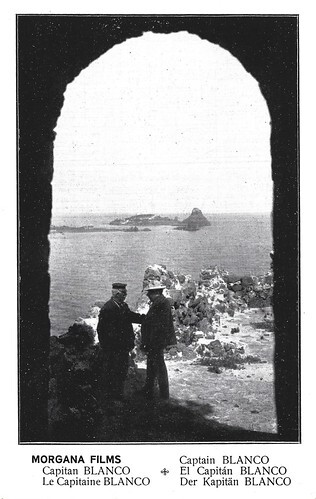
Italian postcard by Ed. Danesi, Roma. Scene from Capitan Blanco / Il Capitan Blanco (Nino Martoglio, Roberto Danesi, 1914). The rocks in the back are the so-called Faraglioni of Aci Trezza (Sicily).

Italian postcard by Ed. Danesi, Roma. Scene from Capitan Blanco / Il Capitan Blanco (Nino Martoglio, Roberto Danesi, 1914).
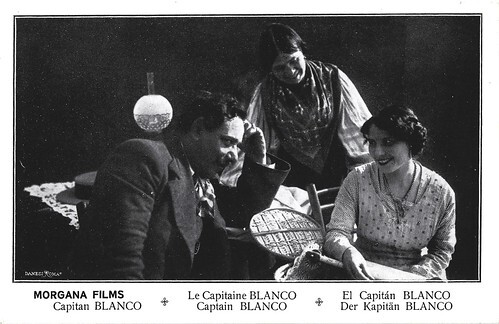
Italian postcard by Ed. Danesi, Roma. Scene from Capitan Blanco / Il Capitan Blanco (Nino Martoglio, Roberto Danesi, 1914).
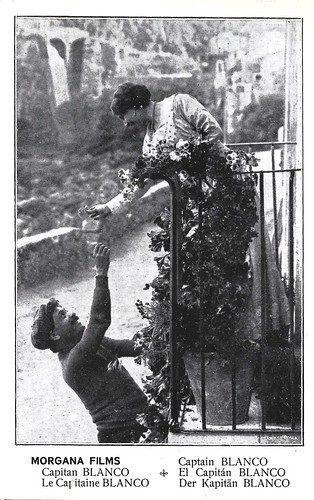
Italian postcard by Ed. Danesi, Roma. Scene from Capitan Blanco / Il Capitan Blanco (Nino Martoglio, Roberto Danesi, 1914).
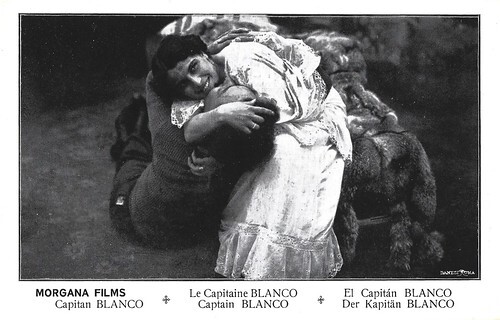
Italian postcard by Ed. Danesi, Roma. Scene from Capitan Blanco / Il Capitan Blanco (Nino Martoglio, Roberto Danesi, 1914).
Who is who?
Roberto Danesi (1882-1914), who published these postcards, was an Italian film producer, director, screenwriter, operator and set photographer, based in Rome. In 1912, he debuted with a series of films borrowing actors from the Turin company Savoia. In 1913, he was a camera operator and set photographer at Cines. That same year, he became manager of Savoia's Roman studio, while he was also active as theatre director. In addition to dramas, Danesi also did science fiction, and in hindsight, actor Gian Paolo Rosmino praised his mastery of special effects. Nino Oxilia was his assistant for some films at Savoia and learned the trade from him. At the end of 1913, Danesi, with Archita Valente, directed the Napoleonic historical film I cento giorni di Napoleone / The Hundred Days of Napoleon (Roberto Danesi, Archita Valente, 1914) for Vera Film. In 1914, he shot films at his studio on behalf of Milano Films. He then left Savoia and founded with Nino Martoglio the company Morgana Films, which used the Roman studio of Savoia. With Martoglio, Danesi collaborated on two important, lost films: Capitan Blanco and Sperduti nel buio. After an illness, Danesi died in 1914. He was only 32. It was also the end for Morgana Films.
Giovanni Grasso (1873-1930) is considered the best Sicilian tragic actor and one of the best in Italy. He had a limited but very important career in Italian silent cinema. He is best known for two lost films, Nino Martoglio's Capitan Blanco (1914) and Sperduti nel buio (1914). In 1919-1926, Grasso performed in some nine films, including L’ospite sconosciuta / Malafemmina (1923) with Pina Menichelli and Cavalleria rusticana (1924) with Tina Xeo and Livio Pavanelli .
Totò Majorana (1874–1944), originally Salvatore Maria Majorana, was famous as Giovanni Grasso 's co-star on stage, in and outside of Italy. After acting in some films at Savoia in 1913, he went to Rome to act opposite Grasso in two famous films in realist style, Capitan Blanco (Nino Martoglio, 1914) and Sperduti nel buio (Nino Martoglio, 1914). Between 1919 and 1923, he acted in a large string of films, often starring Nerio Bernardi and directed by Mario Caserini.
Virginia Balistrieri, aka Virginia Balestrieri (1888-1960), was an Italian stage and screen actress. After her parts opposite Giovanni Grasso in the silent films Capitan Blanco (Nino Martoglio, 1914) and Sperduti nel buio (Nino Martoglio, 1914), she played many supporting parts in Italian sound cinema of the late 1940s and 1950s. She was married to a nephew of Grasso, called Giovanni Grasso jr. (1888-1963).
And how did the critics respond to Capitan Blanco / Il Capitan Blanco? Pier da Castello in the Turinese trade journal La Vita Cinematografica was quite critical. He missed Grasso's potent voice and thought that his masterful Sicilian exuberance could have been exploited better. He also considered the Arabian adventures unnecessary, and he thought the plot wasn't very special or subtle. Yet, Keraban wrote in the Neapolitan journal La Cine-Fono that possible flaws, e.g. the rather rigid plot, were unimportant, compared to the tour-de-force performance of Grasso, Balistrieri's acting, and the direction by Martoglio. He admired the great outdoors scenery, the liveliness, the massive crowds of farmers and fishermen, the Arabs and 'predators', etc. Indeed, looking at our cards, it is clear that the use of real locations and local extras was an important asset of this film. It is clear why critics of the 1940s referred to Martoglio's films when they were looking for predecessors of Italian Neorealism.
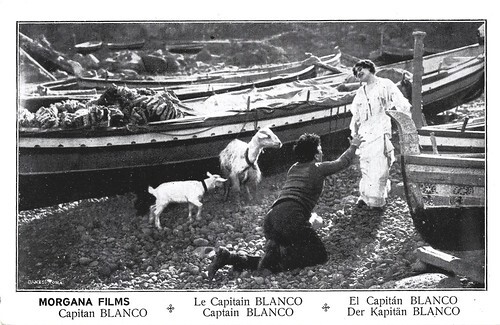
Italian postcard by Ed. Danesi, Roma. Scene from Capitan Blanco / Il Capitan Blanco (Nino Martoglio, Roberto Danesi, 1914).
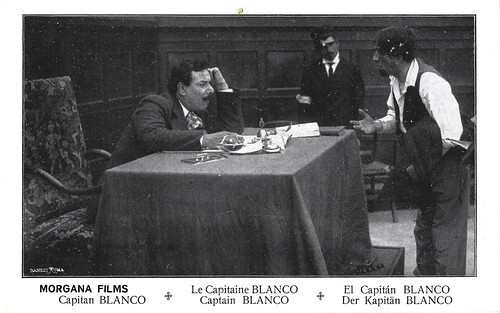
Italian postcard by Ed. Danesi, Roma. Scene from Capitan Blanco / Il Capitan Blanco (Nino Martoglio, Roberto Danesi, 1914).

Italian postcard by Ed. Danesi, Roma. Scene from Capitan Blanco / Il Capitan Blanco (Nino Martoglio, Roberto Danesi, 1914).
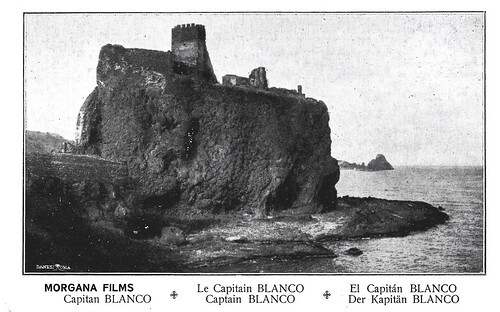
Italian postcard by Ed. Danesi, Roma. Scene from Capitan Blanco / Il Capitan Blanco (Nino Martoglio, Roberto Danesi, 1914). The castle at Aci Castello in Sicily, where the plot evolves too.
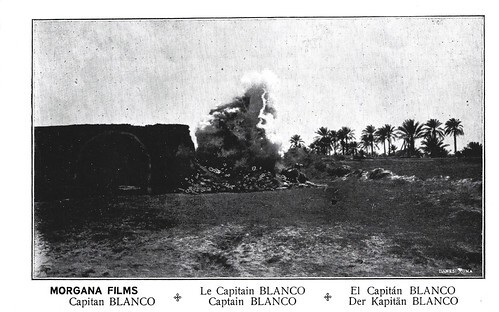
Italian postcard by Ed. Danesi, Roma. Scene from Capitan Blanco / Il Capitan Blanco (Nino Martoglio, Roberto Danesi, 1914).
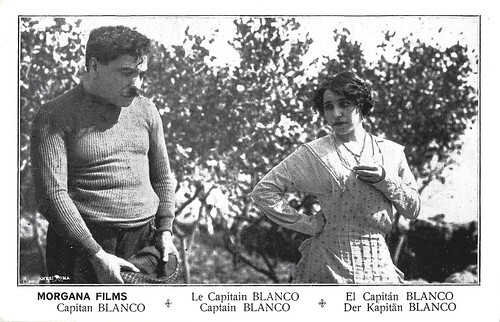
Italian postcard by Ed. Danesi, Roma. Scene from Capitan Blanco / Il Capitan Blanco (Nino Martoglio, Roberto Danesi, 1914).
Sources: Vittorio Martinelli (Il cinema muto italiano 1914, Vol. 1), Wikipedia (Italian) and IMDb. Congratulations, Ivo!

Italian postcard by Ed. Danesi, Roma. Giovanni Grasso in Capitan Blanco / Il Capitan Blanco (Nino Martoglio, Roberto Danesi, 1914).

Italian postcard by Ed. Danesi, Roma. Scene from Capitan Blanco / Il Capitan Blanco (Nino Martoglio, Roberto Danesi, 1914).

Italian postcard by Ed. Danesi, Roma. Giovanni Grasso in Capitan Blanco / Il Capitan Blanco (Nino Martoglio, Roberto Danesi, 1914).

Italian postcard by Ed. Danesi, Roma. Scene from Capitan Blanco / Il Capitan Blanco (Nino Martoglio, Roberto Danesi, 1914).

Italian postcard by Ed. Danesi, Roma. Giovanni Grasso in Capitan Blanco / Il Capitan Blanco (Nino Martoglio, Roberto Danesi, 1914).
A mighty sea wolf
For the shooting of Capitan Blanco / Il Capitan Blanco (Nino Martoglio, Roberto Danesi, 1914), production company Morgana Film used the Roman studios of the company Savoia for interiors. The exteriors were first shot in the newly conquered Tripolitania, a part of Libya and Italian since 1912, so the crew had to be guarded while working there. Later shots were taken in Sicily at Aci Castello, Aci Trezza, and Catania. The cinematography was done by Danesi.
The three leading actors were the Sicilians Giovanni Grasso as Capitan Blanco, Virginia Balistrieri in her film debut as Marta and Totò Majorana as Mauro. By then, Grasso was one of the most acclaimed Italian stage actors. The film was first released in Rome on 24 May 1914.
Giovanni Grasso is Matteo Blanco, a mighty sea wolf, known as 'Capitan Blanco'. Blanco is a man of great courage, who has left his village, Aci Castello, some thirty years ago in search of adventures. After many narrow escapes in Africa, he returns a rich man to his village.
There, old Zia Betta matches him with the local young beauty, the flirtatious Marta, who has had many lovers. One of her lovers, Mauro, is desperate and wants to throw himself off the local castle, but Blanco saves him. After their marriage, Marta doesn't give up flirting and tries to lure Mauro, but he is faithful to his saviour.
She then takes a customs officer as a lover, but Blanco is warned about this. The fierce husband takes revenge by blowing up the castle where the lovers secretly meet. The customs officer is killed, but Marta survives. One year later, Blanco and Marta make peace, but he takes her away, far from the village.

Italian postcard by Ed. Danesi, Roma. Scene from Capitan Blanco / Il Capitan Blanco (Nino Martoglio, Roberto Danesi, 1914).

Italian postcard by Ed. Danesi, Roma. Scene from Capitan Blanco / Il Capitan Blanco (Nino Martoglio, Roberto Danesi, 1914).

Italian postcard by Ed. Danesi, Roma. Scene from Capitan Blanco / Il Capitan Blanco (Nino Martoglio, Roberto Danesi, 1914). The rocks in the back are the so-called Faraglioni of Aci Trezza (Sicily).

Italian postcard by Ed. Danesi, Roma. Scene from Capitan Blanco / Il Capitan Blanco (Nino Martoglio, Roberto Danesi, 1914).

Italian postcard by Ed. Danesi, Roma. Scene from Capitan Blanco / Il Capitan Blanco (Nino Martoglio, Roberto Danesi, 1914).

Italian postcard by Ed. Danesi, Roma. Scene from Capitan Blanco / Il Capitan Blanco (Nino Martoglio, Roberto Danesi, 1914).

Italian postcard by Ed. Danesi, Roma. Scene from Capitan Blanco / Il Capitan Blanco (Nino Martoglio, Roberto Danesi, 1914).
Who is who?
Roberto Danesi (1882-1914), who published these postcards, was an Italian film producer, director, screenwriter, operator and set photographer, based in Rome. In 1912, he debuted with a series of films borrowing actors from the Turin company Savoia. In 1913, he was a camera operator and set photographer at Cines. That same year, he became manager of Savoia's Roman studio, while he was also active as theatre director. In addition to dramas, Danesi also did science fiction, and in hindsight, actor Gian Paolo Rosmino praised his mastery of special effects. Nino Oxilia was his assistant for some films at Savoia and learned the trade from him. At the end of 1913, Danesi, with Archita Valente, directed the Napoleonic historical film I cento giorni di Napoleone / The Hundred Days of Napoleon (Roberto Danesi, Archita Valente, 1914) for Vera Film. In 1914, he shot films at his studio on behalf of Milano Films. He then left Savoia and founded with Nino Martoglio the company Morgana Films, which used the Roman studio of Savoia. With Martoglio, Danesi collaborated on two important, lost films: Capitan Blanco and Sperduti nel buio. After an illness, Danesi died in 1914. He was only 32. It was also the end for Morgana Films.
Giovanni Grasso (1873-1930) is considered the best Sicilian tragic actor and one of the best in Italy. He had a limited but very important career in Italian silent cinema. He is best known for two lost films, Nino Martoglio's Capitan Blanco (1914) and Sperduti nel buio (1914). In 1919-1926, Grasso performed in some nine films, including L’ospite sconosciuta / Malafemmina (1923) with Pina Menichelli and Cavalleria rusticana (1924) with Tina Xeo and Livio Pavanelli .
Totò Majorana (1874–1944), originally Salvatore Maria Majorana, was famous as Giovanni Grasso 's co-star on stage, in and outside of Italy. After acting in some films at Savoia in 1913, he went to Rome to act opposite Grasso in two famous films in realist style, Capitan Blanco (Nino Martoglio, 1914) and Sperduti nel buio (Nino Martoglio, 1914). Between 1919 and 1923, he acted in a large string of films, often starring Nerio Bernardi and directed by Mario Caserini.
Virginia Balistrieri, aka Virginia Balestrieri (1888-1960), was an Italian stage and screen actress. After her parts opposite Giovanni Grasso in the silent films Capitan Blanco (Nino Martoglio, 1914) and Sperduti nel buio (Nino Martoglio, 1914), she played many supporting parts in Italian sound cinema of the late 1940s and 1950s. She was married to a nephew of Grasso, called Giovanni Grasso jr. (1888-1963).
And how did the critics respond to Capitan Blanco / Il Capitan Blanco? Pier da Castello in the Turinese trade journal La Vita Cinematografica was quite critical. He missed Grasso's potent voice and thought that his masterful Sicilian exuberance could have been exploited better. He also considered the Arabian adventures unnecessary, and he thought the plot wasn't very special or subtle. Yet, Keraban wrote in the Neapolitan journal La Cine-Fono that possible flaws, e.g. the rather rigid plot, were unimportant, compared to the tour-de-force performance of Grasso, Balistrieri's acting, and the direction by Martoglio. He admired the great outdoors scenery, the liveliness, the massive crowds of farmers and fishermen, the Arabs and 'predators', etc. Indeed, looking at our cards, it is clear that the use of real locations and local extras was an important asset of this film. It is clear why critics of the 1940s referred to Martoglio's films when they were looking for predecessors of Italian Neorealism.

Italian postcard by Ed. Danesi, Roma. Scene from Capitan Blanco / Il Capitan Blanco (Nino Martoglio, Roberto Danesi, 1914).

Italian postcard by Ed. Danesi, Roma. Scene from Capitan Blanco / Il Capitan Blanco (Nino Martoglio, Roberto Danesi, 1914).

Italian postcard by Ed. Danesi, Roma. Scene from Capitan Blanco / Il Capitan Blanco (Nino Martoglio, Roberto Danesi, 1914).

Italian postcard by Ed. Danesi, Roma. Scene from Capitan Blanco / Il Capitan Blanco (Nino Martoglio, Roberto Danesi, 1914). The castle at Aci Castello in Sicily, where the plot evolves too.

Italian postcard by Ed. Danesi, Roma. Scene from Capitan Blanco / Il Capitan Blanco (Nino Martoglio, Roberto Danesi, 1914).

Italian postcard by Ed. Danesi, Roma. Scene from Capitan Blanco / Il Capitan Blanco (Nino Martoglio, Roberto Danesi, 1914).
Sources: Vittorio Martinelli (Il cinema muto italiano 1914, Vol. 1), Wikipedia (Italian) and IMDb. Congratulations, Ivo!
Published on August 29, 2025 22:00
Paul van Yperen's Blog
- Paul van Yperen's profile
- 13 followers
Paul van Yperen isn't a Goodreads Author
(yet),
but they
do have a blog,
so here are some recent posts imported from
their feed.



